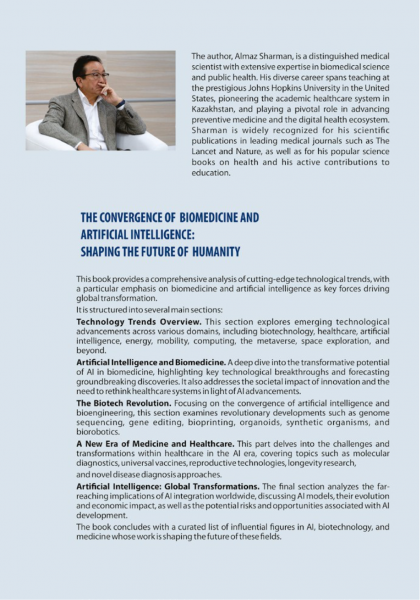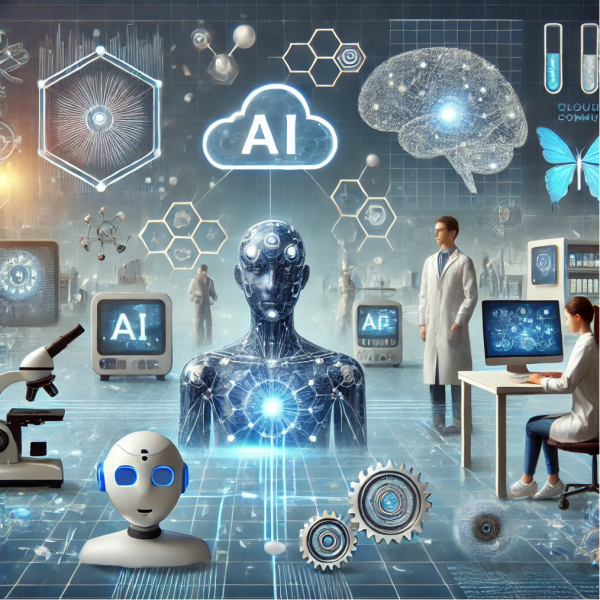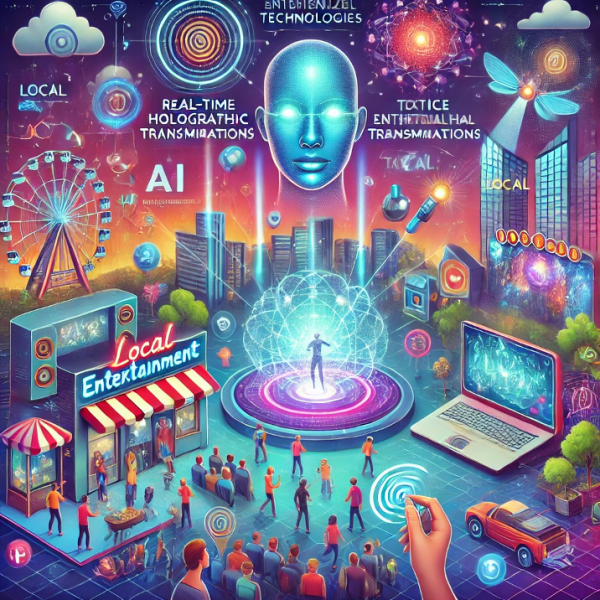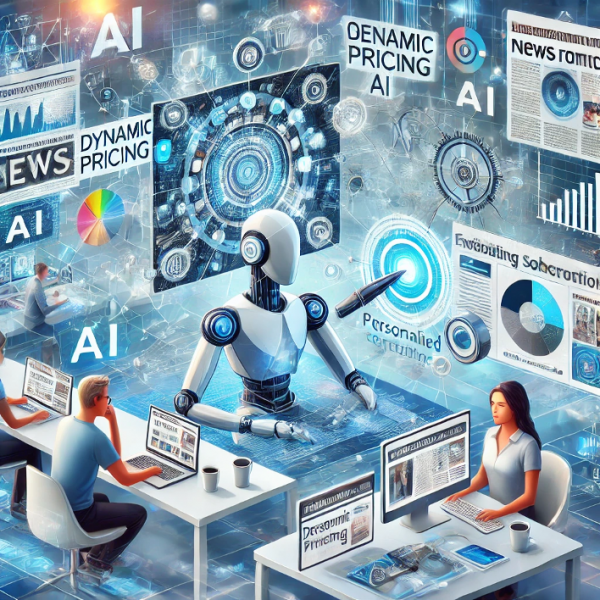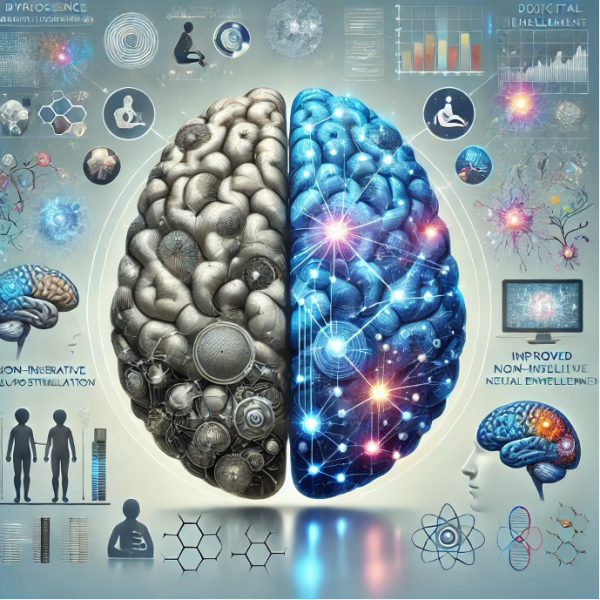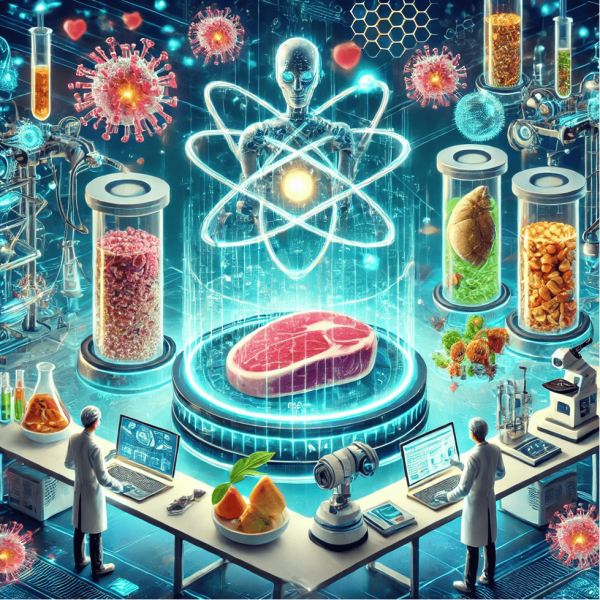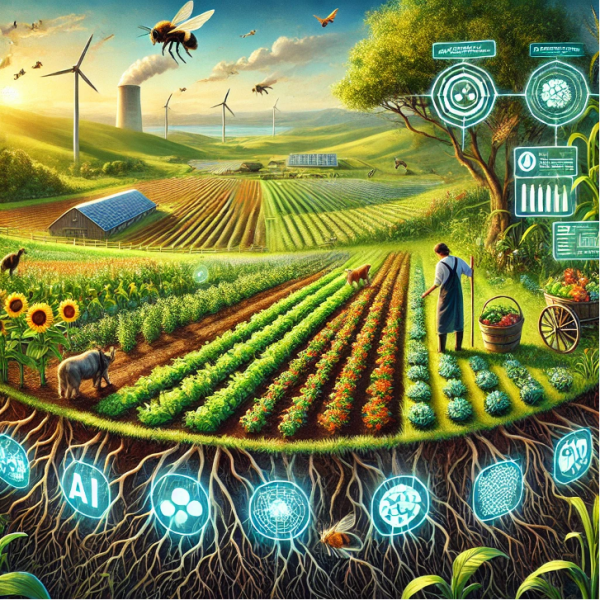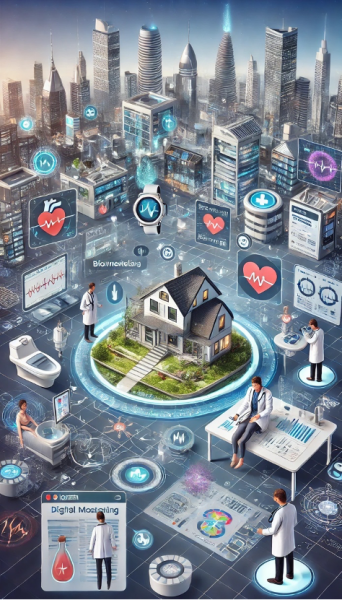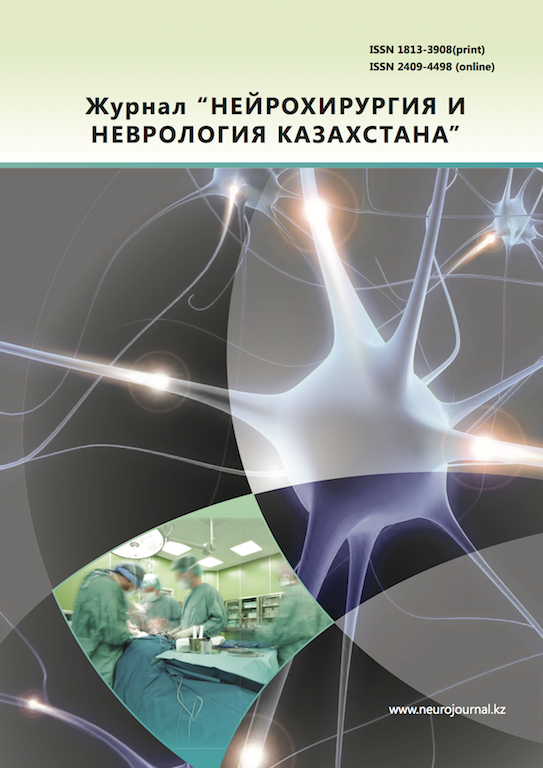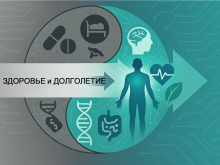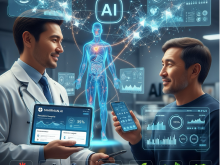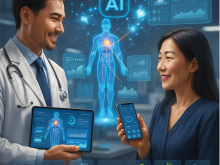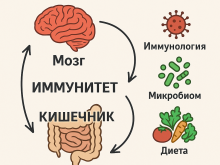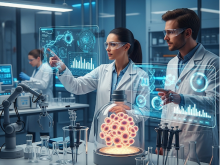THE CONVERGENCE OF BIOMEDICINE AND ARTIFICIAL INTELLIGENCE
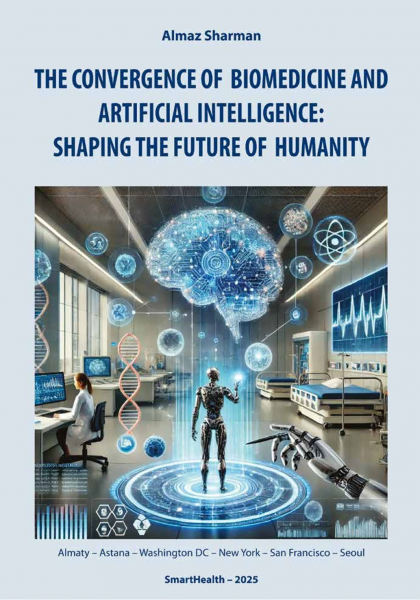
This publication by Professor of Medicine Almaz Sharman is dedicated to the key role of biomedicine and artificial intelligence (AI) in revolutionary changes affecting the economy, healthcare, and global development. Special attention is given to the potential of AI in overcoming technological barriers, accelerating scientific progress, and improving quality of life, as well as the need for strategic investments to adapt to new challenges.
The author focuses on the key drivers of these changes: artificial intelligence, biomedicine, and cutting-edge gadgets. The synthesis of these technologies promises to radically change all spheres of life, from medicine and finance to social interactionsand our perception of reality. The author warns that these transformations carry both enormous opportunities and serious risks associated with inequality, job losses, and new ethical dilemmas. The book offers a deep analysis of ongoing processes and allows the reader to better understand the modern world and its future. The author calls for responsible and proactive policies in this area, aimed at mitigating negative consequences and maximizing new opportunities.
The book will be of interest to a wide range of readers interested in modern technologies, economics, and the future of humanity.
The illustrations in this book were generated by the DALL-E neural network.
ISBN 978-601-305-646-3
©Almaz Sharman 2025 ©SmartHealth 2025
Almaty – Astana – Washington DC – New York – San Francisco - Seoul LTD «SmartHealth», 2025
FROM THE AUTHOR
Dear Reader,
The world is on the brink of fundamental changes that could redefine the very concept of human existence. The revolution in biomedicine and healthcare, driven by artificial intelligence (AI) and advanced biotechnology, promises not only to liberate humanity from the burden of disease but also to open up new horizons of development and self-realization.
These changes, so radical for most, may seem like a natural progression for a small community of researchers and futurists who have foreseen the potential of AI. However, for the rest of theworld, they will be truly revolutionary, requiring a deep rethinking of the social, economic, and ethical foundations of society.
Standing on the threshold of this new era, it is important not only to admire the possibilities that are opening up but also to carefully prepare for the challenges that it brings. Ensuringe quitable access to these technologies and minimizing potential negative consequences will be keytasks for society in the coming years.
Let me present a comprehensive overview of technological and biomedical breakthroughs driven by AI, bioengineering, and medical technologies. Undoubtedly, AI will have a tremendous impact on virtually all aspects of human life, including economic development and poverty reduction, employment, new meanings of work and creativity, governance, and theworld order. With 40 years of experience in the field of biomedicine and healthcare, I naturally decided to devote my analysis to the global transformations caused by thedevelopment of AI, in the context of innovations in the biotechnology industry, as well as in the ecosystem of medicine and healthcare.
I hope that this publication will be a useful tool for successful navigation in the rapidly changing world of technology, where artificial intelligence and biotechnology play a key role.These areas are driving revolutionary changes affecting the economy, healthcare, and global development.
AI contributes to the automation of complex processes, opening up new horizons in improving productivity and making strategically important decisions. In turn, biotechnology has a groundbreaking impact on medicine and agriculture, contributing to improved quality of life and addressing global problems such as food security and the fight against diseases.
The combination of AI and biotechnology creates a synergy that allows for the development of innovative solutions that can fundamentally change the world. Awareness and understanding of these processes is becoming not just an advantage but a necessity for effective adaptation and successful development in the future. It is important to remember that the decisions made today will have a fateful impact on shaping the future of humanity and determining its resilience in the face of the challenges of a new era.
Almaz Sharman, Professor of Medicine Medicine
The world is on the verge of an unprecedented period of growth, characterized by a sustained increase in demand and record-high prices for goods and assets. This multi-year, and possibly multi-decade, cycle is the result of deep structural changes in the global economic system.
We are witnessing a revolutionary wave of innovation capable of transforming the very essence of human existence. Its influence extends from the intricate mechanisms of global supply chains to the subtleties of everyday life, from the corridors of power in geopolitics to unspoken social norms.
At the forefront of these massive transformations is a triumvirate of technologies: tech giants with their three key developments: artificial intelligence, biomedicine, and an ecosystem of interconnected wearable devices.
The synergy of these macro-technological directions will fundamentally change our interaction with the world around us - from communicating with medical specialists to relationships with pets, from banking operations to the perception of our own bodies.
Every innovation, be it augmented reality (AR/VR/XR), autonomous transport, or low-orbit satellites, contributes to this wave of global change. The consequences of these processes areinevitable and obvious. In the course of this technological transformation, both leaders capable of managing this epochal transition and those who will be struck by its destructiveconsequences will be determined.
The observed trends cover not only evolutionary improvements in existing technologies butalso breakthrough developments on the cutting edge of science and technology. New centers ofinnovation and risk will emerge, capable of transforming entire industries.
So, the world is changing at an unprecedented rate, and this technological process is only gaining momentum. We are on the threshold of an era that promises to radically change our understanding of economics, society, and ourselves.
FUTURE TRENDS IN TECHNOLOGICAL DEVELOPMENT
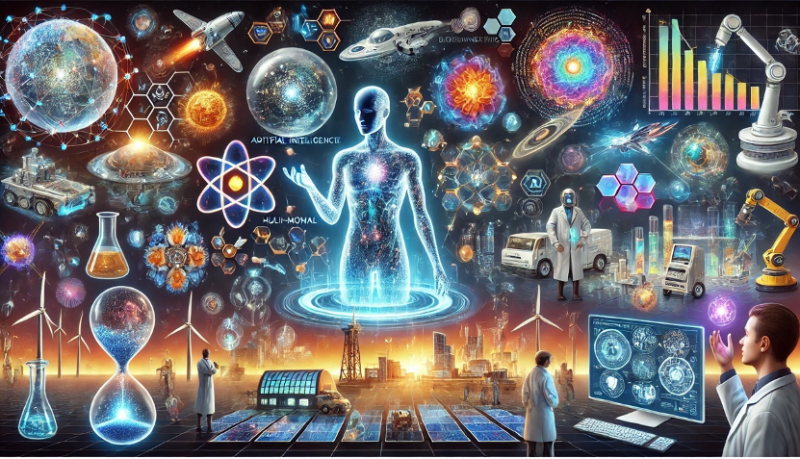
The technological revolution is encompassing virtually all spheres of human activity. The convergence of various fields of science and technology is creating a synergistic effect, opening up unprecedented opportunities for humanity while simultaneously posing new challenges.
Below are the main projected trends in the development of such technological areas as biotechnology, artificial intelligence, energy and climate, transport and robotics,virtual reality and space, as well as traditional industries such as finance, sports, logistics, hospitality, and the entertainment industry. All these spheres are
undergoing deep transformation under the influence of new technologies, from blockchain to immersivetechnologies.
This technological breakthrough carries enormous potential for improving the quality of life, solving globalproblems, and opening up new horizons of human possibilities. However, it also poses serious ethical,social, and economic challenges. The key to successfully mastering these technologies will be our abilityto effectively manage their implementation, ensuring a balance between innovation and responsibility,between progress and preserving human values..
Biotechnology And Bioengineering: On The Threshold Of Revolutionary Discoveries
Recent advances have accelerated the convergence of biology, information systems and advanced platforms, while public attention is focused on generative AI. However, the focus will soon shift to generative biology, where AI models will open up opportunities to create:
- New molecules
- Innovative drugs
- Revolutionary materials
- Artificial living organisms
Despite the enormous potential of biotechnology to transform our world, its implementation requirescareful preparation and effective management.
For more information on the expected changes in this field, please read the second part of this book, «Biotech Revolution: Convergence of Artificial Intelligence and Bioengineering».
Healthcare and Medicine:
Blurring the Lines Between Digital and Biological
The merging of the digital and biological worlds opens up unprecedented possibilities in medicine:
- Creating «smart» cells inside the body that can produce drugs in response to external stimuli
- The emergence of new methods of treatment and diagnostics
However, at the same time, existential threats such as cyberbiomass are emerging that we do not even knowabout yet. Both areas have the potential to radically transform the pharmaceutical and medical industries.
For more information on upcoming advances in this field, please read the third part of this book, «On theThreshold of a New Era of Medicine and Healthcare.»
Artificial Intelligence
While the hype around artificial intelligence (AI) continues to grow, a critical moment has arrived for carefulpreparation for the coming changes.
AI represents a revolutionary technology with a wide range of applications, capable of transforming entire economic systems and radically changing the face of society. The AI ecosystem is developing at a rapid pace,encompassing various directions:
- МульMultimodal AI models
- Self-learning agents
- Wearable devices with built-in AI assistants
Despite the promising prospects of AI in transforming our world, the latest trends point to unprecedented risks.This emphasizes the urgent need for:
- Careful preparation for the implementation of AI technologies
- Development of effective management mechanisms
- Achieving a balance of interests of all stakeholders
Thus, timely and comprehensive preparation for the AI era becomes a key factor for the successfuladaptation of society to the upcoming technological changes.
For more information on the expected changes in this field, please read the fourth part of this book, «Artificial Intelligence: Global Transformations and Future Challenges».
THE FUTURE OF ENERGY AND CLIMATE:
SYNERGY OF INNOVATIONS AND PROVEN TECHNOLOGIES

In the face of escalating climate change impacts, governments worldwide are increasingly turning to radical technologicalsolutions:
Solar Geoengineering
This controversial approach involves reflecting sunlight back into space to cool the Earth. Proposed methods include:
- Stratospheric aerosol injection
- Marine cloud brightening
- Space-based reflectors
While potentially effective, these technologies raise significant ethical and environmental concerns.
Ocean Chemical Manipulation
Also known as ocean fertilization or alkalinization, this involves:
- Adding iron or other nutrients to stimulate phytoplankton growth
- Increasing ocean alkalinity to enhance CO2 absorption
These methods aim to boost the ocean’s capacity to absorb atmospheric carbon dioxide.
Dome Cities
This futuristic concept involves creating enclosed, climate-controlled urban environments. Benefitsinclude:
- Protection from extreme weather events
- Optimized resource management
- Reduced environmental impact
However, challenges include high costs and potential social implications.
Simultaneously, significant progress has been made in developing infrastructure for renewable energy:
Smart Grids
These advanced power networks use digital technology to:
- Efficiently distribute electricity
- Integrate renewable energy sources
- Respond to fluctuations in energy demand
- Enable two-way communication between utilities and consumers
Energy Storage Systems
Crucial for managing intermittent renewable energy sources, these include:
- Advanced battery technologies (e.g., lithium-ion, flow batteries)
- Pumped hydro storage
- Compressed air energy storage
- Thermal energy storage
These systems help balance supply and demand, improving grid stability.
Carbon Footprint Tracking Technologies
These tools enable individuals and organizations to monitor and reduce their carbon emissions:
- IoT-enabled sensors for real-time emissions monitoring
- AI-powered analytics for identifying emission reduction opportunities
- Blockchain-based carbon credit trading platforms
By providing accurate data, these technologies support informed decision-making and policy development.
The synergy between these radical climate interventions and advancements in renewable energy infrastructure represents a multi-faceted approach to addressing climate change. While some technologiesremain controversial, their development underscores the urgency of the climate crisis and the need for innovative solutions.
THE FUTURE OF MOBILITY, ROBOTS, AND DRONES:
ADDRESSING THE CHALLENGES OF ELECTRIFICATION AND AUTONOMY
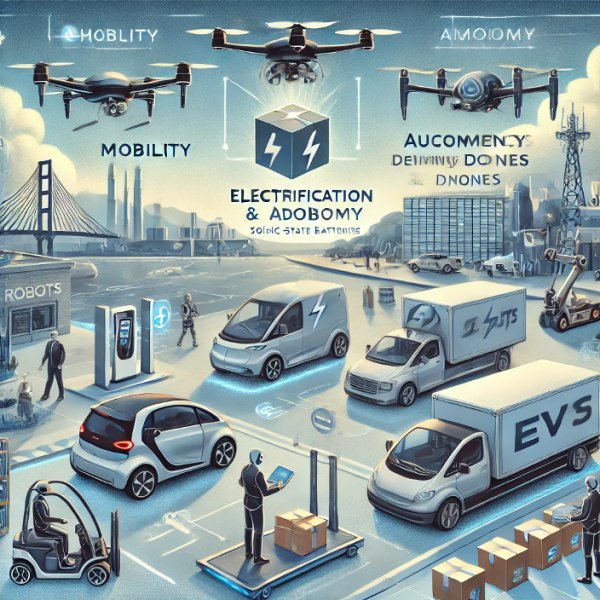
The transportation and robotics industries are undergoing a significant transformation:
Consumer Adaptation to New Technologies
Consumers are gradually becoming accustomed to electric vehicles(EVs) and semi-autonomous transportation systems. This shiftrepresents a major change in how people interact with and perceive personal and public transportation. The adoption of EVs is driven by factors such as environmental concerns, government incentives, and improving technology. However, challenges remain, including range anxiety and the need for more extensive charging infrastructure.
Advancements in Battery Technology
Significant progress is being made in battery technology, extending the operational time of cars, robots, anddrones. Key developments include:
- Solid-state batteries: These promise higher energy density, faster charging times, and improvedsafety compared to traditional lithium-ion batteries.
- Silicon nanoparticle electrodes: This innovation allows for much faster charging times, potentially making EVs as quick to «refuel» as conventional vehicles.
- Improved energy density: Ongoing research aims to increase the range of EVs and the operationaltime of robots and drones.
These advancements are crucial for overcoming current limitations in EV adoption and expanding the capabilitiesof autonomous systems.
Rise of Autonomous Machines
The growth of autonomous machines signals a future where they will increasingly complement or replace humanlabor. This trend is evident across various sectors:
- Transportation: Autonomous vehicles are expected to significantly impact jobs in trucking, taxi services, and public transportation.
- Logistics: Autonomous robots and drones are being developed for warehouse operations andlast-mile delivery.
- Manufacturing: Robotic systems are becoming more sophisticated, capable of handlingcomplex tasks previously done by humans.
Transition to a More Efficient but Controlled Work Environment
These changes mark a shift towards a more efficient but increasingly monitored and controlled workenvironment. Key aspects include:
- ТIncreased productivity: Autonomous systems can operate continuously and with high precision,potentially improving overall efficiency.
- Job displacement: While new jobs will be created in fields like AI, robotics, and data analysis,many traditional roles may be at risk.
- Enhanced safety: Autonomous systems can reduce human error in dangerous or repetitivetasks.
- Privacy and surveillance concerns: The increased use of AI and autonomous systems raisesquestions about data collection and worker monitoring.
This transition presents both opportunities and challenges, requiring careful consideration of its societaland economic impacts. As we move towards this automated future, it will be crucial to balancetechnological advancement with human-centered policies and ethical considerations.
THE FUTURE OF COMPUTING TECHNOLOGIES:
AI AS A CATALYST FOR CHANGE
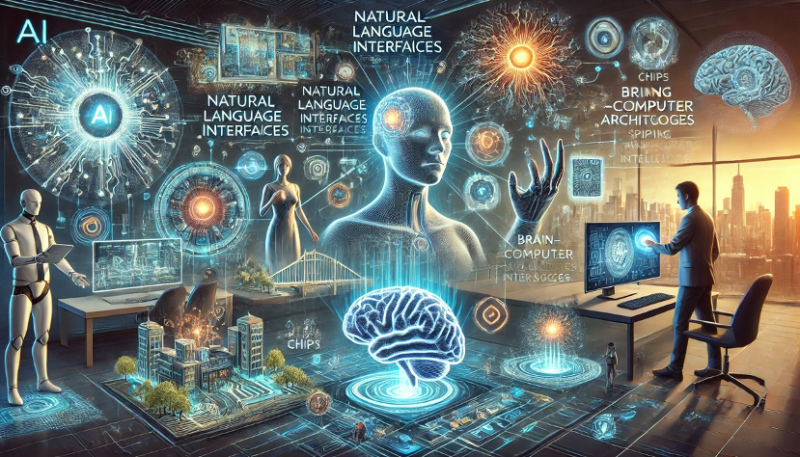
Artificial intelligence is radically transforming human-computer interaction in several key ways:.
Transformation of Form Factor Capabilities
AI is enabling new form factors and interaction modalities beyond traditional keyboards and screens:
- Natural language interfaces allow voice-based interaction with devices and systems
- Computer vision enables gesture recognition and facial detection for more intuitive controls
- Brain-computer interfaces are being developed to allow direct neural control of devices
- Augmented and mixed reality integrates digital information seamlessly into the physical world
These AI-powered interfaces make technology more accessible and natural to use across a wider range of contextsand user abilities.
Brain-Inspired Energy-Efficient Architectures
СResearchers are developing AI hardware inspired by the energy efficiency of the human brain:
- Neuromorphic chips like Intel’s Loihi mimic the brain’s neural structure and spike-basedcommunication
- These brain-inspired designs can be orders of magnitude more energy efficient than traditionalprocessors
- Spiking neural networks encode information in discrete, time-dependent spikes rather thancontinuous signals
- This approach enables complex computations with minimal energy consumption
- Synaptic plasticity allows systems to adapt and learn over time, like biological brains
These innovations could dramatically reduce the energy footprint of AI systems while increasing theircapabilities.
Simplification of Human-Machine Communication
AI is making human-machine interaction more intuitive and natural:
- Natural language processing enables conversational interfaces via text or speech
- Machine learning models can understand context and intent to provide more relevant responses
- AI assistants can handle complex queries and tasks through multi-turn dialogues
- Emotion recognition allows systems to respond more appropriately to user states
- Personalization tailors interactions to individual user preferences and behaviors
This simplification lowers barriers to technology adoption and enables more fluid integration of AI into daily life.
As these technologies mature, computing is becoming less about manipulating devices and more about seamless integration into human activities and environments. AI is transforming computers from tools we explicitly operate to intelligent assistants that augment our capabilities in more organic andpeople-centric ways.
THE METAVERSE AND VIRTUAL REALITY:
ON THE PATH TO TECHNOLOGY MATURITY

The development of augmented and virtual reality technologies indicates a possible turning point in the industry, with several key trends emerging:
Apple’s Vision Pro: A Landmark in AR/VR Development
Apple’s introduction of the Vision Pro headset marks a significant milestone in the evolution of augmentedand virtual reality technologies:
- The device uses advanced AI to seamlessly overlay digital elements onto the real world, bridgingthe gap between fantasy and practical application.
- It features high-resolution displays totaling 23 million pixels, providing an unprecedented level ofvisual fidelity.
- The Vision Pro incorporates eye tracking, hand gestures, and voice commands for intuitive control, eliminating the need for external controllers.
This advancement signals a shift from conceptual AR/VR ideas to tangible, consumer-ready products thatcan integrate into daily life.
Enhancing Virtual Experiences
The industry is rapidly developing additional features to improve and expand virtual experiences:
- Multi-sensory technology, including haptic gloves and devices that stimulate senses like smell, are being integrated to create more immersive experiences.
- Advancements in spatial computing allow for more accurate overlay of virtual objects onto thephysical world, enhancing the realism of AR applications.
- The development of digital personas and life-sized video conferencing capabilities is revolutionizing remote communication and collaboration.
These enhancements are making virtual experiences more engaging, realistic, and applicable to a wider range ofuse cases.
Synergy of AI and Extended Reality (XR)
The integration of artificial intelligence with extended reality technologies is creating powerful newcapabilities:
- AI is being used to generate procedural environments, create intelligent non-playercharacters, and design entire virtual worlds autonomously.
- Machine learning algorithms are enabling more personalized and responsive virtualenvironments that can adapt to user behavior.
- AI-powered analytics in VR/AR systems are providing deeper insights into user interactions, enabling more effective training, education, and entertainment applications.
This synergy is pushing the boundaries of what’s possible in virtual and augmented reality, opening up newpossibilities for innovation across various industries.
Despite these advancements, the industry still faces challenges, particularly the high cost of devices likethe Apple Vision Pro, which is priced at more than
$3,500. However, the rapid pace of innovation and increasing investment in AR/ VR technologies suggest thatthe industry may be approaching a long-awaited breakthrough moment. As costs decrease and capabilities increase, we can expect to see wider adoption and more diverse applications of these technologies in the nearfuture.
A NEW ERA OF SPACE EXPLORATION
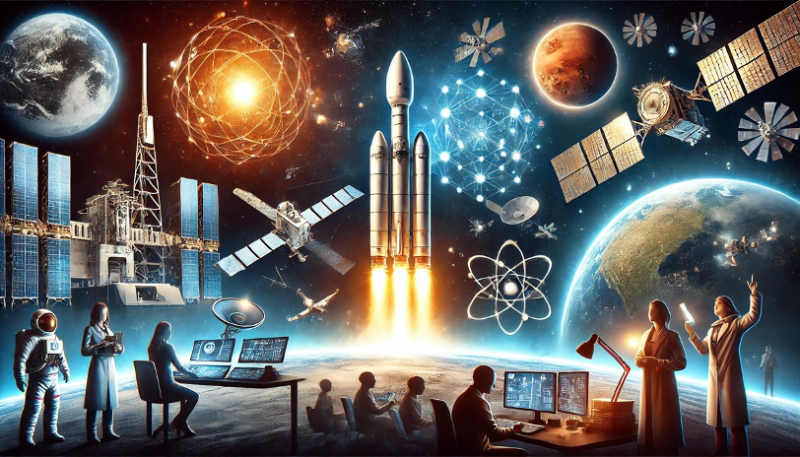
The space industry is entering a new epoch characterized by several transformative trends.
Democratization of Space Access
The space sector is witnessing increased participation from a wider range of small countries and private companies:
- Emerging space programs: Countries like UAE,India, and Luxembourg are developing robust space programs, challenging the traditional dominance of major space powers.
- Private sector revolution: Companies like SpaceX, Blue Origin, and Rocket Lab are disrupting the industry with innovative technologies and business models.
- Satellite constellations: Firms such as Starlink and OneWeb are deploying vast networks of smallsatellites, democratizing global internet access.
This diversification is driving innovation, competition, and new approaches to space exploration andutilization.
Reduction in Space Access Costs
The cost of reaching space has decreased significantly due to several factors:
- Reusable rocket technology: SpaceX’s Falcon 9 and similar systems have dramatically reducedlaunch costs.
- Miniaturization: CubeSats and other small satellite technologies have made space missionsmore affordable for smaller entities.
- Advanced manufacturing: 3D printing and other modern manufacturing techniques are loweringthe cost of spacecraft components.
- Increased launch frequency: More frequent launches are helping to amortize fixed costsacross multiple missions.
These cost reductions are opening up space to a broader range of activities and participants.
New Opportunities for Microgravity Research
The expansion of space access is creating new avenues for scientific research in microgravity environments:
- Biological studies: Research on cell behavior, protein crystallization, and plant growth in space isadvancing medical and agricultural sciences.
- Materials science: Microgravity allows for the creation of unique alloys and crystals impossible to produce on Earth.
- Fundamental physics: Space-based experiments are probing the nature of gravity, dark matter,and other fundamental aspects of the universe.
- Earth observation: Advanced satellites are providing unprecedented data on climate change, weather patterns, and geological processes.
These research opportunities are expanding our understanding of the universe and yielding practical benefits forlife on Earth.
Pursuit of a Multi-Planetary Future
The ambition to establish human presence beyond Earth raises profound questions about our priorities andvalues:
- Ethical considerations: Debates around the ethics of terraforming and potential impacts on extraterrestrial environments.
- Resource allocation: Questions about balancing space exploration with pressing Earth-boundchallenges like climate change and poverty.
- Human adaptation: Physiological and psychological challenges of long- term space habitation and potential genetic modifications for space colonization.
- Governance models: Developing new frameworks for law and governance in space settlements.
- Cultural implications: Potential shifts in human identity and culture as we become a multi-planetary species.
This pursuit challenges us to reconsider our place in the universe and our responsibilities as a spacefaring civilization.
The new era of space exploration presents unprecedented opportunities for scientific discovery, technological innovation, and human advancement. However, it also demands careful consideration of theethical, social, and environmental implications of our expanding cosmic footprint.
THE FUTURE OF FINANCE AND INSURANCE:
GRADUAL YET UNSTOPPABLE MODERNIZATION
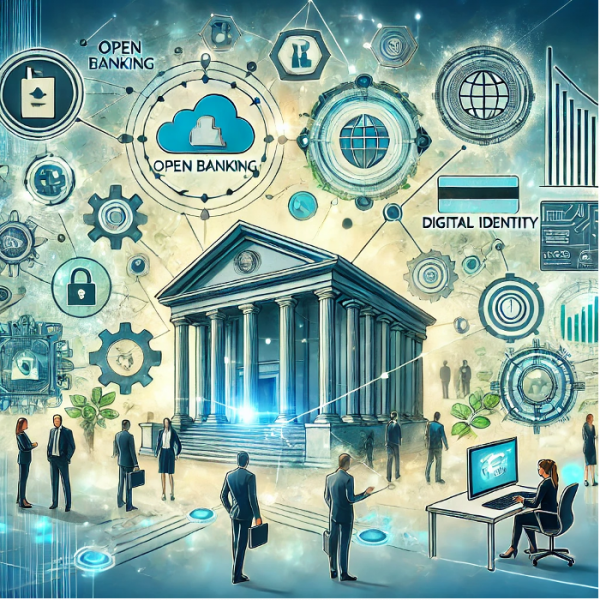
The financial sector is at a critical stage of development:
- The use of technologies such as open banking, digital identity,and blockchain is becoming a necessity
- The industry requires a shift from a reactive to a proactiveapproach
- The importance of anticipating and preparing for futurechanges is increasing
- Despite the dominance of traditional giants, consumers are ready for innovation, creating pressure on the industry as a whole
The financial services industry is undergoing a significant transformation driven by technological advancements and changing consumer expectations. Open banking, digital identity, and blockchain technologies are becoming essential tools for financial institutions to remain competitive and meet evolving customer needs. This shift is necessitating a move from reactive to proactive decision-making, with artificial intelligence playing a crucial role in anticipating and addressing challenges before they become critical issues.
The industry’s modernization is also characterized by an increased focus on customer- centricity andinnovation. Financial institutions are leveraging big data and advanced analytics to gain deeper insights into customer behavior and preferences, enabling them to offer more personalized and tailored services. Additionally, partnerships between traditional banks and fintech companies are becoming more common, combining the strengths of established institutions with the innovative capabilities of technology-driven startups.
Despite the slow pace of change in some areas, particularly among traditional financial giants, consumerreadiness for innovation is creating significant pressure for industry-wide transformation. This pressure is driving financial institutions to invest in new technologies, improve customer experiences, and develop more agile and responsive business models.
THE FUTURE OF LOGISTICS AND SUPPLY CHAINS:
EMBRACING EMERGING REALITIES
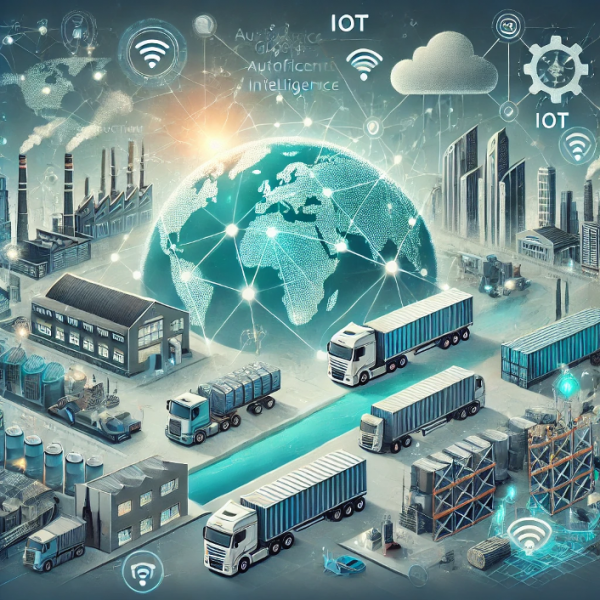
The industry faces numerous challenges:
- Regional instability
- Material shortages
- Production relocation
- Labor market tensions
Companies are forced to reassess their strategies, technologies, and work processes, marking a turning point in the development oflogistics and supply chain management.
The logistics and supply chain industry is undergoing a significant transformation as it adapts to a new landscape of challenges. Regional instability, exacerbated by geopolitical tensions and trade disputes, has created
uncertainty in global markets. Material shortages have disrupted production schedules and increased costs, forcing companies to seek alternative suppliers and diversify their sourcing strategies.
Production relocation, or nearshoring, has emerged as a trend to mitigate risks and reduce dependence on distant suppliers. Many manufacturers are evaluating opportunities to move production closer to end markets, particularly in regions like Mexico for North American supply chains and Eastern European countries for European markets.
Labor market tensions, including shortages of skilled workers and increasing wage pressures, have added another layer of complexity to supply chain operations. This has led to increased investment in automation and digital technologies to enhance efficiency and reduce reliance on manual labor.
In response to these challenges, companies are reassessing their supply chain strategies, embracing digital transformation, and implementing new technologies. The focus is on creating more resilient, agile, andtransparent supply networks. Key areas of investment include artificial intelligence for predictive analytics and decision-making, blockchain for enhanced traceability, and Internet of Things (IoT) devices for real-time visibility.
This period of adaptation and innovation marks a critical juncture in the evolution of logistics and supply chain management. As the industry navigates these new realities, it is likely to emerge more robust, technologically advanced, and better equipped to handle future disruptions.
THE FUTURE OF HOSPITALITY AND RESTAURANTS:
HARMONIZING TECHNOLOGY WITH THE HUMAN TOUCH
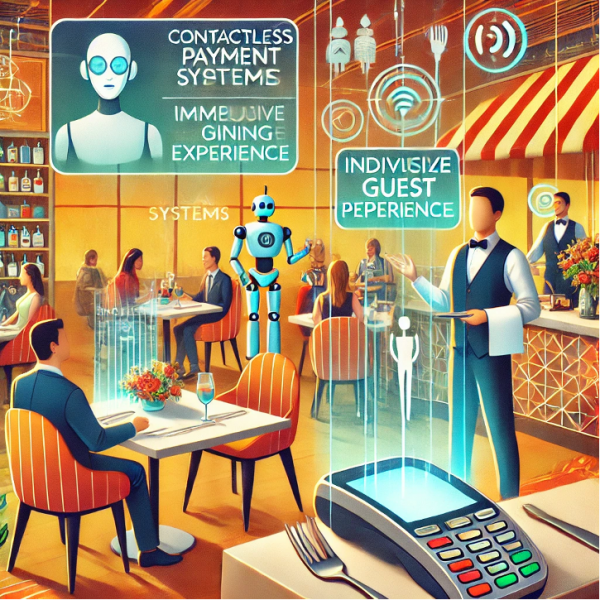
The hospitality industry is implementing innovative solutions:
- Contactless payments
- Immersive pre-arrival experiences
- Systems recognizing individual guest needs
- Automation of «behind-the-scenes» processes
However, key roles may remain with humans, creating constant tension between the pursuit of efficiency and the need for personalized service.
The hospitality sector is undergoing a significant transformation,leveraging technology to enhance guest experiences while maintaining the essential human touch. Contactless payments have become increasingly popular, offering convenience and hygiene benefits. Immersive dining experiences are on the rise, engaging guests beyond just the meal itself.Advanced systems are being developed to recognize and anticipate individual guest needs, allowing for more personalized service.
Behind the scenes, automation is streamlining operations, freeing up staff to focus on guest interactions.However, the industry faces a delicate balance between technological efficiency and maintaining thepersonal connections that define hospitality. Technology should be an enabler of better service, not areplacement for it.
This balance is crucial, as guests still value human interaction and personalized experiences. The challenge lies in integrating technology seamlessly to enhance, rather than replace, the human element of hospitality. As theindustry evolves, finding the right equilibrium between technological innovation and genuine human connection will be key to success in the hospitality sector..
THE FUTURE OF SPORTS:
PROGRESS DRIVEN BY ANALYTICS AND PERSONALIZATION
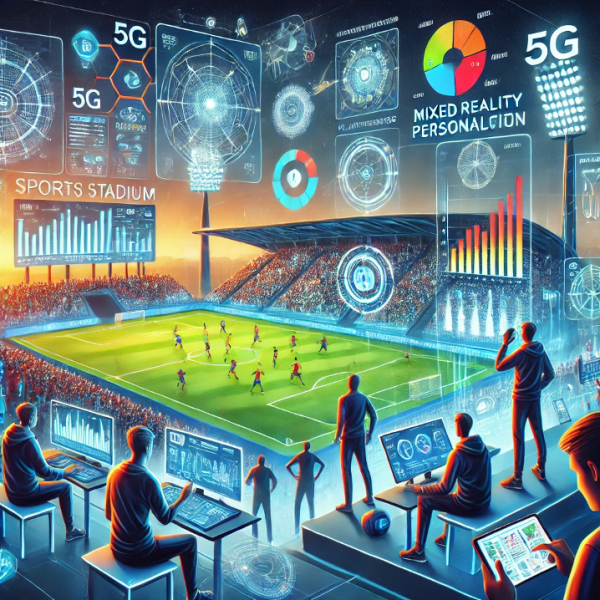
Technologies are enhancing the efficiency of all participants in the sports industry:
- Teams and leagues are improving methods of scouting, training, performance analysis, andrehabilitation
- Mixed reality, computer vision, and AI tools are beingimplemented
- Smart stadiums offer unique, immersive events
These innovations not only increase fan engagement but also open up new revenue streams for further improving the quality of gamesand fan experiences.
The sports industry is undergoing a significant transformation driven by advanced analytics and personalization technologies. Teams and leagues are leveraging data- driven approaches to enhance various aspects of theiroperations, from player performance to fan engagement.
Computer vision and AI technologies are revolutionizing player tracking, performance analysis, and scouting.These tools enable teams to detect and track individual players, analyze movement patterns, and gain behavioralinsights. This data-driven approach helps coaches and performance analysts optimize training regimens, reduceinjury risks, and develop more effective strategies.
Smart stadiums
are at the forefront of this technological revolution, offering immersive and personalized experiences for fans. These venues integrate sensors, cameras, and digital signs to provide real-time information on parkingavailability, concession lines, and seat upgrades. The implementation of 5G networks in stadiums allows fans to access instant replays, real-time statistics, and interactive features directly on their devices.
The use of mixed reality and augmented reality technologies is enhancing the viewer experience both in-stadium and at home. These tools provide immersive visualizations such as player heatmaps, passing patterns, and virtual graphics overlaid onto live broadcasts.
is becoming increasingly important in fan engagement strategies. By leveraging data analytics, sportsorganizations can deliver tailored content, personalized promotions, and customized experiences thatresonate with individual fan preferences. This level of personalization not only increases fan satisfaction and loyalty but also opens up new revenue streams through targeted advertising and premium services.
These technological advancements are not only improving the fan experience but are also driving the overall progress of the sports industry, creating a virtuous cycle of innovation and engagement.
THE FUTURE OF ENTERTAINMENT:
UNLOCKING NEW HORIZONS WITH AI
The entertainment industry is undergoing revolutionary changes driven by the rapid advancement of artificialintelligence (AI) technologies. These innovations are transforming how content is created, personalized, anddistributed, offering audiences deeper, more interactive, and immersive experiences.
Key Areas of Transformation:
- Content Personalization: AI analyzes user preferences, providing recommendations that closely align with individual interests, creating a unique experience for each viewer.
- Content Creation: AI algorithms assist in writing scripts,editing videos, and even generating realistic virtual imagery,significantly accelerating the production process.
- Integration with VR and AR: AI enhances virtual and augmentedreality technologies, enabling users to immerse themselves fully increated worlds.
- Preference Analytics: By analyzing big data, AI helps producers better understand audience tastesand optimize content to meet market demands.
- Moderation Automation: AI effectively monitors content quality, prevents
Emerging Interaction Formats:
- Secondary Live Experiences: Virtual concerts, interactive shows, and hybrid events allow viewers to feel part of the action, no matter where they are.
- Tactile Technologies and Holography: Real-time innovations, such as holographic transmissionand tactile interfaces, make interaction with content even more realistic.
- Environmental Consciousness: Growing interest in local entertainment options is fostering sustainable formats that meet audience expectations.
Challenges and Opportunities:
While AI opens limitless opportunities for innovation, it raises critical questions about ethics, copyright, and the need to preserve human creativity. Balancing automation with the uniqueness of humancontribution is a key challenge for the future.
AI does more than enhance existing business models—it redefines them entirely, creating new waysto engagewith audiences and generate revenue.This transformation promises to make entertainment morepersonalized, interactive, and environmentally responsible, reshaping traditional notions of content andaudience engagement.
THE FUTURE OF THE MEDIA INDUSTRY:
REDEFINING THE INFORMATION ECOSYSTEM
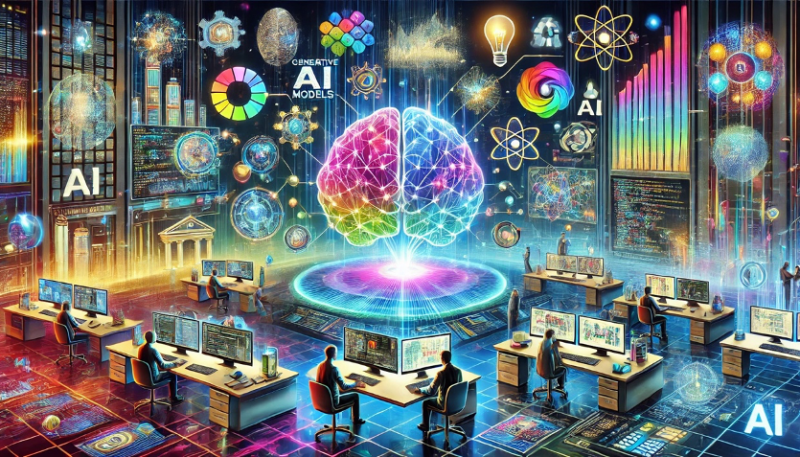
The Information Industry is Undergoing Radical Changes Driven by Digital Technologies and Evolving ConsumerBehavior
- Generative AI: These technologies are transforming approaches to content creation, distribution,and monetization, becoming a key driver of innovation.
- Value Chain Transformation: AI automates processes ranging from content development to customerexperience management, enabling dynamic pricing, personalized subscriptions, and more precise adtargeting.
- Changing Consumer Behavior: People increasingly turn to platforms powered by AI, which cannot only anticipate but also shape their preferences.
Revolutionizing the Media Landscape
Media companies are adapting to challenges posed by generative AI, which automates labor-intensiveprocesses, reduces costs, and accelerates content creation. However, AI’s most crucial role is in creatingpersonalized experiences that retain audiences and enhance loyalty.
AI adoption opens new opportunities for media, including:
- Developing interactive and adaptive content.
- Leveraging analytics to predict audience interests.
- Creating new business models, such as targeted advertising or hybrid subscription formats.
Impact on Information Consumption
A clear shift in consumer behavior is evident: the demand for personalization is growing, and audiencesexpect content tailored perfectly to their interests. AI-powered platforms are learning not only to analyzebut also to shape these expectations by offering personalized recommendations and adapting experiences for each user.
New Horizons and Challenges
НDespite the initial hype around ChatGPT and other language-model-based products subsiding, AI’s impacton the information ecosystem is irreversible. These technologies have transformed information consumption,making it more accessible, personalized, and interactive.
However, challenges arise, including:
- Combating misinformation.
- Protecting intellectual property rights.
- Addressing ethical aspects of automation.
- Balancing human creativity and algorithms.
The information ecosystem stands on the brink of a new era, with AI playing a leading role in itstransformation. This revolution will not only reshape how we interact with information but also define the future of the media industry, setting new standards for quality, engagement, and responsibility.
ARTIFICIAL INTELLIGENCE:
ON THE THRESHOLD OF A NEW ERA
Today, we stand on the brink of revolutionary changes in the field of artificial intelligence (AI), not tied tospecific technological breakthroughs, but driven by a deeper transformation in the perception of AI and its role in everyday life. Over the past year, AI has become accessible to both consumers and businesses, leadingto significant growth in investments and the formation of new partnerships.
Ubiquity of AI and Global Challenges
AI is permeating all spheres of life, changing interaction with the digital world. Researchers are working to increase the power andefficiency of AI systems against the backdrop of growing geopolitical tensions. Breakthroughs in the development of largelanguage models (LLMs) are accelerating the integration of AI into everyday life, opening up new opportunities in healthcare and lifesciences.
Key achievements include:
- Unveiling protein structures to create new therapies
- Alternative solutions to combat climate change
- AI assistants for programmers becoming more powerful, accelerating software development
Flagship AI Models
AI models represent complex computational structures for solving tasks requiring human intelligence. These models are capable of learning from large-scale datasets, increasing their efficiency. Notable examplesinclude:
- ChatGPT-o3: a new multimodal model from OpenAI with improved accuracy and creativepotential
- Gemini 2.0: a new version from Google with multimodal support
- Claude 3.0: a new model from Anthropic with the ability to process large volumes of data
Industry Leaders and Success Factors
Technology giants like Google and Microsoft have captured leadership in model development. These companies possess the necessary infrastructure to implement ambitious AI projects. Success factors include:
- Access to vast amounts of data
- Availability of powerful computational infrastructure
- Concentration of engineering talent
Energy Paradox and Talent Shortage
Creating modern models requires significant computational power and months of work by highly qualifiedspecialists. The rapid development of AI creates several problems:
- AI’s energy needs increase carbon emissions
- Shortage of qualified personnel hinders AI application in key sectors
Political and Regulatory Challenges
Political activity regarding AI is increasing, leading to the emergence of multiple competing policies. Regulation remains a serious challenge, and the uneven distribution of AI achievements threatens to deepenglobal inequality. The United States will continue to limit allies’ cooperation with China in the AI sphere. The European Commission will open a European AI Office to ensure compliance with laws and internationalcooperation..
Generative AI: A Catalyst for Change
Generative AI has become the first step into a new world of technology. Its rapid growth over the past year demonstrates the potential for innovation and operational optimization. However, it’s important to understand that generative AI is just one part of the AI technology spectrum.
Resource Consolidation and Market Leaders
AI development requires enormous resources. Market leaders such as OpenAI, Anthropic, and Google depend on cloud providers. Venture investments continue to flow into both startups and mature companies.
Development Prospects General Trends:
- Commoditization of universal models: LLMs will become widely available.
- Vertically integrated solutions: Companies providing industry-specific LLMs will gain acompetitive advantage.
- Natural language interfaces will replace graphical interfaces.
Corporate Trends:
- A wave of departures of leading specialists from major tech giants is expected.
- Growth in corporate use of AI as a key to growth.
Robotics Development
Alongside AI development, innovations in robotics are being implemented, including both «hard» and «soft» robots. This expands the boundaries of automation and human-machine interaction.
Revolution in Video Generation
OpenAI introduced Sora Turbo - a text-to-video generation model with format selection capabilities. Googlepresented Lumiere - a text-to-video model with realistic motion.
Predicting the Future: From Personal Destiny to Global Climate
AI demonstrates capabilities in predicting various aspects of life. The Life2vec model can predictsignificant life events, while Nvidia introduced Earth-2 for climate change predictions.
Thus, AI development continues to have a profound impact on key aspects of global politics, economics, and technology. This period will be an era of significant innovation and growth, especially considering how AIstimulates development in other fields of science and technology.
Advanced AI systems are expected to have the following capabilities:
- Superhuman intelligence: Superiority over the best human experts in a wide range of disciplines,from mathematics to literature.
- Multimodality: Ability to interact through various interfaces, including text, audio, video, anddevice control.
- Autonomy: Performing complex long-term tasks with minimal human intervention.
- Scalability: Ability to deploy millions of AI instances working both independently and incoordination.
- Ultra-fast processing: Analysis and generation speed 10-100 times faster than human.
These advanced AI systems promise to revolutionize scientific research, healthcare, and many other fields, paving the way for unprecedented progress in improving the quality of human life.
For more details on the latest trends in artificial intelligence development, refer to the 4th part of this book titled «Artificial Intelligence: Global Transformations and Future Challenges.»
THE REVOLUTIONARY POTENTIAL OF ARTIFICIAL INTELLIGENCE IN BIOMEDICINEЕ
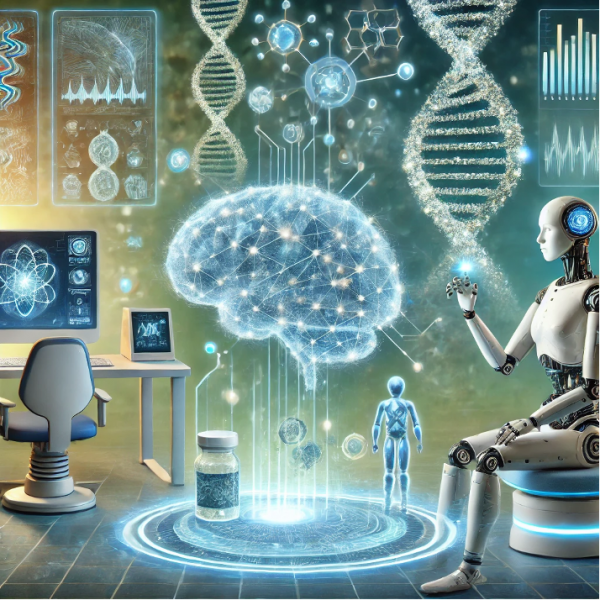
While AI applications are vast, areas directly affecting human well-being, namely biology, physical health, neuroscience, and mental health, attract particular attention.
Biomedicine remains one of the most promising fields of science,promising radical improvements in the quality of human life. Over the past year, we have witnessed a series of breakthrough achievements that bring us closer to solving centuries-old healthcare problems.
Key Technological Achievements Set to Transform Biomedicine
Much of the progress in biology is due to a small number of key discoveries, often related to new methods ofmeasuring or intervening in biological systems. AI has the potential to significantly accelerate the emergenceof such breakthrough discoveries, overcoming the inherent complexity of biological processes.
Examples of AI’s Transformational Impact:
- AlphaFold 3: Enables prediction of protein interactions with other molecules, opening new possibilities for drug development and understanding immune processes.
- Personalized Medicine: AI analyzes genetic data to develop individual treatment plans,significantly increasing therapy effectiveness.
- Accelerating Clinical Trials: AI optimizes study design and data analysis, reducing the time and costof new drug development.
- Regenerative Medicine: Progress in tissue engineering and stem cells opens new possibilitiesfor restoring and replacing damaged organs.
- Early Diagnosis: Computer vision systems detect diseases at early stages with accuracy exceedinghuman capabilities.
- Synthetic Biology: AI can accelerate the design and optimization of synthetic biological systems,opening new opportunities in biotechnology.
- Environmental Research: AI can help in rapid analysis of complex ecosystems and prediction ofenvironmental changes.
- Neurotechnologies: Development of brain-computer interfaces and neuromodulation methods promises revolutionary approaches to treating neurological and mental disorders.
- Neural Network Analysis: Advanced algorithms map brain activity, revealing mechanisms ofmental illnesses.
- Virtual Therapists: AI assistants provide round-the-clock psychological support, adapting toindividual patient needs.
- Risk Prediction: Machine learning analyzes behavioral patterns for early detection of suicidaltendencies and other mental health issues.
Key Achievements and Their Current State:
CRISPR: Precision and Safety at a New Level
- Increased editing accuracy with minimal side effects
- New delivery methods allowing more effective targeting of specific cell types
- Successful application for treating sickle cell anemia and beta-thalassemia
Breakthroughs in Microscopy
- New fluorescent methods for real-time visualization of living cells
- Cryo-electron microscopy achieving atomic resolution for large protein complexes
Genomic Technologies: Speed and Accessibility
- Whole genome sequencing cost reduced to $600
- New DNA synthesis methods allow creation of longer and more complex genetic constructs
Optogenetics and Neurosciences
- Development of new light-sensitive proteins with improved characteristics
- Methods allow not only activation but also inhibition of neurons with high precision
- mRNA Vaccines: Universal Prevention Tool
- Development of vaccines against various forms of cancer
- Research on mRNA vaccines against HIV, malaria, and tuberculosis
Breakthrough in Cervical Cancer Treatment
- INTERLACE study showed that a short course of chemotherapy before standard treatment reduces the risk of death by 40% and the risk of recurrence by 35%
CAR-T Therapy: Personalized immunotherapy showing impressive results in treating various cancers
- Expansion of application to solid tumors, including breast cancer and glioblastoma
- Development of «universal» CAR-T cells, reducing production cost and time
- Rethinking the Microbial Theory of Disease
- Recognition of the important role of the microbiome in health and disease
- Study of the virome’s influence on the immune system and disease development
These technological breakthroughs open up enormous opportunities for improving health, as well as the quality and length of human life. However, their potential can be realized even faster by attracting more talented researchers. Increasing intellectual resources in these areas can accelerate discoveries by 10 times or more, highlighting the high return on investment in human capital in biomedical research.
Horizons of Biomedicine: Forecast of Revolutionary Achievements
ИThe integration of artificial intelligence (AI) into biomedical research continues to accelerate the pace ofscientific progress, bringing us closer to realizing the concept of a «compressed 21st century» in healthcare.Here’s an overview of key achievements and predictions for the near future:
Conquering Infectious Diseases
Breakthroughs in mRNA vaccine technology and antiviral drugs have brought us to the threshold of creatinguniversal vaccines against most known pathogens. A recently developed pan-coronavirus vaccinedemonstrates efficacy against all known SARS-CoV-2 strains and related viruses.
Revolution in Oncology
Personalized immunotherapy and AI-developed targeted drugs have achieved remission in 80% of patientswith previously incurable forms of cancer. CAR-T therapy is now successfully applied against solid tumors, andnew early diagnostic methods can detect cancer at the preclinical stage.
Genetic Diseases: From Prevention to Treatment
Advanced methods of embryonic genetic screening and safe in vivo genome editing technologies pave the way for preventing and treating most monogenic diseases. A recently approved gene therapy for cysticfibrosis shows efficacy in 95% of patients.
Breakthrough in Fighting Neurodegenerative Diseases
New biomarkers identified through AI analysis of big data allow diagnosing Alzheimer’s disease decadesbefore symptoms appear. Combination therapy, including beta-amyloid removal and neurogenesisstimulation, shows promising results in slowing disease progression.
Expanding Biological Freedom
Advances in regenerative medicine and tissue engineering open new possibilities for controlling one’s ownbiology. The first fully functional artificial organs grown from a patient’s stem cells have been created, and new weight control drugs demonstrate efficacy without significant side effects.
Overcoming Age-Old Ailments
Recent advances in gene therapy, immunology, and regenerative medicine open prospects for completelyeradicating many diseases that have plagued humanity for centuries. The new generation born in this eramay be the first for whom diseases like cancer, diabetes, or Alzheimer’s become mere historical terms.
Quality Longevity
Research on senolytics and epigenetic reprogramming shows potential for significantly slowing aging processes. A recently completed clinical trial of combination anti-aging therapy demonstrated a reduction in participants’ biological age by an average of 5 years over 18 months of treatment. Life extension technologies based on the latest discoveries in epigenetics and tissue regeneration promise to significantlyincrease not only the duration but also the quality of life.
КKey Factors Accelerating Scientific Discoveries:
The Concept of the «Compressed 21st Century»
Key conditions for an accelerated process of scientific discovery are as follows:
- Concentration of talent: Historically, breakthrough discoveries were often made by small groups of researchers, indicating the importance of intellectual mastery rather than just the volume of resources.
- Potential for early discoveries: Many revolutionary technologies, such as CRISPR, could have beendeveloped much earlier. AI can help identify and realize this hidden potential faster.
- Overcoming institutional inertia: AI can help overcome the conservatism of the scientific communityby more quickly identifying and supporting promising research directions.
- Parallel research: Many discoveries can be developed simultaneously, opening up opportunities formassive parallelism using AI.
AI as a Virtual Biologist
The modern understanding of AI’s role in biology goes far beyond simple data analysis. AI is now viewed as avirtual biologist capable of:
- Designing and conducting experiments by controlling laboratory robots
- Inventing new biological methods and measurement techniques
- Accelerating the entire research process, from planning to interpreting results
Predictions for Accelerating Scientific Progress
- 10-fold acceleration: A conservative estimate suggests that AI can accelerate biological discoveries 10-fold, allowing 50-100 years of progress to be achieved in 5-10 years.
- Potential for more significant acceleration: There is a theoretical possibility of achieving 1000years of progress in 5-10 years, although this may sound implausible.
- Limitations of ultra-fast progress: Achieving 100 years of progress in 1 year is unlikely due tounavoidable delays associated with experiments and equipment development.
All of this fits into the concept of the «compressed 21st century» in biology and medicine.
Limiting Factors
Despite significant progress, biological research still faces several limitations:
- Physical world speed: Many biological processes require time that cannot be substantially reduced. Cell cultivation, observing organism growth, and long-term clinical trials remain lengthy processes.
- Data quality: While the amount of available data is growing, its quality and interpretationremain problematic. Isolating specific biological effects from multiple confounding factors is stillchallenging.
- Complexity of biological systems: The interaction of multiple factors in living systems createsenormous complexity that is difficult to model and predict.
- Ethical and regulatory constraints: Clinical trials in humans continue to be a lengthy processdue to the need to ensure safety and ethical standards.
Despite these challenges, advances in artificial intelligence and computational biology are helping to overcome some of these limitations. For example, AI already outperforms experts in predicting organoid development at early stages, which can accelerate the process of research and drug development.
Currently, the role of artificial intelligence (AI) in biological research continues to transform, overcomingtraditional limitations and opening new horizons for scientific progress.
Overcoming Skepticism
The historical skepticism of biologists regarding the value of AI and «big data» is gradually giving way torecognition of their transformational potential. Breakthrough achievements such as AlphaFold 3, awardedthe Nobel Prize in Chemistry in 2024, and AlphaProteo demonstrate AI’s ability to revolutionize biologicalresearch.
Overcoming Limitations
AI helps overcome key limitations in biological research:
- Data complexity: AI can analyze and interpret complex biological data with unprecedentedaccuracy.
- Data quality: Machine learning algorithms can improve data quality by identifying and correctingerrors.
- Bureaucratic barriers: AI optimizes processes, reducing time spent on administrative tasks inclinical trials
Social Aspects and Innovation Implementation
Despite potential social barriers, biomedical innovations historically demonstrate a high degree of successfulimplementation. This provides grounds for optimism regarding the rapid adaptation of new AI-developedtechnologies:
- Public acceptance: Growing understanding of the importance of scientific innovations inhealthcare contributes to faster adoption of new treatments.
- Regulatory flexibility: Regulatory bodies are adapting to the accelerated pace of innovation,developing more flexible approaches to evaluating new technologies without compromising safety.
- Global collaboration: International initiatives for data sharing and collaborative research accelerate the global implementation of biomedical innovations.
Rethinking Healthcare and Social Development
Radical improvements in population health and increased life expectancy require a fundamental revision ofexisting healthcare and pension models. Current debates on healthcare financing and medical insurance maybecome irrelevant in light of new realities.
New Challenges and Opportunities
While many current healthcare problems may be solved, society will face new challenges:
- Ensuring equal access to revolutionary medical technologies becomes a key ethical and politicalissue.
- Adapting the labor market to increased active life expectancy will require rethinking careertrajectories and education.
- Psychological adaptation of society to a radical increase in life expectancy and changing concepts of aging.
Thus, the integration of AI into biological research promises to revolutionize the pace of scientific discovery. Although there are certain limitations related to the need for physical experiments and equipmentdevelopment, the potential for significant acceleration of progress is evident. The key success factor will bethe effective combination of human intelligence and creativity with AI’s analytical capabilities, which may lead to unprecedented breakthroughs in our understanding of life and ability to address global health andenvironmental challenges.
ARTIFICIAL INTELLIGENCE AND NEUROSCIENCE:
A REVOLUTION IN UNDERSTANDING AND ENHANCINGTHE HUMAN MIND
The synergy between neuroscience and artificial intelligence (AI) has led to unprecedented progress inunderstanding the human brain and treating mental disorders. This process is unfolding along several keydirections.
Breakthroughs in Neurobiology and Psychiatry
Molecular Neurobiology and Pharmacology
AI has significantly accelerated the development of newneuropsychiatric drugs. The recently approved drug NeurAid-X demonstrates efficacy in treating resistant depression withouttraditional side effects.
Neuroimaging and Neuromodulation
New non-invasive methods, such as adaptive transcranial magnetic stimulation (aTMS), allow precise targeting of specific neural circuits, showing promising results in treating obsessive-compulsive disorder andPTSD.
Computational Neuroscience
Integrating concepts from AI, such as the scaling hypothesis, into neurobiology has led to new understanding oflearning and memory mechanisms. This understanding is transforming approaches to treating neurodegenerativediseases.
Behavioral Interventions
AI assistants for cognitive-behavioral therapy show effectiveness comparable to human therapists in treatinganxiety disorders and mild depression..
Prospects for Treating Mental Disorders
- Schizophrenia: Combined therapy including targeted neuromodulators and AI-driven cognitive rehabilitation shows a 70% reduction in symptoms for patients with treatment-resistant forms.
- Addictions: Personalized neuromodulation protocols combined with real- time AI supportdemonstrate 60% success in long-term remission.
- Autism: Early diagnosis and intervention using AI analysis of behavioral patterns significantly improve social skills in children with autism spectrum disorders.
Cognitive Enhancement
New AI-developed neuroenhancers show significant improvements in memory, concentration, and creativitywithout serious side effects. Ethical debates about their use continue.
Ethical and Social Aspects
- Issues of access to advanced neurotechnologies are becoming a key topic in global healthcarediscussions.
- New legal frameworks are being developed to regulate the use of neurotechnologies andprotect neurodata.
- There is growing public debate about the boundaries of «normality» and potential risks of excessivecognitive enhancement.
Thus, the revolution in neuroscience, accelerated by AI, opens unprecedented opportunities for improvingmental health and human cognitive abilities. However, it also raises complex ethical and social questions that require careful consideration by society. A future where most mental disorders are treatable and human cognitive capabilities are significantly expanded seems increasingly real, but requires a responsible approachto the development and application of these technologies.
WORK AND MEANING IN THE AGE OF ARTIFICIAL INTELLIGENCE: PROSPECTS AND CHALLENGES
Context and Key Aspects
The rapid development of artificial intelligence (AI) has posed fundamental questions to society about the future of work and the search for meaning in life in a world where many traditional human tasks can beautomated.
Key Aspects:
Labor Market Transformation:
- Increasing role of AI in various economic sectors
- Emergence of new professions related to AI system development and management
- Growing demand for skills that are difficult to automate (creativity, emotional intelligence, critical thinking)
Search for Meaning:
- Rethinking the role of work in human life
- Growing interest in non-material aspects of life (art, spirituality, personal development)
- Increasing importance of interpersonal relationships and social connections
- Economic Models:
- Experiments with universal basic income in several countries
- Development of the sharing economy and platform economy
- Discussions on the need to revise traditional economic paradigms
Promising Directions:
- Hybrid work models: Development of systems where AI and humans work in tandem,complementing each other’s strengths
- Education and retraining: Strengthening the role of continuous education and adaptive educationalprograms to maintain skill relevance
- Social entrepreneurship: Growth of initiatives aimed at solving social problems using AI
- Personalized development: Using AI to create individual trajectories for personal and professionalgrowth
Challenges and Risks:
- Technological unemployment: Risk of mass displacement of workers from traditional economicsectors
- Inequality:Widening gap between those who can adapt tonew technologies and those who cannot
- Psychological problems: Increased anxiety and depression related to the loss of traditional sources ofself-identification
- Ethical issues: The need to define boundaries for AI application in decision- making that affectspeople’s lives.
Thus, the transformation of the concept of work and the search for meaning in the AI era is a complex and multifaceted process. Successful adaptation of society to these changes will require:
- Flexibility in rethinking traditional concepts of work and economic value
- Investments in education and development of new skills
- Creation of social and economic structures that support human well-being in a changing world
- Open dialogue between the technology sector, governments, and civil society about the future ofwork and the meaning of life.
Although the future remains uncertain, humanity has historical experience in adapting to large-scale economic and social changes. With the right approach, the AI era can open new opportunities for self-realization and creating a more just and prosperous society.
ECONOMIC DEVELOPMENT AND POVERTY ALLEVIATION IN THE ERA OF ARTIFICIAL INTELLIGENCE:
PROSPECTS AND CHALLENGES
The rapid development of artificial intelligence (AI) opens unprecedented opportunities for addressingglobal challenges, including poverty and economic inequality. However, a key question remains relevant: «Willeveryone be able to access the benefits of these technologies?»
Global Inequality and AI Potential
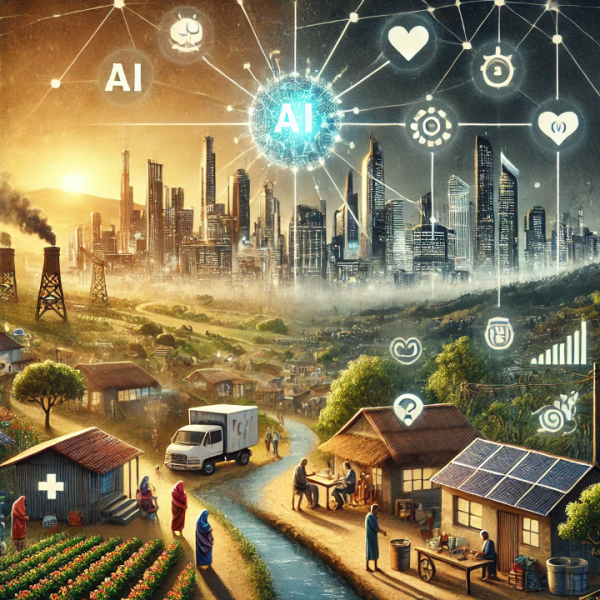
Currently, the gap in living standards between developed anddeveloping countries remains significant. GDP per capita in sub-Saharan Africa is about
$2,500, while in the US this figure exceeds $80,000. Thepotential of AI in reducing this gap is enormous, but its realizationfaces complex obstacles.
Key Areas of AI Application for Development
- Healthcare: AI can significantly improve the spread of medical innovations in developingcountries. It is expected that within 5-10 years after the introduction of advanced AI systems, up to 50% of healthcare benefits will become available even in the poorest countries.
- Economic Growth: An ambitious but achievable goal is to achieve 20% annual GDP growth indeveloping countries, of which 10% can be provided by AI-based solutions and the spread of acceleratedAI technologies.
- Food Security: AI can contribute to a «second Green Revolution» by optimizing agriculturalproduction and supply chains.
- Climate Change Mitigation: The development of clean energy technologies and methods for removing carbon from the atmosphere using AI can mitigate the effects of climate change, whichare especially critical for developing countries..
Challenges, Risks, and Solutions
Challenges and Risks:
- Corruption and weak institutions can significantly hinder the implementation of AI solutions indeveloping countries.
- Risk of deepening inequality: Without targeted efforts, AI can increase the gap between rich and poorboth within and between countries.
- The problem of «rejection»: There is a risk of forming population groups that reject AItechnologies, which can lead to the creation of a new «digital underclass».
Solutions:
- Development of global programs to spread medical and technological innovations in developingcountries.
- Creation of international initiatives to adapt AI-based economic strategies to local conditions indeveloping countries.
- Investments in education and digital literacy improvement to overcome barriers in adopting newtechnologies.
- Development of global AI governance mechanisms to ensure fair distribution of technology benefits.
Thus, the potential of AI in addressing poverty and economic inequality is enormous, but its realizationrequires concerted efforts from the international community, governments, technology companies, and civilsociety. With the right approach, by 2030 we can expect a significant reduction in global inequality andsubstantial improvement in the quality of life in developing countries. However, success is not guaranteed anddepends on our collective will and ability to adapt technological solutions to the complex socio-economicrealities of the developing world.
WORLD ORDER AND GOVERNANCE IN THE AGE OF ARTIFICIAL INTELLIGENCE:
PROSPECTS AND CHALLENGES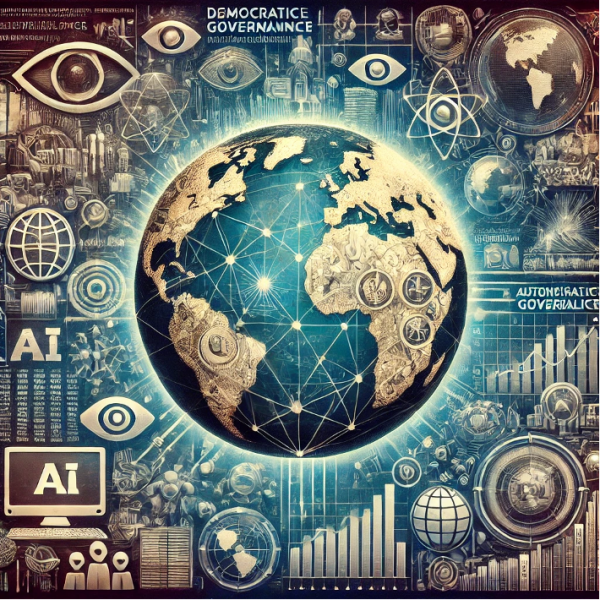 Global Context and Key Trends
Global Context and Key Trends
The global community faces a paradoxical situation: the rapid development of artificial intelligence (AI) hasopened unprecedented opportunities for solving global problems, but simultaneously exacerbated risks ininternational security and democratic governance.
Key Trends:
- Geopolitical tension: Increased competition betweendemocratic and authoritarian regimes for AI leadership.
- Information warfare: Growing use of AI for creating and spreading disinformation, propaganda, and manipulating publicopinion.
- Digital authoritarianism: Expanding capabilities of authoritarian regimes to control populations using AI technologies.
- Democratic innovations: Experiments with AI use to improvedemocratic processes and governance in developed countries.
Strategies of Democratic Countries:
- «Consensus Strategy»: Forming a coalition of democratic countries to ensure leadership in AIdevelopment and application.
- Technological superiority: Investing in advanced AI technologies to ensure military and economicadvantage.
- Global cooperation: Offering to spread AI benefits among a wide range of countries in exchange forsupporting democratic values.
- Information security: Developing methods to counter disinformation and manipulation using AI.
Potential AI Applications for Strengthening Democracy:
- Improving the legal system: Using AI to enhance objectivity in judicial decisions and ensure equality before the law.
- Optimizing public services: Implementing AI systems to increase efficiency and accessibility ofgovernment services.
- Computational democracy: Developing tools for aggregating citizen opinions and achievingconsensus on complex issues.
- Human rights protection: Applying AI for monitoring and preventing human rights violations.
Challenges and Risks:
- Technological inequality: Deepening the gap between AI-leading countries and the rest of the world.
- Ethical problems: The need to develop ethical standards for AI application in governance.
- Resistance to change: Potential distrust of citizens towards AI systems in critical governance areas.
- Cybersecurity: Increasing risks of cyberattacks on AI systems used in governance.
Thus, AI development opens new opportunities for strengthening democracy and international stability, whilealso creating serious challenges. Success in using AI to promote democratic values and peaceful coexistencedepends on coordinated efforts of the international community, governments, and technology companies.Key success factors will be:
- Developing international cooperation in AI regulation.
- Investing in education and improving digital literacy of the population.
- Developing ethical standards for AI application in governance.
- Ensuring transparency and accountability of AI systems used in critical areas.
With a rational and reasonable approach, AI can become a powerful tool for strengthening democratic institutions and ensuring international stability. However, this will require constant vigilance, adaptation,and readiness to address new ethical and technological challenges..
SUMMARY
This part of the book provides an analysis of current and future trends in technological progress. The analysis focuses on the impact of artificial intelligence (AI), biomedicine, and other revolutionary technologies on various spheres of human life. It reflects key aspects of global technological transformation,including:
Role of innovations: Emphasis on the synergy of technologies such as AI, bioengineering, virtual reality,and energy systems, which promise to radically change economics, healthcare, transportation, space industry,and other areas.
Socio-economic impact: Discusses challenges and opportunities related to the impact of technologies on the labor market, the search for meaning in life, poverty elimination, and ensuring equal access to innovations.
Global perspective: Highlights contradictions between AI-leading countries and developing regions, emphasizing the importance of international cooperation for fair distribution of technological progress benefits.
Ethical and regulatory aspects: Addresses issues of AI regulation, cybersecurity, human rightsprotection, and minimizing risks of technological unemployment.
Integration into biomedicine: Breakthroughs in biological research, such as CRISPR, mRNA vaccines, andCAR-T therapies, underscore the revolutionary potential of technologies in improving quality of life and solvingage-old healthcare problems.
Long-term challenges: Deepening gap between countries, uneven access to technologies, the need to revise socio-economic models, and possible social consequences of life extension.
Thus, we stand on the threshold of an era of unprecedented technological transformations thatsimultaneously carry enormous opportunities and significant risks. Successful adaptation to these changes willrequire global cooperation, a responsible approach to technology development and implementation, and anemphasis on preserving fundamental human values.
Currently, breakthroughs in artificial intelligence continue to transform various spheres, andfollowing the rapid development of generative artificial intelligence (AI), attention is increasingly shifting towards generative biology. In this field, AI is beginning to decipher biological processes,paving the way for the creation of new molecules, drugs, materials, consumable components,and even living organisms.
In the near future, our relationship with biology and the living world will undergo significant changes. CRISPR-based products are entering the market, including new drug therapies and innovative food products. We will no longer be limited to existing materials for producing batteries, clothing, or construction structures: biotechnology will allow the development of materials with unique properties.
Lab-grown meat - beef, chicken, and fish - is already being scaled up for mass production. This will enable meat consumption without the need for animal slaughter. Additionally, cellular reprogramming opens up prospects for slowing down or even reversing the aging process.Revolutionary fertility treatments that could change our understanding of parenthood are also on the horizon.
These changes will radically transform our relationship with biology and the natural world.However, there is currently no comprehensive policy that could guide us through this new landscape. Despite the enormous potential of biotechnology to improve lives, it also carries unprecedented risks. This underscores the need to develop management strategies and preparefor future challenges.
REVOLUTION IN GENOME SEQUENCING
Genome sequencing and metagenomics technologies have reached an unprecedented level of development,opening new horizons in biomedicine and ecology.
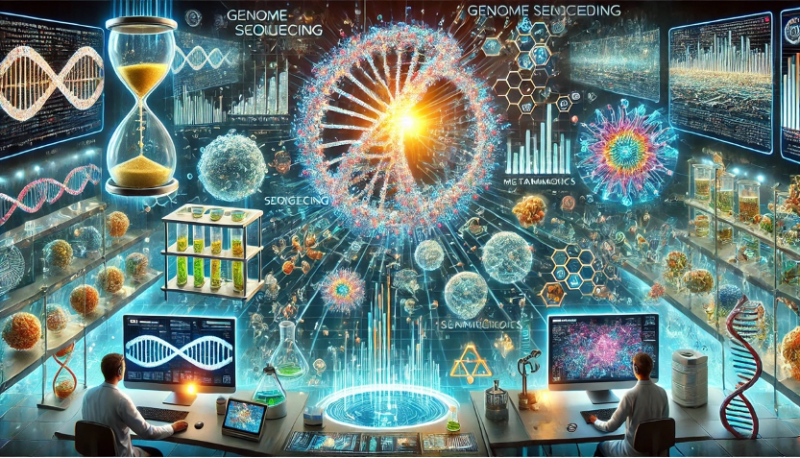
Next-Generation Sequencing: Speed, Accuracy, Accessibility
Genome sequencing is the process of determining the complete nucleotide sequence (A, T, G, C) in anorganism’s DNA. This method allows decoding the genetic code, identifying genes and other functional elementsof the genome, which forms the basis for understanding heredity, evolution, and disease development mechanisms. Modern sequencing technologies, such as Next-Generation Sequencing (NGS), enable rapid andefficient analysis of large volumes of genetic information.
The progress in genome sequencing over the past two decades is truly impressive. From $2.7 billion and 13years of work in 2003 to the ability to sequence a genome at home for less than the price of a television in 2024 - this is the path this technology has taken. It is comparable to the revolution in computer technology, smartphones, and internet connectivity.
Key next-generation technologies:
- Ion semiconductor sequencing: The Ion Torrent platform, developed by Thermo Fisher Scientific, converts genetic code directly into digital format on a semiconductor chip, making the process fasterand more accessible.
- Nanopore sequencing: Oxford Nanopore technology allows real-time data acquisition, which is critically important for rapid pathogen diagnostics in emergency situations.
- Single-molecule real-time sequencing: This technology enables observing the DNA replication processas it occurs.
Metagenomics: Decoding Ecosystems at the Molecular Level
Metagenomics represents a revolutionary approach to analyzing complex biological systems, allowingsimultaneous study of genomes from multiple organisms in their natural environment. This field ofmolecular genetics examines genetic material obtained directly from environmental samples, without prior isolation and cultivation of individual species. This approach enables the investigation of genomes from all microorganisms in a given ecological niche, including uncultivable species, providing a morecomprehensive understanding of biodiversity and functional capabilities of microbial communities.Metagenomics employs next-generation sequencing methods and bioinformatic analysis to study geneticcomposition, metabolic pathways, and ecological interactions in complex microbial ecosystems such as soil,oceans, or the human microbiome.
Key achievements and applications:
- Food safety: Detection of bacterial and viral contamination in food products, for example, insalads.
- Environmental cleanup: Identification of microorganisms capable of effectively degrading toxicsubstances in contaminated environments.
- Microbiome studies: Examination of microorganism interactions in various ecosystems, from thehuman gut to deep-sea hydrothermal vents.
Innovative developments:
- TaxonAI from Israeli company BiotaX: An AI-supported platform for analyzing and predicting multiple conditions and diseases based on metagenomic analysis.
- Lab-on-a-chip from Chilean KITAI: Integration of AI, microfluidics, and metagenomics forenvironmental monitoring and pathogen analysis.
These achievements in sequencing and metagenomics open up new possibilities for personalized medicine, environmental monitoring, and biotechnological innovations, promising revolutionary changes in ourunderstanding of life at the molecular level.
Revolution in Gene Synthesis
СGene synthesis is the process of creating artificial genes (DNA segments with a specified nucleotidesequence) in laboratory conditions without using existing natural DNA sequences. This method allowsobtaining virtually any desired DNA construct, including fully synthetic double-stranded DNA molecules of specified sequence and size. Gene synthesis is typically based on chemical synthesis of oligonucleotidesfollowed by their assembly into longer sequences.
Twist Bioscience continues to lead in DNA synthesis:
- Formation of DNA fragments up to 300 base pairs long
- Cost reduction to 7 cents per base pair (22% less year-over-year)
- Possibility of online ordering and fast delivery of synthetic DNA
Applications:
- Creation of new food products
- Development of innovative fertilizers
- Production of industrial products
- Creation of new pharmaceutical drugs
Quantum Biology: At the Intersection of Physics and Life
Quantum biology is an interdisciplinary scientific field studying biological processes and phenomena from the perspective of quantum theory. It focuses on investigating quantum effects in living systems, such as:
- Quantum coherence and interference in photosynthesis processes
- Quantum tunneling in enzymatic reactions and DNA mutations
- Quantum mechanisms of magnetoreception in animals
Quantum biology seeks to identify and analyze cases where quantum effects play a key role in enhancing the efficiency of biological functions at the molecular level. This field of science combines principles of quantum physics with biology, opening new perspectives such as:
- Potential for revolutionary discoveries in medicine
- Improved understanding of diseases at the molecular level
- Conditions for creating new technologies for data processing and energy storage
Key discovery:
At Johns Hopkins University’s Applied Physics Laboratory, similarities were found between a human metabolismenzyme and a magnetosensitive protein in birds, which could transform the approach to studying biologicalnavigation.
Completion of the Human Genome Map
The completion of the human genome map in 2022 marked an important milestone in genomic research,ushering in a new era in biomedicine. The full decoding of 3.055 billion DNA base pairs, including previously inaccessible regions, allowed scientists to gain a more accurate understanding of the structure and functions of the human genome. This achievement contributed to the diversification of genomic research, now covering a wide range of areas: from personalized medicine and development of new treatmentmethods to studying human evolution and comparative genomics. The development of sequencing technologies, such as optical genome mapping, and their cost reduction made genomic research more accessible, leading to expanded applications in clinical practice, especially in oncology and rare disease diagnostics.
Progress in human genome mapping:
- The Telomere-to-Telomere (T2T) Consortium identified all but five hidden regions of the map
- Use of new sequencing technologies, including nanopore devices capable of reading 100,000 basessimultaneously
- Discovery of new areas of gene evolution
Initiatives to diversify genomic research:
- The National Institutes of Health (NIH) invested $6.4 million in creating Diversity Centers forgenome research
- Goal: to expand research capabilities of universities and attract students from diverse backgroundsto study genomics
- Total commitments from the National Human Genome Research Institute amount to $32.7 millionover the next 5-7 years
These advancements in gene synthesis, quantum biology, and genomics open new possibilities for personalized medicine, fundamental research, and biotechnological innovations, promising revolutionary changes in ourunderstanding of life at the molecular and quantum levels.
GENE EDITING AND CRISPR:
A BREAKTHROUGH IN TREATING GENETIC DISEASES
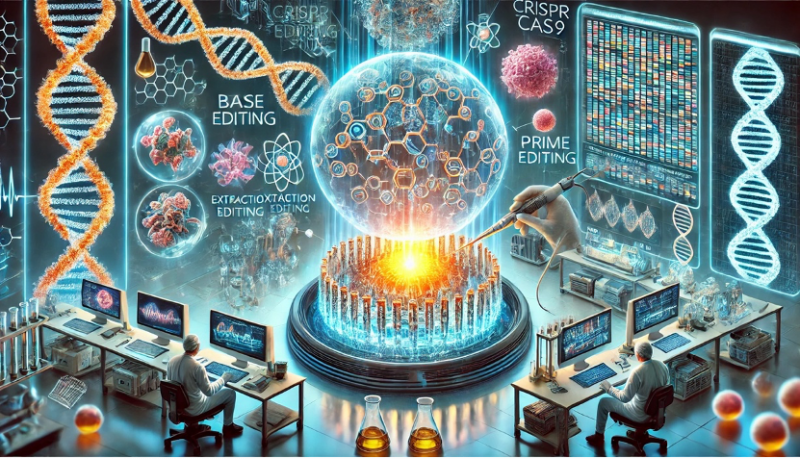
CRISPR (Clustered Regularly Interspaced Short Palindromic Repeats) is a genome editing technology based onbacteria’s natural defense system against viruses. It uses the Cas9 enzyme (or other proteins) to precisely cut DNA at specific locations, guided by short RNA molecules corresponding to the target sequence. CRISPR allows for genome modifications, including deletion, addition, or replacement of genetic fragments, with high precision and efficiency. This technology has revolutionized genetic research and found applications inmedicine, agriculture, and biotechnology.
Currently, CRISPR-Cas9 technology has established itself as a revolutionary method for treating geneticdiseases, ushering in a new era in medicine.
Casgevy: The First Approved CRISPR-Based Gene Therapy
Casgevy is the world’s first gene therapy drug based on CRISPR/Cas9 genome editing technology approved for clinical use. Developed by Vertex Pharmaceuticals and CRISPR Therapeutics, Casgevy is designed to treat sicklecell anemia and beta- thalassemia by editing the patient’s hematopoietic stem
cells. The drug works by activating fetal hemoglobin synthesis, compensating for defective adult hemoglobin inpatients with these diseases.
Casgevy became the first approved CRISPR-based gene therapy for treating sickle cell disease (SCD) and β-thalassemia. Approval from the US FDA and regulatory bodies in the UK, Canada, and Switzerland paved the way for the official application of this revolutionary technology.
Casgevy’s mechanism of action:
- Targeting the BCL11A gene, which inhibits fetal hemoglobin production
- Stimulating the production of a stable form of hemoglobin, alleviating disease symptoms
The treatment process includes:
- Extracting the patient’s stem cells
- Editing genes using CRISPR-Cas9
- Preparing the patient’s bone marrow
- Reinfusing modified cells
- Hospitalization period for monitoring
Challenges and Prospects
- Despite its effectiveness, Casgevy’s widespread application faces several challenges:
- High cost (over $3 million per treatment course)
- Complexity of scaling production
- Limited availability in low and middle-income countries
To address theseissues, the following steps are being taken:
- Developing cost reduction models (e.g., IGI’s «10x Less Model»)
- Exploring alternative approaches to intellectual property management
- Creating new organizational models for drug development
New Horizons in Gene Editing: Progress and Prospects
Currently, gene editing technologies have significantly advanced, opening new possibilities for treating geneticdiseases. Let’s consider key achievements in this field:
Base Editing
Developed by David Liu from Harvard, base editing allows for point changes of individual DNA «letters». Progressin this area:
- Beam Therapeutics initiated the first US clinical trials for leukemia treatment
- Verve Therapeutics showed promising results in treating high cholesterol levels
Prime Editing
This technology, also developed in Liu’s laboratory, provides even greater precision, allowing for the removalor addition of small DNA segments. Advantages:
- Increased accuracy compared to traditional CRISPR
- Successful correction of various hereditary diseases in animal models
Epigenome Editing
Epigenome editing modifies the epigenome to regulate gene expression without altering the underlying DNA.Achievements:
- Tune Therapeutics demonstrated success in gene suppression
- Epic Bio plans to start clinical trials in the near future
In Vivo Gene Editing
It has now become possible to make changes to genetic material directly in the organism. Key developments:
- Regeneron Pharmaceuticals and Intellia Therapeutics are conducting a phase 3 study of NTLA-2001 therapy
- Early clinical trials showed a reduction in pathogenic protein levels of up to 93%
Cell Therapy 2.0
New methods are advancing cell therapy to a new level:
In vivo cell therapy:
- Successful experiments in leukemia regression in mice
- Use of nanocarriers with new genetic instructions
Synthetic genecircuits:
- Protecting healthy cells when delivering CAR T-cells
- Increasing precision and safety of cell therapy
Prospects and Challenges
- Further development and improvement of gene editing methods are expected
- The need for careful study of long-term effects and safety of new technologies
- Ethical issues related to gene editing, especially in vivo, require constant attention
Progress in gene editing opens unprecedented opportunities for treating previously incurable diseases, but also poses new ethical and scientific challenges that need to be addressed in the coming years..
BIOPRINTING, ORGANOIDS, AND SYNTHETIC ORGANISMS
Advancements and Applications of Bioprinting Technologies
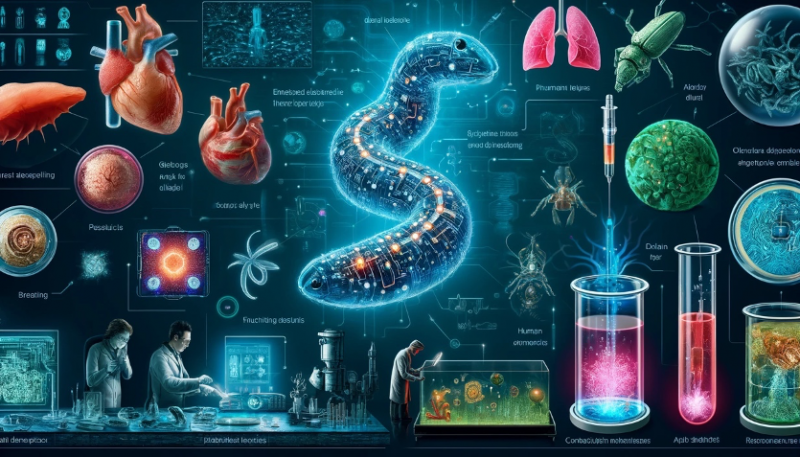
Bioprinting technology is an innovative method for creating three-dimensional biological structures using specialized 3D printers. This process involves layer- by-layer deposition of biomaterials, living cells, and supporting components (bioinks) to form tissue-like structures – organs and organoids. Bioprinting allows
for the reproduction of complex tissue and organ architecture while maintaining cell viability.
The technology finds applications in regenerative medicine, drug development, and disease modeling,opening prospects for creating functional tissues and organs for transplantation, as well as personalized tissue models for drug testing and studying pathological processes. Bioprinting and organoid creation technologies have achieved significant success, opening new horizons in medicine and bioengineering.
Organ Bioprinting and Tissue Engineering
Stanford University has received a contract to develop technology for growing human organs in bioreactors:
- Goal: production of fully functional human hearts every two weeks
- Planned trials: transplantation of printed hearts into live pigs
Harvard University’s Wyss Institute has developed a new 3D bioprinting technology for tissues, whichinvolves creating thick, vascularized tissues using living human cells. These tissues are 10 times thicker than previous samples and can function for up to six weeks.
Bioprinting Electronics in Living Organisms
Researchers from Lancaster University (UK) have made a breakthrough by printing luminous electronic circuitsinside living nematode worms:
- Use of a photonic 3D printer and special inks
- Creation of complex conductive circuits in the form of stars and squares inside living organisms
- Potential for improving traditional electronic implants and developing new brain-computerinterfaces
Organoid Manufacturing
Organoid manufacturing technology is a promising bioengineering technique for three-dimensional cellcultivation aimed at creating self-organizing miniature models of biological organs. These models, called organoids, are grown from stem cells or induced pluripotent stem cells and mimic the structure and functionsof a developing organ in a simplified form. Scientists use organoids to study organogenesis, model diseases, testdrugs and toxic substances, and for regenerative medicine experiments.
Progress in Organoid Manufacturing and Application
Key achievements:
- Weill Cornell Medicine: using an organoid model to develop a new treatment method forpancreatic cancer
- Princess Máxima Center for Pediatric Oncology (Netherlands): growing brain organoids fromhuman fetal tissue
- Stanford and University of Pennsylvania: successful transplantation of human brain organoidsinto damaged rat brains
Organoids in Long COVID Research
Scientists are using miniature models of the brain, lungs, intestines, and liver to study the effects of SARS-CoV-2:
- Karolinska Institute (Sweden): discovered that «brain fog» in long COVID may be caused bydisrupted connections between neurons
- MRC Laboratory of Molecular Biology (UK): identified damage to the brain’s protective barrierby the virus
- Institute of Global Health (Switzerland): investigating the formation of biofilms by Pseudomonas aeruginosa in lungs using AirGels - mini- structures that mimic the respiratory tractenvironment
Ethical Challenges and Legislative Initiatives
• Growing debates around the ethics of using fetal tissues in research
• Legislative initiatives aimed at restricting research using fetal tissues
Breakthrough in Creating Synthetic Bacteria
The technology of mobile synthetic bacteria is an innovative direction in synthetic biology aimed at creating artificial microorganisms capable of targeted movement and performing specified functions. These synthetic bacteria are developed through genetic modification or complete genome synthesis to endow them with specific properties such as chemotaxis, magnetotaxis, or phototaxis. They can be programmed to performvarious tasks, including drug delivery, toxin detection and neutralization, or environmental remediation. Thistechnology opens new possibilities in medicine, ecology, and biotechnology, allowing the creation of «smart» microorganisms to solve complex biological and environmental problems.
Researchers from Osaka Metropolitan University have achieved significant success in the following innovations:
- Creation of a synthetic bacterium capable of movement
- Introduction of only seven proteins to ensure mobility
- Recognized as the smallest mobile life form to date
Evolution of Synthetic Organisms
JCVI-syn1.0 (Synthia) - 2010:
- First self-reproducing species with a computer-synthesized genome
- 907 genes
JCVI-syn3.0 - 2016:
- The simplest life form at that time
- 473 genes
- Problems with normal cell division
JCVI-syn3A – 2021:
- Improved version with less than 500 genes
- More stable behavior, similar to normal cells
M. mycoides JCVI-syn3B – 2024:
- Ability to evolve, confirmed by a 300-day experiment
- Demonstration of the possibility of mutations in synthetic organisms
Significance and Prospects
Fundamental research:
- Deepening understanding of minimal requirements for life
- Studying evolutionary processes at a basic level
Applied aspects:
- Potential for creating synthetic organisms with specified properties
- Opportunities for bioengineering and biotechnology
Ethical issues:
- Discussions about the boundaries between artificial and natural life
- Need to develop ethical standards in synthetic biology
Future directions:
- Development of more complex synthetic organisms with expanded functions
- Integration of synthetic organisms into biotechnological processes
Research on minimally viable life forms continues to push the boundaries of our understanding of biology and opens new possibilities for creating synthetic organisms with specified properties. This direction promises revolutionary changes in biotechnology, medicine, and ecology, while simultaneously posing complex ethical questions to society about the nature of life and the limits of human intervention in it.
ORGANOID INTELLIGENCE AND BIOCOMPUTERS:
NEW FRONTIERS IN COMPUTING
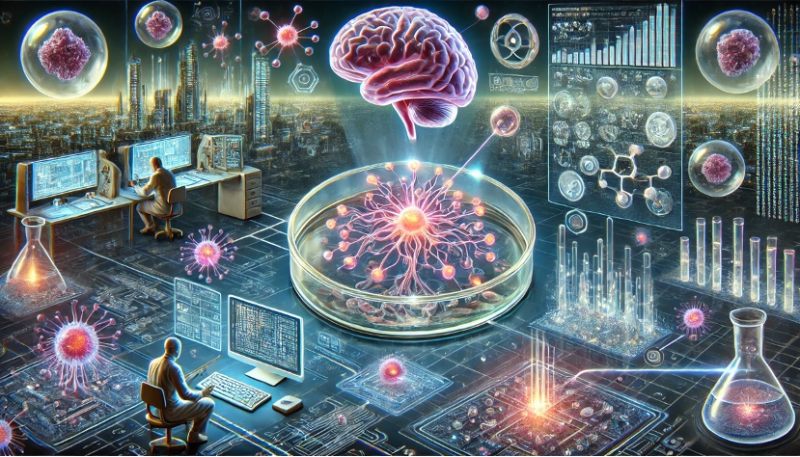
Organoid Intelligence (OI) is a novel interdisciplinary field of research that merges bioengineering of brain organoids with artificial intelligence methods. This technology aims to create biological computing systems by utilizing three-dimensional cultures of human brain cells grown from stem cells. Brain
organoids, exhibiting neural activity, are integrated with computer interfaces to process information and perform computational tasks. The goal of OI is to develop more efficient and energy-saving computing systems, model cognitive processes, and study brain development. This technology opens up new perspectives in neuroscience, artificial intelligence, and personalized medicine, potentially enabling the creation of"biocomputers" and more accurate models of brain diseases.
Organoid Intelligence: Living Computers
Researchers at Johns Hopkins University, leaders in the field of organoid intelligence, continue to developthis concept:
- Principle of operation: Using biological materials, primarily human brain cells, for informationprocessing
- Advantages: High energy efficiency and the ability to process data in parallel, surpassingtraditional silicon-based systems
- Achievements: A biocomputer system based on living brain cells successfully learned to recognize voices, distinguishing between 8 people speaking Japanese vowel sounds
Training Biocomputers
Bacterial computers:
- The Spanish National Research Council created a strain of E. coli called «Marionette» capable of playing tic-tac-toe at an expert level
- Method: Genetic modification to respond to chemicals and encode fluorescent proteins
DishBrain:
- A biocomputer consisting of 1 million living human and mouse brain cells
- Achievement: Learned to play the video game Pong, demonstrating the ability to learn
Biological Intelligence Operating System (biOS):
- Developed by Cortical Labs for programming biocomputers
- Goal: Make the technology accessible to a wide range of developers
Perspectives and Challenges
- Energy efficiency: OI and biocomputers promise a significant reduction in energy consumptioncompared to traditional systems
- Scalability: The potential to create more complex systems capable of solving complex AI tasks
- Ethical issues: The use of living brain cells raises ethical questions that require carefulconsideration
- Integration with existing technologies: The need to develop interfaces for biocomputers to interactwith traditional systems
The development of organoid intelligence and biocomputers opens up new possibilities in the field ofcomputing and AI, promising revolutionary changes in data processing and energy efficiency. However, this direction also poses complex ethical questions and technical challenges for society to address in the near future.
Breakthrough in DNA Computing
НDNA computers are an innovative technology that uses DNA molecules to perform computations andprocess information. This concept is based on the ability of DNA to store and transmit information, as well asthe ability to manipulate DNA molecules using enzymes. DNA computers use biochemical reactions to solvecomputational problems, where nucleotide sequences represent data and enzymatic reactions represent operations. The advantages of this technology include a huge density of information storage, parallel data processing, and energy efficiency. DNA computers can potentially solve complex mathematical problems, perform logical operations, and even serve as the basis for creating molecular nan machines, opening up new horizons in the field of computer science and nanotechnology.
Progress in Creating Biological Circuits
Researchers from Shanghai Jiao Tong University (China) presented the world's first programmable DNA computer:
- Capabilities: Performing billions of unique circuits
- Structure: 30 logic gates and 500 DNA chains
- Achievements: Calculating square roots and identifying genetic markers for kidney cancer
Scientists from the Federal University of Mato Grosso do Sul (Brazil) have developed innovative tools fordesigning and modeling biological circuits:
- DNAr: Software for simulating chemical reactions in biological systems.
- DNAr-Logic: A tool for designing logic circuits based on DNA
These developments significantly accelerate the process of creating biological circuits, which couldrevolutionize the discovery of new treatments and drugs.
Key Features of the Technology:
- Using DNA instead of silicon microchips.
- Applying the principles of DNA origami to create functional components.
- Potential for biomedical applications, including disease diagnosis and environmentalmonitoring.
Perspectives and Challenges
- Medical diagnosis: DNA computers can detect specific genes and trigger biological reactions to treatdiseases.
- Environmental monitoring: Potential for creating highly sensitive biosensors.
- Limitations: Current DNA computers take several hours to perform simple calculations, limiting theirapplication in traditional computing tasks.
- Future directions: Developing DNA computers capable of performing complex algorithms. Integrating DNA computing with traditional computer systems. Creating hybrid bio-electronicdevices
The development of biological circuits and DNAcomputers opens up new possibilities at the intersection of biology and computer science. These technologies promise revolutionary changes in medical diagnosis, drug development, and environmental monitoring, while simultaneously posing complex challenges forresearchers in terms of increasing efficiency and integration with existing technologies.
DNA Storage: A Revolution in the World of Data
DNA storage technology is an innovative method of storing digital information using DNA molecules as a data carrier. This approach is based on converting binary code (0 and 1) into sequences of nucleotides (A, T, G, C) of DNA. DNA storage has a number of unique advantages: incredibly high storage density (theoretically up to 215 petabytes per gram of DNA), durability (thousands of years under proper storage conditions), energyefficiency, and resistance to technological obsolescence.
DNA data storage technology can potentially revolutionize long-term data storage, offering a solution to the problem of growing volumes of information and the limited lifespan of modern digital media. Thistechnology has made significant progress, opening up new horizons in the field of long-term and high-densitydata storage.
Breakthroughs in Commercialization
The Paris-based startup Biomemory introduced innovative DNA cards costing
$500, each capable of storing 1 kilobyte of data. These cards, guaranteeing data preservation for at least 150 years, demonstrate the potential of DNA storage for ultra-long-term storage of sensitive data.
Technology Process:
- Converting digital data into ACTG sequences
- Chemical synthesis of a unique DNA chain (about 8 hours for 1 KB)
- Drying and sealing DNA on an oxygen-free chip
To read data, the card is sent to a specialized laboratory where the DNA sequence is decoded.
Large-scale Projects
- The IARPA group plans to store an exabyte of data in a block of DNA
- Scientists at Tianjin University (China) have stored 445 KB of data in an E. coli cell
- Twist Bioscience is developing a technology to create millions of short DNA strands on silicon chips
DNA Data Storage Alliance Consortium
Leading technology companies, including Microsoft, Western Digital, IBM, Dell Technologies, and others, have joined forces to develop a compatible DNA storage ecosystem. The goal of the consortium is to create a technology capable of writing megabytes of data per second to synthetic DNA with data preservation for thousands of years.
Perspectives and Challenges
Although DNA storage technology shows great potential, especially in the field of long-term data storage, thereare challenges associated with the speed of writing and reading information, as well as scaling the technologyfor mass use. Nevertheless, given the unique advantages of DNA as a data carrier, experts predict significant progress in this area in the coming years.
BIOROBOTS AND CYBERBIOSECURITY
Biorobots: On the Threshold of a New Era
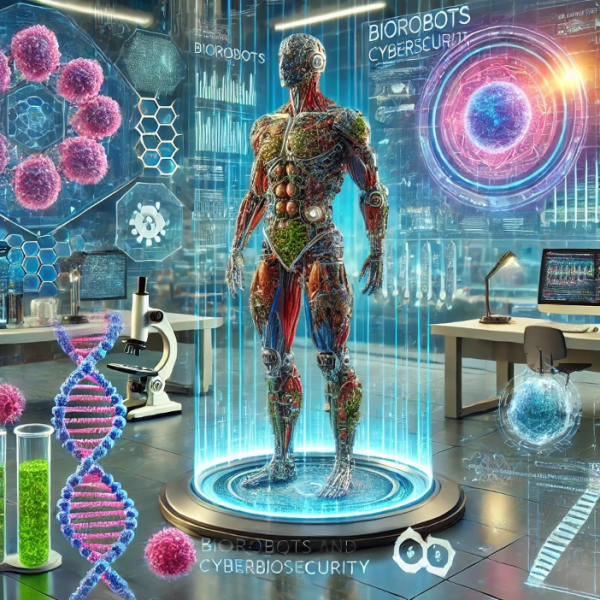
Biorobots are artificial biological systems that combine living cells ortissues with synthetic components to perform specific functions. This technology merges the achievements of synthetic biology, tissue engineering, and robotics to create programmable living machines. Biorobots can be constructed from various types of cells(e.g., heart or muscle tissue) on artificial scaffolds and controlled byexternal stimuli such as electrical or light signals. They have potential applications in medicine, environmental monitoring, and otherareas where interaction with biological
systems is required. Unlike traditional robots, biorobots have the ability to self- repair and can be biocompatible, opening up new possibilities for their use in living organisms.
Research in the field of biological robots and cyberbiosecurity has made significant progress, opening upnew horizons in medicine and technology but also creating new challenges for global security.
Evolution of Biorobots
Xenobots: These are microscopic biorobots created from living cells of Xenopus laevis frog embryos. Theseartificial organisms are developed using computer modeling and synthetic biology methods. Xenobots arecapable of independent movement, performing simple tasks, and even self-replication by collecting and organizing individual cells into new functional structures. They have no traditional organs, and their shape and functions are determined by an artificially created cell architecture. Potential applications of xenobotsinclude targeted drug delivery, cleaning up the environment from microplastics, and studying the processes of self- organization of biological systems. This technology opens up new perspectives in bioengineering andregenerative medicine.
Features of modern xenobots are:
- Improved design with the ability to move independently
- Increased lifespan and the ability to sense the environment
- Application in research of diseases associated with cilia in the lungs
- Development of xenobots for the regeneration of the damaged spinal cord
Anthrobots: Thisis an advanced technology at the intersection of robotics, artificial intelligence, and bioengineering aimedat creating humanoid robots with a high
degree of biomimetic properties. These devices combine mechanical and electronic
components with biological elements such as artificial muscles, synthetic skin, and neuromorphic chips that mimic the work of the human brain. Anthrobots are being developed to replicate human anatomy,physiology, and cognitive functions as accurately as possible. They can be used in various fields, includingmedical research, drug testing, education, social assistance, and the study of human behavior. This technologyopens up new possibilities for understanding the human body and creating more natural interfaces betweenhumans and machines.
Features of anthrobots are the following:
- Created from donor human tracheal cells
- Ability to self-organize into "superanthrobots"
- Successful experiments on tissue regeneration
Living Sensors:
Living sensors are an innovative biotechnological development that uses genetically modified organisms or cells to detect and measure various parameters of the environment or biological systems. These biosensors are created by introducing specific genetic constructs that allow organisms or cells to respond tocertain stimuli, such as chemicals, pathogens, toxins, or physical factors. The response of living sensors can beexpressed in a change in color, fluorescence, or the production of certain substances, which allows for easydetection of target objects.
Living sensors find application in environmental monitoring, medical diagnostics, food and water quality control, and industrial processes, offering highly sensitive, specific, and environmentally friendly alternatives to traditional analytical methods. The following areas in the development of living sensors havereceived the greatest development in recent years:
- Development of biosensors for the detection of biological weapons and harmful chemicals
- Creation of the Acinetobacter baylyi bacterium for the detection of DNA mutations associatedwith cancer
- Potential for early detection of viral outbreaks in sewage systems and pathogens in drinking water
Cyberbiosecurity
Cyberbiosecurity is an interdisciplinary field that combines the principles of cybersecurity and biotechnology to protect biological and biotechnological systems from digital threats. This technology aims to ensure the security of genetic information, biomedical devices, synthetic biological systems, and other biotechnological developments from unauthorized access, manipulation, or cyberattacks. Cyberbiosecurityincludes protecting the confidentiality of genomic data, preventing biohacking, ensuring the integrity of bioinformatics systems, and protecting bioproduction processes. With the development of synthetic biology and bioengineering, this area is becoming increasingly critical to prevent potential risks associated with themisuse of biotechnology or its vulnerability to cyberattacks.
Cyberbiosecurity: A New Frontier
- РThe growing interaction of AI and life sciences creates new opportunities and risks.
- Lack of a single oversight body for cyberbiosecurity.
- The Nuclear Threat Initiative convened an expert group in January 2024 to discuss securityissues.
Thus, the development of biorobots and related technologies opens up unprecedented opportunities in medicine and science but also creates new challenges in the areas of security and ethics. The need forinternational cooperation and the development of comprehensive regulatory mechanisms is becoming increasingly acute as these technologies develop.
Perspectives and Challenges
- Мedical applications: Potential for targeted drug delivery and regenerative medicine.
- Environmental monitoring: Using living sensors for early detection of pollution.
- Ethical issues: The need to develop ethical standards for research and application of biorobots.
- Regulatory issues: Lack of a clear regulatory framework for new biotechnologies.
- Security: Risks of using biotechnology as a weapon or to create biological threats.
REVOLUTION IN MATERIALS SCIENCE:
ARTIFICIAL INTELLIGENCE AND BIOTECHNOLOGY OPEN NEW HORIZONS
Discovering New Materials with Artificial Intelligence

The technology of discovering new materials usingartificial intelligence (AI) represents an innovative approach combining machine learning, computer modeling, and experimental data to accelerate the search and development of materials with desired properties. This technology
uses AI algorithms to analyze vast amounts of data on existing materials, predict the properties of potentialnew compounds, and optimize the processes of their synthesis. AI is capable of identifying complex relationships between the structure and properties of materials, allowing researchers to quickly identifypromising candidates for various applications - from creating more efficient batteries and solar cells todeveloping new drugs and ultra-strong alloys. This approach significantly reduces the time and cost ofdeveloping new materials, paving the way for rapid innovation in various fields of science and technology.
Artificial intelligence and biotechnology have revolutionized the creation of new materials, opening up unprecedented opportunities for innovation in various industries.
Recent Developments
Google DeepMind’s Graph Networks for Materials Exploration (GNoME) continues to transform the process ofdiscovering new materials:
- Predicted more than 2.2 million new crystalline structures
- Identified 380,000 stable materials with potential for practical application
- More than 736 new structures have already been synthesized and confirmed by independentresearchers
GNoME has significantly accelerated the process of discovering new materials, reducing the time from prediction to synthesis from months to days. This opens up new possibilities for creating more efficient solarcells, batteries, and computer chips.
The autonomous laboratory A-Lab at Lawrence Berkeley National Laboratory, using GNoME data, hasdemonstrated impressive results:
- Synthesis of 41 new compounds out of 58 proposed in 17 days
- The rate of creating new materials is more than 2 per day
- 71% synthesis success rate, significantly exceeding traditional methods
Mycelium Leather: The Eco-Friendly Future of the Industry
Mycelium leather is an innovative biomaterial created from fungal mycelium, representing an environmentally friendly alternative to traditional animal leather. This material is produced by growingmycelium on organic substrates, such as agricultural waste, followed by processing to give it properties similarto natural leather. Mycelium leather has high strength, elasticity, and water resistance, while being completely biodegradable and sustainably produced. It does not require the use of toxic chemicals in theproduction process and can be customized to obtain various textures and properties. This material is used in the production of clothing, footwear, accessories, and furniture, offering an environmentally responsible alternative to both animal and synthetic leather.
To date, the use of mycelium leather has become a key trend in the fashion and food industries, offering eco-friendly alternatives to traditional materials.
Biotechnology in Creating New Materials
Researchers at RMIT University (Melbourne) have developed an innovative fire- resistant material based onfungal mycelium:
- Ultrathin mycelium sheets have high fire resistance
- Environmentally friendly alternative to asbestos
- Unique fire reaction mechanism: short-term release of water vapor and CO2, followed by theformation of a protective carbon layer
Ecovative (New York) continues to develop the technology of creating packaging materials based on mycelium:
- Using organic waste and mycelium to create a strong, lightweight material
- Completely natural and compostable solution
- Eco-friendly alternative to polystyrene and bubble wrap
These achievements in AI-driven materials discovery and biotechnological innovations promise revolutionary changes in construction, electronics, energy, and the packaging industry, paving the way for a more sustainable and technologically advanced future.
The Mycelium Leather Revolution
Luxury brands are actively introducing mycelium leather into their collections:
- Hermès presented a mycelium version of the iconic Victoria bag
- Adidas released Stan Smith sneakers made from alternative leather
- Bolt Threads and Ginkgo Bioworks have joined forces to optimize the production of myceliummaterials
Mycelium leather offers a sustainable alternative to both animal leather and plastic substitutes (PU, PVC), meeting the growing demand for environmentally friendly materials.
Market prospects are impressive:
- Forecast for the synthetic leather market by 2030: $67 billion
- Estimated bioleather market in 2024: about $750 million (15% growth since 2021)
Biopackaging and biofilms are innovative environmentally friendly materials designed to replace traditional plastic packaging. Biopackaging is created from renewable biological resources such as plant fibers, starch, cellulose, or biopolymers produced by microorganisms. Biofilms, in turn, are thin layers of biodegradable material, often created using bacteria or fungi. These technologies provide protective properties comparable to traditional packaging materials, but they decompose completely in natural conditions without harming the environment. Some types of biopackaging and biofilms have additional functions, such as antimicrobial properties or the ability to biodegrade with the release of nutrients for plants. These materials are widely usedin the food industry, cosmetics, and other industries, contributing to the reduction of plastic pollution andpromoting the concept of a circular economy.
New developments in biodegradable packaging include:
- Combined materials: Mixing various natural substances to improve strength and functionality
- Active packaging: Integration of antimicrobial and antioxidant substances directly into thepackaging
- Smart packaging: Development of biosensors from natural extracts and biopolymers (NOVA Schoolof Science and Technology, Portugal)
Visual indicators of product freshness and safety:
- Meat packaging that changes color when spoiled
- Labels on dairy products that signal unsuitability for consumption These innovations aim to:
- Protect against microbes
- Prevent spoilage
- Maintain moisture
- Improve product quality tracking
The development of biopackaging meets the growing demand for environmentally friendly solutions in the foodindustry and contributes to reducing plastic waste.
Breakthroughs in Intelligent and Active Packaging
Active packaging:
- Integration of antimicrobial and antioxidant substances directly into the packaging
- Example: bakery products with an extended shelf life thanks to antimicrobial components in the packaging
Intelligent indicators:
- Development of biosensors from natural extracts and biopolymers (NOVA School of Science andTechnology, Portugal)
Visual indicators of product freshness and safety:
- Meat packaging that changes color when spoiled
- Labels on dairy products that signal unsuitability for consumption
Innovations in biodegradable and edible packaging
- University of Minnesota: development of self-destructing polymers
- Saltwater Brewery: edible rings for beer packaging
- Infarm: renewable plastic based on agar-agar for growing microgreens
- Notpla: biodegradable packaging from seaweed (winner of the Earthshot Prize)
Progress in biofilms
Researchers at the University of Rochester developed a method for 3D printing biofilms:
- Genetic modification of bacteria to produce biofilm components
- Printing bacteria in hydrogel to create a dense network structure Advantages:
- Precise control over the distribution and density of bacteria
- Ability to create biofilms with specific properties Applications ofbiofilms:
- Wastewater treatment
- Potential for use in manufacturing, logistics, and the food industry
Perspectives and Challenges
- Environmental friendliness: Reducing plastic waste and the carbon footprint in the foodindustry
- Product safety: Improving quality control and reducing food waste
- Technological challenges: The need to scale up production and reduce the cost of newpackaging solutions
- Regulatory aspects: Adapting the regulatory framework to new types of packaging
These innovations promise to revolutionize the food industry, offering safer, more environmentally friendly, andefficient solutions for packaging and storing food products.
CULTURED MEAT,
SYNTHETIC MILK, AND PRECISION FERMENTATION:
A NEW ERA IN FOOD PRODUCTION
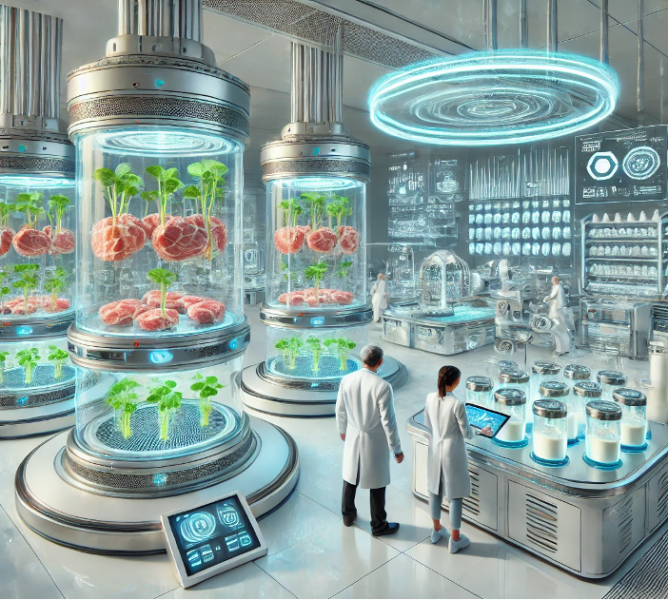
Cultured Meat: From Lab to Marketplace
Cultured meat, also known as cellular or lab-grown meat, is an innovative product created by cultivating animal cells in controlled laboratory conditions. This process begins by taking stem cells from a living animal, which are then cultured in a bioreactor using a nutrient- rich medium that stimulates cell growth and differentiationinto muscle tissue. Cultured meat technology aims to produce aproduct that is identical in taste, texture, and nutritional value to
traditional meat, but without the need to raise and slaughter animals. This could potentially significantly reducethe environmental impact of the meat industry, decrease water and land use, and address ethical concerns associated with livestock farming. Despite technological and regulatory challenges, cultured meat is seen as a promising solution for ensuring sustainable protein production in the future.
The cultured meat and synthetic dairy product industry has made significant strides, transforming the foodindustry and opening up new horizons in sustainable food production.
Market Appeal of Cultured Meat
The cultured meat market is demonstrating impressive growth:
- Market size in 2024: $568.83 million
- Forecast for 2034: $36,569.73 million
- Expected compound annual growth rate (CAGR): 51.64% (2024-2034)
Key Achievements:
- Eat Just: scaling production to tens of thousands of kilograms of meat without animal slaughter
- Aleph Farms (Israel): regulatory approval for the sale of cultured steaks
- SuperMeat: development of «crispy cultured chicken» at a price of $11.79 per pound in large-scale production
Technological Breakthroughs:
- MeaTech: using 3D printing to produce whole cuts of meat based on cells
- Biftek (Turkey): new technologies and serums to reduce production costs
- Hebrew University of Jerusalem study: continuous production using tangential filtration, reducing the cost of culture medium to $0.63 per liter
Synthetic Dairy Products: A Revolution in the Dairy Industry
Synthetic dairy products are innovative alternatives to traditional dairy products created using biotechnology without the involvement of animals. This technology is based on the production of milk proteins (such as casein and whey protein) through fermentation using genetically modified microorganisms, usually yeast or bacteria. These microorganisms are programmed to synthesize proteins identical to those found in cow's milk. The resulting proteins are then combined with plant-based fats, sugars, and other ingredients tocreate products that are as close as possible in taste, texture, and nutritional value to traditional dairy products. Synthetic dairy products offer a sustainable and ethical alternative, potentially reducinggreenhouse gas emissions and the use of land and water resources associated with traditional dairy farming.
Progress in the production of synthetic milk and cheese:
- PerfectDay: expanding sales of lab-grown dairy products in thousands of US stores
- Remilk: opening a large-scale production facility in Denmark for cheese, yogurt, and ice cream
- New Culture: improving the fermentation process, allowing the production of cheese for25,000 pizzas in one run
- Nestle and Danone: active acquisitions of startups producing laboratory dairy products
Perspectives and Challenges
- Regulatory aspects: the need to adapt regulatory frameworks to new food productiontechnologies
- Scaling up production: reducing costs and increasing volumes to compete with traditional products
- Consumer perception: overcoming skepticism and raising awareness of the benefits of culturedproducts
- Environmental aspect: the potential to significantly reduce greenhouse gas emissions andresource use
The development of the cultured food products industry opens up new opportunities for sustainable foodproduction, addressing the global challenges of food security and climate change.
Precision Fermentation
Precision fermentation is a biotechnological process that uses genetically modified microorganisms such asyeast, bacteria, or fungi to produce specific molecules such as proteins, fats, or enzymes. Unlike traditional fermentation, where microorganisms produce a wide range of products, precision fermentation allows for the«programming» of microorganisms to synthesize target compounds with high precision. This method is widelyused in the creation of alternative proteins (e.g., for synthetic milk or meat), enzymes for the food industry,and medical drugs.
Precision fermentation offers a sustainable way to produce complex biomolecules, reducing reliance onanimals and resources, and opening up new possibilities for personalized and innovative products. This technology, which evolved from ancient brewing technologies, has become a key tool in creating innovativefood products:
- Synthetic oils: Production of analogs of coconut and palm oil using genetically modifiedmicrobes.
- Vegan alternatives: Development of plant-based non-dairy cheeses and meat substitutes.
- Corporate initiatives: Nestle, Danone, Mars, General Mills, and Unilever are actively investing in precision fermentation platforms to adapt to future supply chain constraints and changing marketneeds.
- New ingredients: Creation of innovative stabilizers and preservatives.
Market prospects:
- Projected market size of precision fermentation by 2030: $36.3 billion
- Expected compound annual growth rate (CAGR): 44.8% (2024-2030)
Revolution in Non-Alcoholic Beer Production
The production of non-alcoholic beer is a complex technological process aimed at creating a beverage with an alcohol content of no more than 0.5%. There are several main methods: interrupted fermentation (stopping fermentation when the desired alcohol concentration is reached), the use of special yeast strains (unable toferment complex sugars), dealcoholization of finished beer (membrane filtration or vacuum distillation), and controlled fermentation. Each method has its own characteristics and affects the taste profile of the final product.Regardless of the chosen method, the production of non-alcoholic beer requires more complex technologicalsolutions compared to conventional brewing to preserve the characteristic taste and aroma of beer withminimal alcohol content.
Breakthrough Research
Biotechnology startup EvodiaBio has made a breakthrough in improving the taste of non-alcoholic beer:
- Innovative technology: Creating monoterpenes responsible for the hop flavor using baker's yeastcells as biofactories.
Benefits:
- Restoring lost taste and aroma in non-alcoholic beer
- Significantly reducing the environmental footprint compared to traditional hop cultivation
- Water savings: 2.7 tons of water is traditionally required to produce 1 kg of hops
Market Trends:
- Growing demand for non-alcoholic beer: a 20% increase in 2024 compared to the previous year
- Forecast for the non-alcoholic beer market by 2028: $54 billion
Perspectives and Challenges
- Regulatory aspects: The need to adapt regulatory frameworks to new food production technologies.
- Consumer perception: Overcoming skepticism about products created using biotechnology.
- Scaling up production: Reducing costs and increasing volumes to compete with traditional products.
- Environmental aspect: The potential to significantly reduce resource use and greenhouse gasemissions in the food industry.
The development of precision fermentation and innovative technologies in the production of non-alcoholicbeer opens up new horizons in the creation of sustainable and healthy food products, addressing the globalchallenges of food security and climate change.
PHOTOSYNTHESIS, GENETIC MODIFICATION, AND CRISPR IN LIVESTOCK
Modernizing Photosynthesis: Breakthrough Technologies in Plant Breeding
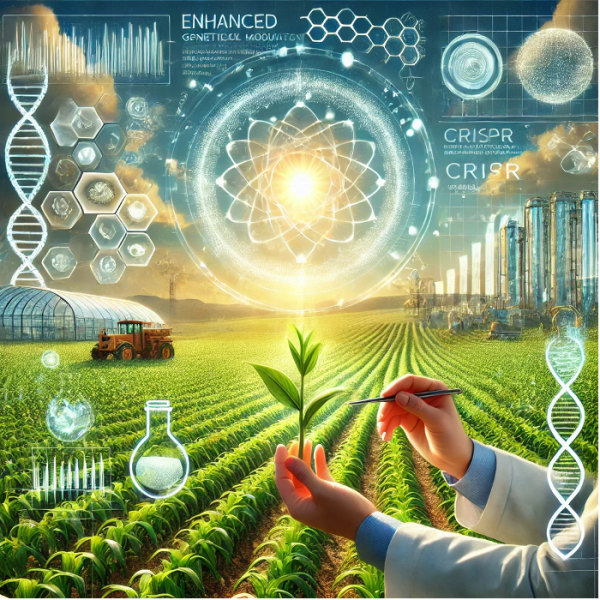
Modernizing photosynthesis is an innovative biotechnological strategy aimed at increasing the efficiency of the photosynthetic process in plants. This technology involves genetic modification and optimization of key components of the photosynthetic apparatus, such as enzymes, pigments, and electron transport chains.The goal of modernizing photosynthesis is to increase the rate ofconversion of solar energy into biomass, increase crop yields, and improve their resistance to environmental stressors. Methods include optimizing the function of the
RuBisCO enzyme, improving mechanisms of protection against photoinhibition, introducing more efficient carbon fixation pathways, and creating artificial photosynthetic systems.
Genetic modification of crops to improve photosynthesis has made significant progress, opening up new horizons in increasing yields without increasing resource consumption.
Optimizing Photosynthesis
Researchers have achieved impressive results in accelerating the photosynthetic quenching process:
- The yield of genetically modified soybeans increased by 20% thanks to an improved photosynthesissystem.
- Promising work is underway to optimize photosynthesis in cowpea and rice
These achievements allow plants to use sunlight more efficiently, adapting to changing light conditions.
Accelerating Tree Flowering
Scientists from the University of Georgia have made a breakthrough in accelerating tree maturation:
Using CRISPR, they managed to reduce the flowering time of poplar from 10 years to 3 months.
A technology has been developed that allows trees to form flowers in a few days instead of a year.
These innovations open up new opportunities for accelerated tree breeding and increasing their resistance toextreme weather conditions.
Eco-friendly Nitrogen Supply
Pivot Bio has developed a revolutionary approach to providing plants with nitrogen:
- The technology increases the ability of soil microbes to supply nitrogen directly to plants.
- The method provides a stable and environmentally friendly supply of nitrogen throughout thegrowing season.
- The solution does not require genetic modification of plants and reduces dependence on syntheticfertilizers.
These innovations in the field of modernizing photosynthesis, accelerating plant growth, and environmentally friendly nutrient supply pave the way for more sustainable and productive agriculture, capable of addressingthe global challenges of food security and climate change.
GMOs in Agriculture
Genetically modified organisms (GMOs) are living organisms whose genetic material (DNA) has beenartificially altered using genetic engineering techniques. This technology allows the introduction of genes from other species into the organism's genome, creating combinations of genes that do not occur in nature. The goalof creating GMOs is to give the organism new properties, such as resistance to pests, diseases, or herbicides, improved nutritional qualities, or increased yield in the case of crops. GMOs are widely used in agriculture, medicine, and industry, but their use remains the subject of scientific and public debate due to potential risks to human health and the environment.
A New Wave of GMOs: Focus on Nutrition
Despite ongoing public skepticism, the new generation of GMOs is focused on increasing the nutritional value ofproducts:
- Pink pineapple from Fresh Del Monte: Enriched with lycopene, a powerful antioxidant.
Purple tomatoes from Norfolk Plant Sciences:
- Approved for direct sale to home gardeners in the US.
- Contain high levels of anthocyanin, which has many beneficial properties.
- The first case of GMO products being available to non-commercial growers in the US.
Changing Public Perception
- A Pew Research study showed that only 7% of Americans consider GMO products to be healthier.
- The new generation of bio-enriched products may change this perception by focusing on increasing nutritional value rather than pesticide resistance.
Perspectives and Challenges
- Increased nutrition: New GMO crops can help address nutrient deficiencies and improve publichealth.
- Educational initiatives: The need to inform the public about the benefits of new agriculturaltechnologies.
- Regulatory challenges: Adapting the regulatory framework to new types of GMOs andagricultural methods.
The development of regenerative agriculture and the new wave of GMOs opens up prospects for creating amore sustainable and healthy food system, capable of addressing the global challenges of climate change andfood security.
CRISPR in Livestock
CRISPR in livestock is an advanced genome editing technology that allows for precise changes to be madeto the DNA of farm animals to improve their characteristics. This technology is used to create animals with increased productivity, disease resistance, improved welfare, and reduced negative environmental impact.CRISPR is used to modify genes responsible for muscle mass growth, meat and milk quality, resistance toviruses and bacteria, and to remove undesirable traits such as horns in cattle. Despite its significant potential, the application of CRISPR in livestock is associated with ethical issues and requires careful assessment of the long-term consequences for animal health and food safety.
CRISPR in Livestock
Disease resistance in fish:
- Auburn University successfully introduced an alligator gene into the catfish genome, increasingits resistance to infections.
- Potential reduction of 40% of losses in aquaculture.
Increased musclemass:
- Japanese scientists have modified the myostatin gene in red sea bream, increasing its mass by17%.
- Experiments are ongoing with supermuscular pigs, cattle, sheep, and goats.
Challenges:
- Unusual side effects such as increased tongue size.
- Problems with the survival of modified animals in infancy.
Perspectives and Challenges
- Ethical issues: The need for careful consideration of the ethical aspects of geneticmodification of animals.
- Regulatory aspects: Adapting the regulatory framework to new genetic modificationtechnologies.
- Environmental risks: Assessing the potential risks of introducing genetically modifiedorganisms into ecosystems.
Thus, the development of CRISPR technologies in livestock opens up new opportunities to address globalfood security challenges, while simultaneously posing complex ethical and regulatory questions for society.
REGENERATIVE AGRICULTURE AND SPACE FARMING
Regenerative Agriculture: Innovations in Agriculture
Regenerative agriculture is an innovative approach to farming aimed at restoring and improvingecosystems rather than simply maintaining the current state or minimizing damage. This system of farmingpractices includes methods that actively improve biodiversity, soil quality, water cycles, and ecosystemservices. Key principles include minimal tillage, cover cropping, crop rotation, integration of livestock andcrop production, and the application of compost and other organic fertilizers. Regenerative
agriculture aims not only to produce food but also to sequestercarbon, increase resilience to climate change, increase biodiversity, and improve nutrient cycling in agroecosystems.
Regenerative agriculture and the new generation of genetically modified organisms (GMOs) have become key trends in thedevelopment of sustainable and healthy agriculture.
Progress in Regenerative Agriculture
Regenerative agriculture is gaining momentum as an effectivemethod for restoring soils and increasing biodiversity:
- Certification: The Regenerative Organic Certified program, launched by the Rodale Institute (USA), sets new standards for soil health, animal welfare, and human rights
- Corporate Initiatives: General Mills has dedicated 1 million acres to regenerative agricultureby 2024, exceeding its plan 6 years ahead of schedule
- Fashion Brands: Patagonia, Timberland, Allbirds, Gucci, and Balenciaga are actively promotingthe use of materials obtained through regenerative agriculture practices
Perspectives of Regenerative Agriculture
РRegenerative agriculture is a promising direction in the development of the agro- industrial complex, withsignificant potential to solve a number of global problems:
Environmental Benefits
- Restoration of degraded soils and increasing their fertility
- Increasing biodiversity of agricultural ecosystems
- Carbon sequestration, contributing to climate change mitigation
- Improving water balance and water quality
Economic Perspectives
- Reducing costs for chemical fertilizers and pesticides
- Increasing yields in the long term
- Creating new markets for environmentally friendly products
- Potential for the development of innovative technologies and equipment
Social Aspects
- Improving public health through the production of higher quality food
- Creating sustainable rural communities
- Increasing food security
Conclusions
- Regenerative agriculture is becoming a key trend in the development of sustainable agriculture, attracting the attention of both large corporations and fashion brands.
- The development of certification and standardization in the field of regenerative agriculture contributes to its wider dissemination and recognition.
- Despite its significant potential, the implementation of regenerative practices faces a number ofchallenges, including the need to adapt to local conditions and overcome the inertia of traditionalfarming methods.
- Successful scaling of regenerative agriculture requires a comprehensive approach, includinggovernment support, investments in research and development, and educational programs forfarmers.
- The integration of regenerative practices with modern technologies, such as precision agriculture andartificial intelligence, can significantly increase the efficiency and attractiveness of this approachfor a wide range of agricultural producers.
Space Farming
Space farming is an innovative technology for growing plants in space or on other planets, developed to support long-term space missions and potential colonization of other celestial bodies. This technologyinvolves creating closed ecosystems capable of supporting plant growth in conditions of microgravity, limited resources, and high radiation. Key aspects of space farming include the development of special nutrient media, hydroponics and aeroponics systems, LED lighting optimized for photosynthesis, and methodsfor recycling water and nutrients.
Research in this area also focuses on breeding plants adapted to space conditions and developing automatedplant care systems. Space farming is not only critical for future space expeditions but can also offer innovative solutions for sustainable agriculture on Earth.
Technological Advances in Space Farming
Satellite technology for precision agriculture
- Development of specialized satellite constellations such as EOS SAT, focused on agriculture
- Use of remote sensing data to monitor crops, predict yields, and assess soil conditions
- Application of artificial intelligence and machine learning to analyze satellite images andprovide accurate recommendations to farmers
Space experiments on growing plants
- Development of hydroponics and aeroponics systems for growing plants in microgravity conditions
- Creation of specialized LED lighting systems optimized for photosynthesis in space conditions
- Experiments on growing various crops on the International Space Station
Technologies for futurelunar and Martian missions
- Development of closed ecosystems for long-term space mission
- Research on the use of lunar and Martian soil for growing plants
- Creation of automated plant care systems in space conditions
Genetic modificationfor space:
- Using CRISPR to adapt plants to the conditions of space, the Moon, and Mars.
- Focus on creating plants resistant to radiation and microgravity.
TechnologicalAchievements:
- New methods for delivering materials for plant gene editing
- Application of big data and machine learning for plant gene analysis
Investments and projects:
- NASA and the German Space Agency are investing in space agriculture projects.
- Projected market size of the space agriculture market by 2030: $3.5 billion.
Perspectives andChallenges
- Increasing the efficiency of terrestrial agriculture through the application of space technologies
- Ensuring food security for future space missions and colonies
- Developing new methods for growing plants in extreme conditions, applicable on Earth
Creating sustainable agroecosystems with a closed resource cycle
- Improving understanding of the impact of the space environment on plant growth and development
- Space research: Potential for creating self-sustaining colonies on other planets.
Conclusions
- Space farming is becoming a pivotal factor in advancing both space technology and sustainableagriculture on Earth.
- The integration of satellite technology, artificial intelligence, and precision agriculture isunlocking new opportunities to enhance the efficiency and sustainability of agricultural production.
- Research in space farming is fostering the development of innovative technologies that can beapplied to address global challenges such as climate change and food security.
- The successful advancement of space farming requires an interdisciplinary approach and close collaboration between space agencies, research institutions, and the agricultural industry.
- Investments in space farming have the potential to create new industries and jobs related to high-techagriculture and space technology.
CLIMATE AND SUSTAINABLE DEVELOPMENT
Environmental DNA and Biotechnology: New Tools forSustainable Development
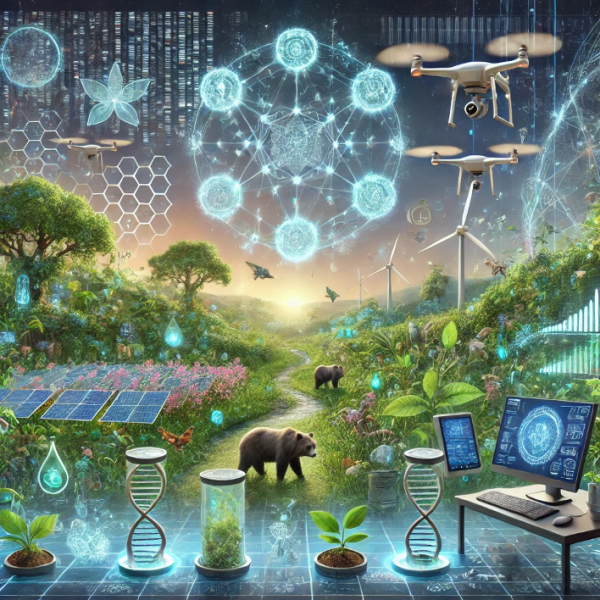
Environmental DNA (eDNA) is an innovative method for monitoring biodiversity based on the analysis of genetic material collected from environmental samples such as water, soil, or air. Thistechnology allows for the detection of various species without the need for direct observation or capture. The method is based on the isolation and sequencing of DNA from cells, tissues, or wasteproducts left by organisms in the environment. eDNA is widely used in ecological research, conservation, assessment of invasive species, and monitoring of rare or difficult-to-
detect species. This technology provides a more complete and accurate picture of ecosystem biodiversity than traditional observation methods and has the potential to revolutionize approaches to environmental monitoringand natural resource management.
Technologies for analyzing environmental DNA (eDNA) and bioengineering have made significant progress, opening up new opportunities for environmental monitoring and sustainable production.
Revolution in environmental monitoring with eDNA
Environmental DNA (eDNA) has become a powerful tool for studying biodiversity and ecosystems:
- The U.S. Geological Survey and the Monterey Bay Aquarium Research Institute have developed an autonomous mobile eDNA sampler for detecting pathogens and invasive species in aquaticecosystems
- Analysis of ancient eDNA from Arctic permafrost has made it possible to reconstruct a 2-million-year-old ecosystem, including coniferous forests, mastodons, and horseshoe crabs
CRISPR n forestry: the path to sustainable wood production
Researchers at North Carolina State University applied CRISPR to optimize the properties of poplar wood:
- Modification of genes associated with lignin synthesis simplified wood processing.
- New tree varieties promise to increase paper production efficiency and reduce carbon emissions
Innovations in plastic recycling
Biotechnological solutions open up new perspectives in the fight against plastic pollution:
- Carbios has developed an enzyme for the efficient breakdown of PET plastic, allowing for theproduction of high-quality recycled plastic.
- Researchers at SLAC and NREL have created a zeolite and cobalt nanoparticle-based catalystfor converting polymers into propane.
- Scientists at the University of Texas at Austin have used machine learning to develop the FAST-PETase enzyme for efficient industrial-scale plastic recycling.
These advances in environmental monitoring, sustainable forestry, and plastic recycling open up new possibilities for addressing global environmental challenges and transitioning to a more sustainableeconomy.
Plants of the future: innovations in the fight against climate change
Research into creating plants capable of effectively capturing carbon is aimed at developing and improving crops and other plant species with an increased ability to sequester atmospheric CO2. This research includesgenetic modification of plants to enhance photosynthesis, optimization of enzyme function (e.g., RuBisCO), improvement of mechanisms of protection against photoinhibition, and the creation of more efficient carbon fixation pathways. The goal of this work is to increase the rate of conversion of solar energyinto biomass, increase crop yields, and improve their resistance to environmental stressors, whilesimultaneously mitigating the effects of climate change by increasing the amount of carbon dioxide absorbed by plants.
Salk Institute Initiative
The Salk Institute for Biological Studies continues to work on an innovative approach to addressing climatechange:
- Development of genetically modified crops with an increased ability to store carbon in the soil
- Focus on creating plants with a more developed root system and higher suberin content
- Goal: to develop varieties of rice, wheat, and corn that combine high yields with effectivecarbon capture
Harvard's Artificial Leaf
In parallel with the work of the Salk Institute, scientists at Harvard University have improved the «artificialleaf» technology:
- Using solar energy to convert atmospheric CO2 and nitrogen into organic forms
- Symbiosis with bacteria that accumulate up to 30% of their mass in the form of CO2 and nitrogen
- Application as an organic fertilizer that contributes to increased yields and carbonsequestration in the soil
Greening the textile industry Professor Fuzhong Zhang from Washington University in St. Louis has made a breakthrough in the production of synthetic spider silk:
- Development of a process for producing silk from microbes with an eightfold increase in yield
- Creation of a material that combines mussel foot proteins with the properties of spider silk
- Achieving a production level sufficient for real-world product testing
Other successfuldevelopments in the field of synthetic textiles:
- Microsilk from Bolt Threads, created based on spider DNA
- Synthetic fibers from the Japanese startup Spiber, used in the production of a limited edition ofcoats
Despite significant progress, integrating biomaterials into existing production chains remains a challenge forthe textile industry.
These innovations open up new perspectives in the fight against climate change and the creation of a sustainable textile industry, but require further research and adaptation of existing production processes..
Reviving Extinct Species and Ecosystems: Biotechnology in the Service of Nature
Ecosystem restoration technology is a comprehensive approach to reviving and rehabilitating degraded,damaged, or destroyed ecosystems. This process involves a range of methods and strategies aimed at restoring the structure, functionality, and biodiversity ofecosystems to their original or near-natural state. Ecosystem restoration technologies can include reintroduction of native plant and animal species, removal of invasive species, restoration of soil cover,improvement of hydrological regimes, and the application of bioengineering solutions for landscape stabilization. This approach often combines traditional ecological knowledge with modern scientific methods and technologies such as remote sensing, GIS modeling, and genetic technologies to optimize the restorationprocess. The ultimate goal is to create self-sustaining ecosystems capable of supporting biodiversity in the longterm.
Ecosystem restoration technologies have made significant progress, opening up new perspectives in the fightagainst climate change and the conservation of biodiversity.
Innovative approaches to ecosystemrestoration.
- Acoustic restoration of coral reefs:
- Successful experiment off Lizard Island (Australia) in attracting marine life using the sounds ofa healthy reef
- Significant increase in biodiversity in the experimental area
2. Reintroduction of key species:
- Release of four bison into a forest near Canterbury (England)
- Goal: to restore natural grazing processes to increase plant biodiversity
Technological innovations in nature restoration
- Development of genetic editing methods to adapt species to modern conditions
- Use of drones and AI for monitoring and supporting restored ecosystems
- Development of biodegradable materials for temporary support of restored habitats
Perspectives and Challenges
- Ethical issues: Debates about the advisability and consequences of reviving extinct species
- Environmental risks: The need for careful assessment of the impact of reintroduced species onmodern ecosystems
- Technological limitations: Difficulty in recreating the complete genome and phenotype of extinctspecies
- Global cooperation: The need for international coordination of efforts to revive and restoreecosystems
The development of technologies for reviving extinct species and restoring ecosystems opens up newpossibilities in the fight against climate change and the conservation of biodiversity, but requires a careful scientific approach and ethical consideration.
CRISPR-engineered mosquitoes and ancient viruses: biotechnology safeguarding human health
Gene drive technology using CRISPR-Cas9 is an innovative method of genetic modification that allows for the rapid spread of certain genes within a population of organisms. This technology uses the CRISPR-Cas9 genome editing system to create self-replicating genetic elements that can overcome Mendelian laws of inheritance and increase the frequency of the desired gene in the population with each generation. Gene drive can be applied to control pest populations, combat disease vectors (such as malaria mosquitoes), or restore endangered species. However, this technology raises serious ethical and environmental concerns due to the potential for irreversible impacts on entire ecosystems and possible unforeseen consequences for biodiversity.
Breakthrough in the fight against malaria
Gene drive technology using CRISPR-Cas9 allows for the safe introduction of antimalarial genes intomosquito populations:
- Potential to reduce malaria mortality, especially among children under 5 in Africa
- Precise genetic editing minimizes the risk of off-target effects
Pilot projects aroundthe world are showing promising results:
- Oxitec conducted field trials of modified OX5034 mosquitoes in Florida and California
- Experiments in Malaysia and Panama demonstrate the potential for global application of thetechnology
New horizons for the application of genetically modified mosquitoes
Researchers are exploring the possibility of using mosquitoes as «flying syringes» for vaccine delivery:
- Scientists at the University of Washington are working on an attenuated form of malaria parasitesto stimulate antibody production
ВChallenges and Ethical Issues
- The need for a thorough assessment of long-term environmental consequences
- Ethical debates about the acceptability of genetic modification of wild populations
The threat of ancient viruses from melting permafrost
Global warming creates new health risks for humanity:
- Melting permafrost can release ancient viruses and pathogens
- Studies show that some «zombie viruses» retain infectivity
- Scientists are calling for proactive monitoring and research to assess and minimize risks
The development of mosquito genetic modification technologies and the study of ancient pathogens open up new possibilities in the fight against infectious diseases, but require a careful scientific approach and ethicalconsideration.
CULTURED BLOOD AND BIOTECHNOLOGY IN BEAUTY
Biotechnology has made significant strides in the production of artificial blood and collagen, opening newhorizons in medicine and cosmetics.
Cultured Blood: A Breakthrough in Transfusion
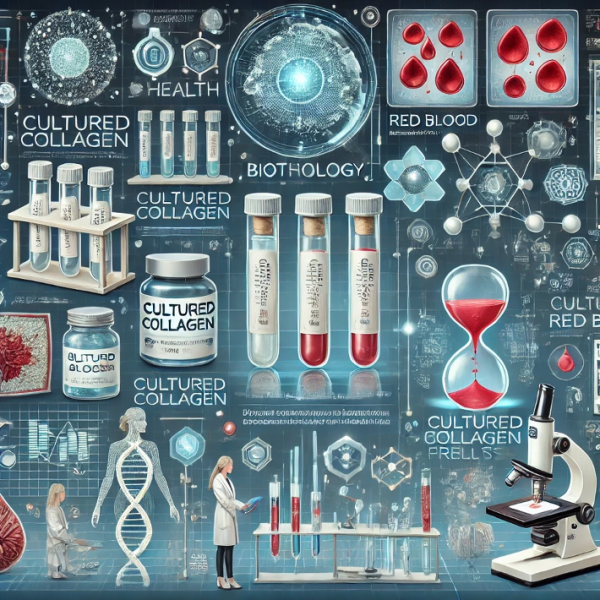
Cultured blood technology is an innovative method for producing blood components, particularly red blood cells, in a laboratory setting without the use of donors. The process begins with theisolation of stem cells (usually from umbilical cord blood or adult bone marrow), which are then cultured and differentiated in specialized bioreactors to produce mature blood cells. This technology utilizes advancements in cell biology, bioengineering, and genetic programming to create functional blood cells that are identical tonatural ones in terms of their properties and functions.
Cultured blood has the potential to solve the problem of donorblood shortages, reduce the risks of infection transmission during transfusions, and provide compatible bloodfor patients with rare blood types or multiple antibodies.
The UK National Blood and Transplant service has achieved a historic success in creating cultured blood:
- Achievement: The world's first successful transfusion of cultured red blood cells into a human.
- Scale: 50 billion red blood cells were produced from 500,000 stem cells
Outlook:
- Increased intervals between transfusions for patients requiring regular transfusions.
- Production of rare blood types for patients with limited access to donors.
Market Perspectives
- РCultured collagen market: Projected volume by 2030 - $1.5 billion, CAGR 26.5% (2024-2030).
- Cultured blood market: Expected growth to $3.2 billion by 2030, CAGR 22.3% (2024-2030)
Challenges and Perspectives
- Scaling production: The need to increase production volumes to meet global demand.
- Regulatory aspects: Adapting regulatory frameworks to new biotechnological products.
- Ethical issues: Discussion of the ethical aspects of using cultured tissues and cells.
- Economic accessibility: Reducing production costs to ensure wide access to new technologies.
The development of collagen and blood culturing technologies opens up new opportunities in medicine andcosmetics, promising revolutionary changes in the treatment of various diseases and improving the quality of lifefor patients.
Development of the Biobank
The UK Biobank has significantly expanded its contribution to global biomedical research by providingscientists with access to the genomic sequences of over 500,000 participants. This vast collection of genetic data has become an invaluable resource for studying the genetic basis of human health and variousdiseases.
The scale and accessibility of the UK Biobank data are impressive:
- More than 38,000 registered researchers from over 90 countries have received approval to usethe data.
- Approximately 10,000 peer-reviewed scientific papers have been published, attracting 2.5million citations.
- 84% of registered researchers work outside the UK, highlighting the global nature of the project.
Research based on UK Biobank data covers a wide range of topics, including the genetic risk factors forAlzheimer's disease.
Cultured Collagen and the Beauty Industry
Cultured collagen technology is an innovative method of producing this essential protein in a laboratory settingwithout the use of animal sources. The process is based on the use of genetically modified microorganisms(usually bacteria or yeast) programmed to synthesize human collagen. The collagen produced in this way isidentical in structure and properties to natural human collagen, making it particularly attractive for the beauty industry. This technology enables the creation of high-quality, hypoallergenic, and ethically producedingredients for cosmetic products, including anti-aging creams, skincare products, and hair care products. Cultured collagen promises to revolutionize the beauty industry by offering more effective, safe, and sustainable alternatives to traditional collagen sources.
Cultured (engineered) collagen: a revolution in the beauty industry
Israeli company Aleph Farms, known for its cultured steaks, has reached new heights in collagenproduction:
- Technology: Production of collagen directly from bovine cells without the need to raise livestock.
- Advantages: Full spectrum of proteins identical to the natural extracellular matrix of skin,bones, and joints.
- Application: A wide range of uses in cosmetics, medicine, and the food industry.
Key Trends:
Laboratory-grown ingredients
- Company Geltor has developed animal-free collagen for anti-aging products, replacingtraditional bovine collagen.
- Amyris uses biosynthesis to produce squalene, a key antioxidant in moisturizers.
Marine biotechnology
- Algenist uses biofermented microalgae in anti-aging products.
- One Ocean Beauty has created a line of ingredients based on marine microorganisms, includingan exopolysaccharide from brown algae and a glycoprotein that increases skin elasticity.
Innovative active ingredients
- Algenist has developed alguronic acid for skin rejuvenation.
- One Ocean Beauty has introduced a microorganism that protects against blue light.
Sustainable production
- Biotechnological methods allow the creation of ingredients with a smaller environmental footprint.
- Reduced dependence on animal-derived raw materials.
These achievements meet the growing consumer demand for effective, ethical, and environmentally friendly products, opening a new era in the beauty and skincare industry.
MICROBIOME RESTORATION:
THE PATH TO SUSTAINABLE HEALTH, BACTERIOPHAGE THERAPY
The Microbiome: Diagnosing Disorders and Restoration
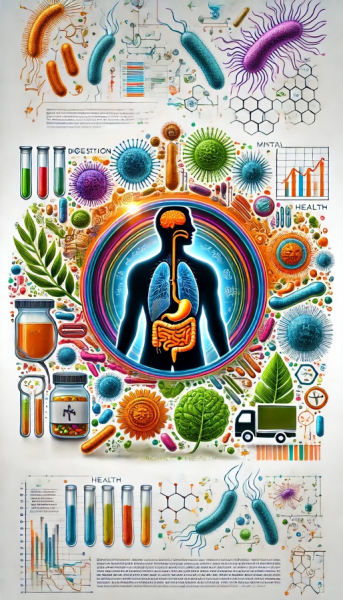
The microbiome is the collection of all microorganisms (bacteria, fungi,viruses, and protozoa), their genes, and metabolites that inhabit a specific environment, such as the human body or an ecosystem. In the context ofhumans, the microbiome includes trillions of microbes that inhabit the skin, mucous membranes, and internal organs, especially the gastrointestinal tract. This complex ecosystem plays a crucial role in maintaining health, participating in metabolism, immune defense, and other vital functions of the body. The human microbiome is unique to eachindividual and can contain 150 times more genes than the human genome.
The study of the human microbiome has made significant progress, opening up new opportunities for home diagnostics and personalizedmedicine.
A Revolution in Understanding the Microbiome
The human microbiome is a complex ecosystem of microorganisms living in and on our bodies:
- ПScale: Contains 150-200 times more genes than the human genome
- Weight: About 2.3 kg
- Localization: Primarily in the intestine, other hollow organs, and on the skin
The Impact of the Microbiome on Health
Research has shown a link between the microbiome and various aspects of health:
- Digestion (e.g., lactose tolerance)
- Predisposition to skin diseases
- Sleep quality
- Risk of developing anxiety and obesity
Factors Affecting theMicrobiome
- Diet and drinking regime
- Smoking
- Exposure to chemicals
- Taking medications
Scientists have established a direct link between the state of the gut microbiome and:
- Metabolism
- Immune system
- Central nervous system
- Cognitive brain functions
Home Microbiome Diagnostics
The development of technology has made it possible to create home tests for analyzing the genetic compositionof the microbiome:
- Ease of use: The ability to conduct a test without visiting a doctor
- Wide availability: Many companies offer home testing kits
- Speed of results: Analysis takes significantly less time than traditional methods
Personalized Probiotics Based on the results of microbiome analysis, companies are developing personalizedprobiotic complexes:
- Goal: Optimizing the symbiotic relationship between the body and microorganisms
- Potential: Alleviating various conditions and improving overall health
Strategies forRestoring the Microbiome
- Diversifying the diet with an emphasis on plant-based foods and fermented products
- Limiting the use of antibiotics in medicine and agriculture
- Developing new methods of fecal microbiota transplantation
The development of technologies for analyzing and modifying the microbiome opens up new horizons inpersonalized medicine, promising more accurate and effective approaches to the prevention and treatment ofvarious diseases.
Restoring the Microbiome: The Path to a Healthy Future
Research on the gut microbiome has made significant progress, revealing the critical importance of microbial diversity for human health and offering new strategies for its restoration.
The Crisis of Microbial Diversity
The modern lifestyle in developed countries has led to an unprecedented decline in microbial diversity inthe human body:
- Widespread use of antibiotics in medicine and livestock
- Prevalence of processed and ultra-processed foods in the diet
- Limited diversity of consumed food products
Studies of modern hunter-gatherer tribes in Tanzania, Peru, and Venezuela have shown that their microbiota is50% richer in bacterial species compared to the population of Western countries.
Innovative Research and Development
- Vedanta 1. Biosciences is developing drugs based on gut bacteria with support from the Bill &Melinda Gates Foundation.
- The American Gastroenterological Association, together with OpenBiome, has initiated a 10-yearstudy of fecal microbiomes in 4,000 patients.
- Development of personalized probiotics and prebiotics to restore microbial diversity.
Restoring the diversity of the gut microbiome is becoming a key task of modern medicine, promising significant improvements in the prevention and treatment of a wide range of diseases.
The Microbiome and Holobiont: The Relationship Between the Organism and Its Microorganisms
- A holobiont is a broader concept and includes the host organism along with all the associated microorganisms, forming a single ecological unit. Thus, the microbiome is an integral part of the holobiont, and humans, for example, are considered a holobiont living in symbiosis with trillions of microorganisms that play an important role in their physiology, immunity, and overall health.
- Research shows that the interaction between the brain and the gut is crucial for overall health.Scientists at the Massachusetts Institute of Technology have developed a technology that uses fiber with sensors and light sources to precisely measure neural signals, providing an understanding of the connection between the gut and the brain.
Other examples of innovative developments include:
- A smart pill designed to diagnose and treat intestinal diseases, which collects data on keybiological molecules and transmits it in real time to the user's smartphone.
- SER-109 from Seres Therapeutics is the first oral microbiome drug to receive FDA approval andhas shown promising results in clinical trials.
- Ayble Health has launched an app that uses behavioral therapy techniques to help patientswith chronic gastrointestinal diseases.
Thus, understanding the microbiome and its impact on health opens up new horizons for the development of personalized medical approaches. The composition of the microbiome is unique to each person and depends on many factors, including diet, physical activity, and environmental conditions.
Research shows that the gut microbiota directly affects the body's response to stress and may be linked to mental disorders. This opens up opportunities for the creation of targeted treatments aimed at the gutmicrobiota to improve brain function.
Given the growing interest in studying the holobiont and its role in human health, microbiome data will becomean important component of a holistic approach to medical assessments. This will allow the development of more effective treatment plans tailored to the individual needs of each patient..
Breakthroughs in Bacteriophage Therapy: New Horizons in the Fight Against Infections
Bacteriophages, or phages, represent a promising solution to the problem of antibiotic-resistantinfections. These viruses, specifically targeting bacteria, open up new possibilities for the treatment anddiagnosis of diseases, but their use also raises a number of ethical and practical questions.
How it works
Bacteriophages work by penetrating bacterial cells and causing their death. Studies show that phages can not only kill pathogenic microorganisms but also restore the sensitivity of bacteria to antibiotics. For example:
- Insilico Medicine uses phages to develop molecules capable of treating various diseases.
- Research at Baylor College of Medicine has shown that acquiring phage resistance can makebacteria more susceptible to antibiotics.
Modern startups are actively exploring the application of phages in various areas:
- Rejuvenate Bio уhas successfully used a reprogramming method to extend the lifespan ofmice.
- Viome Life Sciences has developed tests for detecting biomarkers associated with oral cancer.
The significance of changes
Bacteriophages can become an important tool in the fight against infections, especially in the face of growing antibiotic resistance. Their high specificity allows minimizing the impact on the beneficial microbiota of the organism, making them a safe alternative to traditional antibiotics.
However, widespread implementation of bacteriophage therapy faces challenges such as the need to type pathogens and determine their susceptibility to phages. It is also important to ensure compliance withregulatory requirements and data security.
Overall, bacteriophages represent a promising strategy for addressing the problem of antibiotic resistance and can significantly change approaches to the treatment of infectious diseases in the future.
MICROCHIPS IN BIOMEDICINE
Lab-on-a-Chip Devices
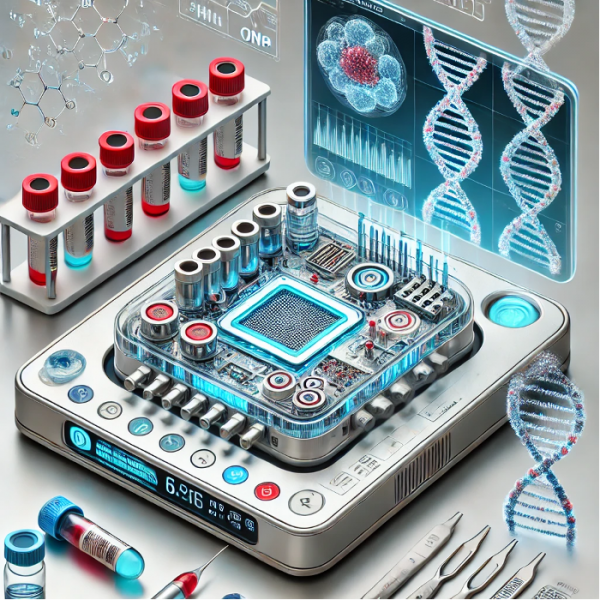
Lab-on-a-Chip (LoC) devices are miniature instruments that integrate one or more laboratory functions onto asingle chip ranging from a few square millimeters to a few square centimeters. These devices enable complexbiochemical analyses and processes using micro or nanoscopic volumes of samples and reagents. Created usingmicrofabrication technologies, including 3D printing, photolithography,
and microfluidics, LoC devices offer high analysis speed, accuracy, and ease of use. They find wide application in molecular diagnostics, DNA analysis, disease detection, and environmentalmonitoring, offering the potential to revolutionize medicaldiagnostics and scientific research.
LoC devices are driving a revolution in point-of-care (POC) diagnostics, integrating sample preparation, testing, and analysison a single microchip. These technologies transform the approach to laboratory analysis, offering portability, convenience, efficiency, and versatility.
Advanced Developments
Modern microchips are capable of performing a multitude of functions. For example, the SiPhox Health kit can test 17 biomarkers, including indicators of inflammation, cardiovascular health, metabolic fitness, and hormonal balance. Kits are available by subscription and cost $95, including access to continuous glucosemonitors and personalized biohacking tools. The company is also developing a home diagnostic device.
At the University of Bath (UK), a prototype device for virus diagnostics called LoCKAmp was created, whichuses LoC technology and can provide laboratory- quality results in just three minutes. This device uses loop-mediated isothermal amplification to amplify specific RNA sequences, allowing for the detection of viruses.Initially developed for the detection of COVID-19, LoCKAmp can be easily adapted to diagnose other pathogens.
Additionally, a new signal processing method for biosensors, developed at the University of California, Santa Cruz, in collaboration with researchers at Brigham Young University, allows simultaneous detection of particles atboth high and low concentrations. This technology can lead to the creation of LoC biosensors capable of detecting multiple analytes simultaneously over a wide range of concentrations. Researchers used an optofluidic biosensorchip with fluorescent detection and a new signal processing method to accurately determine theconcentration of multicolored nanoparticles in a mixture. This technology will be commercialized by Fluxus, a California-based medical device manufacturer.
Innovative Significance
LoC devices are also known as microfluidic chips or microanalysis systems. They are automated miniature laboratories that allow for multiple medical tests to be performed simultaneously. Traditional laboratory analyses often require large volumes of reagents and samples, leading to high costs. LoC significantly reduces sample volumes, contamination risks, and associated costs due to the smaller sample size for accurateanalysis.
Given their compactness and portability, LoC enables rapid real-time analysis due to short fusion distancesin microchannels. This makes the technology invaluable for patient diagnostics and the development of biopharmaceutical products, especially in developing countries with limited resources.
With increasing attention to patient-centered care, the use of consumer LoC for supplementing remote care is expected to grow. In research, LoC devices facilitate high-throughput screening and experiments, allowingresearchers to perform multiple analyses simultaneously and significantly accelerating the pace of discoveries in fields such as genomics, proteomics, and drug development. This will contribute to progress in understanding the mechanisms of diseases and developing targeted treatments.
Organ-on-a-Chip Technology
Organ-on-a-Chip (OoC) technology is an innovative approach to modeling the functions of human organs andtissues in miniature devices the size of a computer chip. These microfluidic systems contain living human cells organized into three- dimensional structures that mimic the architecture and physiological functions of realorgans. Organ-on-a-chip allows for the reproduction of key aspects of organs, including mechanical, chemical, and electrical signals, as well as interactions between different cell types. This technology provides a unique platform for studying organ physiology and pathology, testing drugs and toxic substances, and personalizedmedicine, potentially reducing the need for animal experiments and accelerating the development of newtherapeutics.
Progress in Organ-on-a-Chip Technology
Organ-on-a-chip systems demonstrate superiority over traditional animal testing methods:
- South Korean researchers: developed an artificial nervous system that mimics a consciousresponse to external stimuli.
- Emulate: tested 870 human liver chips, showing better results in predicting drug safetycompared to conventional methods.
- Harvard bioengineers: created a «vagina-on-a-chip» that more realistically mimics the vaginalmicrobiome.
These achievements attract significant attention from venture capitalists and funds, who view OoCtechnologies as the basis for a revolution in drug development.
The development of organoids and OoC technologies opens up new horizons in understanding long COVIDand other diseases, promising to accelerate the development of effective treatments and personalizedmedicine..
Body-on-a-Chip Technology: A New Era in Human Body Modeling
Body-on-a-Chip (BoC) technology is an innovative microfluidic platform that combines several miniature human organs or tissues on a single device. This system consists of interconnected microchannels andchambers in which various types of cells are cultured, mimicking the functions and interactions of organs in the human body. BoC allows for modeling physiological processes, studying the effects of drugs and toxins onthe body, and investigating the mechanisms of diseases under conditions that are as close as possible to realones.
This technology has enormous potential for accelerating the development of new drugs, reducing the need foranimal testing, and creating personalized medicine approaches. These devices allow researchers to model thebehavior of various tissues and organs, mimicking their functions and mechanics. BoC are becoming a potentialalternative to animals in drug development and toxicity testing.
Advanced Developments
«On-chip» models are designed to mimic the physiological states of organs, providing a controlled environment for studying various phenomena. For example, researchers at the University of Birmingham havedeveloped a «vein-on-a-chip» model that mimics human veins and offers a unique platform for studying clot formation. This device includes working valves that reproduce the real mechanisms of veins and a layer ofendothelial cells lining the inside of the vessel.
An international team of bioengineers and immuno-oncologists created an immune-infiltrated kidney tissue model, focusing on studying the off-tumor effects of bispecific T-cell engagers (TCBs). This model, known as an immune-infiltrated human kidney organoid-on-a-chip, allows for the assessment of the impact of TCBs on kidney cells.
Additionally, researchers at Boston University have developed an organ-on-a-chip model to reproduce lymphaticvessels in order to address lymphedema in mice. Biotechnology company Emulate has introduced a new feature to its liver-on-a-chip model - an adeno-associated virus (AAV) transduction application. This technology allows for efficient and safe testing of AAV vector delivery in a validated human liver model, providing results in weeks rather than months. In a previous study, the Emulate liver chip accuratelyidentified 87% of tested drugs known for their liver- damaging effects.
Innovative Significance
BoC systems, also known as microphysiological systems, reproduce the complex interactions of organs andtissues in the human body on a miniature scale. By modeling the interactions between different organs, BoC devices demonstrate how drugs will behave in the human body.
The advantages of BoC include:
- Speed: Faster and more cost-effective alternatives to human or animal testing.
- Ethics: Reducing the reliance on animals in biological research.
- Safety: Increasing the reliability of results due to controlled experimental conditions.
The application of BoC can significantly increase the efficiency of drug screening, reduce the number of failedclinical trials, and accelerate the time to market for new drugs. Despite the enormous potential of BoC in drug development, there are challenges to their adoption, including the need for standardization of protocols andregulatory frameworks for integrating these models into scientific research.
3D BIOPRINTING:
A BREAKTHROUGH IN CREATING FUNCTIONAL TISSUES, ORGANS, AND PHARMACEUTICALS
3D Bioprinting of Organs and Tissues

The rapidly evolving technology of 3D bioprinting involves creatingfunctional structures that mimic the complexity of biological tissues and organs by layering living cells and bioinks. Despite promising prospects, 3D bioprinting faces technical challenges such as ensuring the viability and functionality of printed tissues.
Cutting-Edge Developments
A team from Monash University (Australia) successfully printedliving neural networks consisting of rat brain cells that matured andinteracted like a real brain. Researchers at the University
of Oxford developed a two-layer brain tissue from 3D-printed human neural stem cells that maintained its cellular architecture for weeks in culture thanks to a new droplet printing technology. This marks significantprogress in creating materials with the structure and function of natural brain tissue.
At the University of Sydney, scientists have developed advanced human lung models using 3D structuresgrown from primary human cells. They created two different lung models – healthy and diseased – to study thetherapeutic efficacy of drugs. Researchers at the Terasaki Institute for Biomedical Innovation (TIBI) have made strides in 3D bioprinting skeletal muscle tissue, using specialized bioinks with microparticles for sustained delivery of insulin-like growth factor-1, which promotes the formation of mature skeletal muscletissue.
A multidisciplinary group at Stanford University received a $26.3 million federal contract to bioprint a fully functional human heart and implant it into an immunodeficient pig within five years. This approach utilizes patient-specific stem cells, which would not require immunosuppression when transplanted into the same patient.
Innovative Significance
3D bioprinting is revolutionizing traditional approaches to tissue engineering and regenerative medicine. Byprecisely placing cells in space in a controlled manner, bioprinters can create functional tissues and organs thatare unique to individual patients. This has enormous implications for organ transplantation.
Customizing 3D bioprinting is relevant for reconstructive surgery and preoperative planning: doctors can create implants for specific patients with precise dimensions and characteristics. The ability to incorporate multiple cell types and biomaterials into the printing process allows for the creation of tissues with enhanced functionality. 3D-bioprinted tissues offer a more accurate representation of human physiology compared to traditional 2D cell cultures.
Using these models, researchers can assess the response to drugs and their toxicity with greater accuracy,while simultaneously reducing or even eliminating the use of animals for testing. However, a major challengein 3D bioprinting remains maintaining the viability of larger and more complex tissues. For implanted or large tissues to survive, they must be vascularized to ensure adequate nutrient supply and waste removal.
Researchers continue to explore bioink formulations, printing methods, and post- printing processing strategies to overcome these challenges and ensure the clinical validity of 3D bioprinting technologies.
Breakthroughs in 3D-Printed Drugs
3D drug printing technology is an innovative method of producing pharmaceuticals using three-dimensional printing to create drug forms with specified properties. This process allows for precise control ofcomposition, dosage, release rate, and even the shape of the drug, opening up possibilities for personalizedmedicine. 3D drug printing provides flexibility in manufacturing, allowing for the creation of complex multi-component drugs, drugs with controlled release, and individualized dosages. The technology has thepotential to revolutionize the pharmaceutical industry by providing more effective and personalized treatment,as well as simplifying the production of rare or complex drug forms.
Triastek (China) and Laxxon Medical (USA) are leading the development of 3D-printed drugs:
- Triastek uses Melt Extrusion Deposition (MED®) technology to create complex multi-layer tablets that optimize the delivery of active substances to the body. The company is alsocollaborating with BioNTech to develop RNA therapies using 3D printing.
- Laxxon Medical has developed a stencil printing technology that allows for the production ofdrugs for oral, transdermal, and implantable applications.
These technologies enable the creation of tablets with unique active ingredient release profiles, which isparticularly important for the treatment of chronic diseases and improving patient compliance.
Personalization and Customization
3D drug printing opens new horizons in personalized medicine:
- The ability to adapt dosage and dosage form to the unique needs of the patient.
- Creation of combination drugs «polypills» containing multiple active ingredients with differentrelease times.
An example is the Spritam tablet, developed by Aprecia Pharmaceuticals and approved by the FDA. Itdissolves rapidly in the mouth, making it convenient for patients with epilepsy.
Home Drug Production
A Dream or a Reality?
Research by Professor Leroy Cronin at the University of Glasgow has demonstrated the possibility of synthesizing drugs using 3D-printed reaction vessels. In laboratory conditions, his team successfully synthesized themuscle relaxant baclofen and other drugs. However, the widespread adoption of this technology requires a revision of regulatory standards, including control over equipment and the production process.
Advantages and Challenges
Advantages:
- Acceleration of new drug development.
- Reduced production costs.
- Increased availability of personalized drugs.
Challenges:
- The need to adapt regulatory standards.
- Risks of cyberattacks that could alter drug formulations.
- Limited printing speed compared to traditional manufacturing methods.
The Future of 3D Printing in Pharmaceuticals
In the coming years, the application of 3D printing is expected to expand:
- In pharmacies for the rapid production of individual drugs.
- In hospitals for on-site drug creation.
- In research laboratories to accelerate clinical trials.
Although the technology is still in its early stages of development, it already demonstrates enormous potential to transform the pharmaceutical industry, making treatment more accessible, effective, andpersonalized.
PHARMACEUTICALS, MOLECULAR AND SPATIAL BIOLOGY IN THE AGE OF ARTIFICIAL INTELLIGENCE
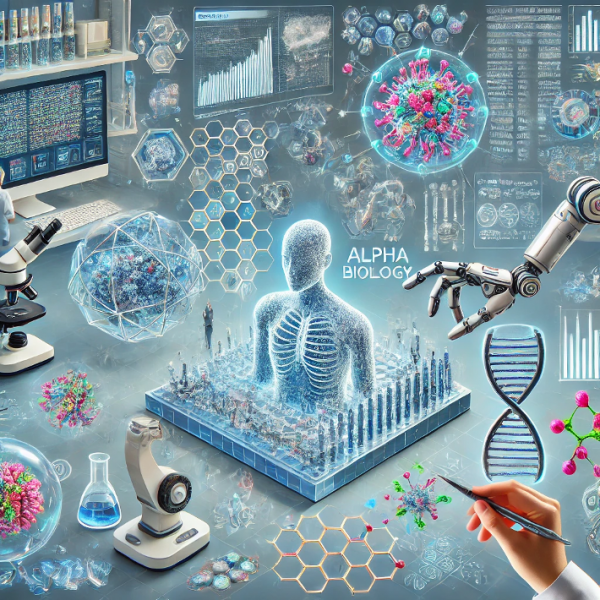
Artificial intelligence (AI) has become an integral part of thepharmaceutical and biotechnology industries, transforming drugdevelopment and healthcare delivery processes.
Investments of pharmaceutical companies in AI
Pharmaceutical giants are actively investing in AI technologies, recognizing the immense potential for optimizing the drugdevelopment process. According to Morgan Stanley, the industry'sannual AI investments could reach $50 billion
by 2034, covering all stages from idea generation to clinical trials and marketing.
Key achievements:
- AstraZeneca applies reinforcement learning in 70% of its small molecule developments.
- E-therapeutics uses AI to design RNA molecules and predict their activity against pathogenic genes.
- DeepMind's AlphaFold breakthrough in predicting protein structures has opened new horizons inidentifying therapeutic molecules.
The rise of generative AI in healthcare
Generative AI (genAI) is gaining widespread recognition in the pharmaceutical and biotechnology industries,particularly in the Asia-Pacific region:
- Singapore's Integrated Health Information Systems, in partnership with Microsoft and OpenAI, isdeveloping a specialized GPT for healthcare on the Azure platform, aimed at improving healthcareworker efficiency.
- In Japan, Tokyo-based startup Ubie is implementing AI tools for analyzing patient interviews, developing SaaS products for hospitals, and AI-powered symptom checkers.
Text-to-Synthetic Compound: Automating chemistry with language models
Large language models (LLMs) can now automate complex chemical tasks:
- ChemCrow: Developed by Philip Schwaller's team at EPFL, uses GPT-4 to solve a wide range ofchemical tasks, including drug synthesis and cost calculation. ChemCrow demonstrated impressiveresults, successfully developing a synthesis plan for atorvastatin and scoring over 9 out of 10 onassessments of 12 chemical tasks.
- Robotic laboratory: Gabriel Gomes from Carnegie Mellon University integrated GPT-4 with a remotely controlled chemistry laboratory, where robotic arms perform reactions based on textinstructions.
Protein design with AI
The technology of creating new types of proteins using artificial intelligence (AI) represents a revolutionary approach in the field of protein engineering and synthetic biology. This method uses machine learningalgorithms and deep neural networks to predict and design three-dimensional protein structures with specified properties and functions. AI analyzes vast amounts of data on existing proteins, their sequences, structures, and functions, to generate new amino acid sequences that can fold into stable and functional protein molecules. This technology allows the creation of proteins with improved or completely new properties that donot exist in nature, opening up broad opportunities for the development of new drugs, catalysts, biomaterials, and other biotechnological products:
- Researchers from MIT, MIT-IBM Watson AI Lab, and Tufts University developed a generative AI model similar to DALL-E 2 to create amino acid sequences of proteins with specified structuralproperties.
- RFdiffusion, created at the Baker Lab Protein Design Institute at the University of Washington,increases the accuracy of protein design by 100 times compared to previous methods.
Generative Biology
- Generate Biomedicines, a Boston-based startup, has developed a platform inspired by DALL-E2 that allows the creation of new therapeutic proteins based on a text description of their shape, size, andfunction.
Modeling molecular interactions
Companies are increasingly using AI modeling instead of physical testing for drug candidate molecules:
- This approach significantly accelerates the drug development process, making it more sustainable,scalable, and potentially more accurate.
- Organizations that adopt AI-based in silico molecular simulations are expected to gain asignificant competitive advantage.
The essence of spatial biology
Spatial biology is an innovative field in biological research that allows studying and visualizing the spatial distribution of molecules, cells, and tissues in biological samples with high resolution.This technology combines transcriptomics, proteomics, and visualization methods to create detailed maps ofgene and protein expression in the context of the three-dimensional structure of tissues. Key methods include spatial transcriptomics, multiplex immunofluorescence, and the BEAM (barcode- enabled antigen mapping)technology. Spatial biology opens up new possibilities for understanding complex biological processes, thedevelopment of diseases, and the development of personalized therapeutic approaches.
Spatial biology focuses on studying cells and tissues in their natural 2D or 3D environment, which can becompared to using GPS technology at the cellular level. This approach allows:
- Mapping the complex architecture of cells with unprecedented accuracy.
- Analyzing cell interactions in the context of their microenvironment.
- Achieving an understanding of biological processes at the molecular and even atomic level.
Advantages over traditional methods
Unlike traditional methods such as mass sequencing, spatial biology provides:
- A more comprehensive understanding of cell interactions.
- The ability to observe complex biological processes in their natural environment.
- The potential to identify subtle mechanisms of disease development
The role of AI in spatial biology
Artificial intelligence plays a key role in the development of spatial biology:
- Generative AI and computer modeling allow the creation of detailed 3D models of cells andtissues.
- Advanced algorithms help analyze large volumes of complex data obtained during research.
- AI contributes to the automation of processes and improving data analysis capabilities.
Perspectives, challenges, and potential influence
The integration of AI and generative technologies in pharmaceuticals and biology leads to strategic changes inhealthcare management and medical research. It is expected to lead to:
- Acceleration of the drug development process.
- Improved diagnostic accuracy and personalization of treatment.
- Optimization of clinical trials.
- Improved analysis of large volumes of medical data.
The AI revolution in biology and pharmaceuticals opens up unprecedented opportunities to improve humanhealth, but requires a careful balance between innovation and ethical considerations. This implies the following achievements:
- Transformation of understanding of cellular mechanics: Just as the James Webb telescope ischanging our understanding of the universe, spatial biology is transforming our understanding of life atthe cellular level.
- A new era of precision medicine: The full potential of spatial biology in diagnostics and thedevelopment of treatments is expected to open up unprecedented opportunities for personalizedmedicine.
- Revolution in disease management: A deep understanding of cellular interactions can lead tothe development of more effective and targeted treatments.
- A paradigm shift in healthcare: Spatial biology is not just technological progress, butfundamentally changes our approach to health and disease.
However, the industry also faces challenges, including the need to ensure patient data privacy, ethical considerations in the use of AI in healthcare, and the need for regulatory frameworks for AI-driven medicaldecisions.
BIOTECH REVOLUTION:
ON THE BRINK OF A NEW ERA
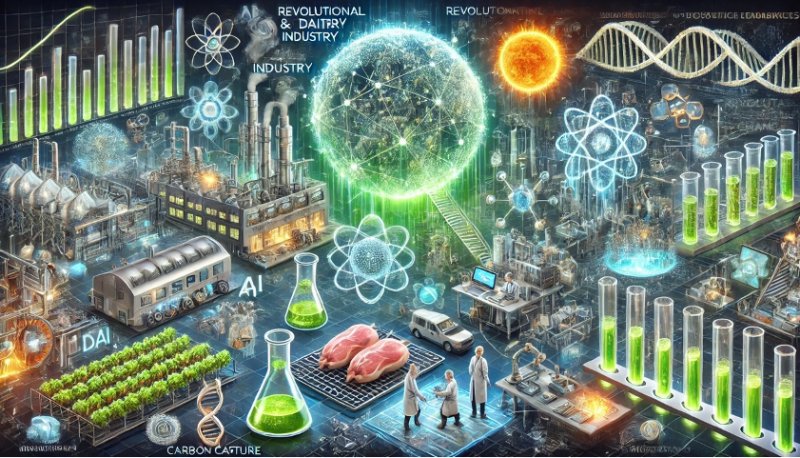
The rapid integration of artificial intelligence into bioengineering has become a powerful catalyst for unprecedented innovation, transforming traditional industries and opening up new horizons in science andtechnology.
Revolutionary Changes in Industry
Traditional sectors such as meat, dairy, textiles, and pharmaceuticals are undergoing radical transformations.
Biotechnologies offer sustainable solutions in carbon capture, plastic recycling, and biodiversity improvement, which is becoming critically
important in the context of global environmental challenges.
Breakthroughs in Healthcare
Anticipated breakthroughs in medicine in the near future promise to revolutionize healthcare but may also lead to serious long-term consequences for society and the economy.
The Economic Potential of CRISPR T
he global market for CRISPR technologies and related products is projected to exceed
$4 billion in the near future. In the US, CRISPR's contribution to GDP is expected to reach $19 billion by 2032, demonstrating the enormous economic potential of this technology.
Challenges, Risks, and Strategic Imperatives for Leaders
Public perception of GMOs:
Despite the fact that modern GMOs are aimed at increasing yields and improving nutritional properties, there isa risk of a new wave of negative reactions due to a lack of public awareness.
Ethical issues of life extension:
Progress in life extension creates not only opportunities but also challenges for social services, pensionsystems, and other support mechanisms for the elderly population.
Supply chain disruptions:
The introduction of new environmentally friendly materials in shipping can lead to serious disruptions intraditional shipping and cold chain operations.
Regulatory pressure:
Regulatory actions raise concerns about potential inhibition of innovation. Legislative measures aimed at reducing inflation may create a more challenging pricing environment and thus affect reimbursementstrategies in the biopharmaceutical industry.
Health inequities:
Revolutionary biotechnological drugs risk exacerbating global health inequities due to their potentialinaccessibility for developing countries.
In this context, leaders need to:
- Deepen their understanding of the potential and risks of bioengineering.
- Lead innovation in products and services.
- Optimize processes and improve materials.
- Seek new opportunities for collaboration and strategic partnerships.
- Explore untapped markets to strengthen competitive advantage.
The convergence of AI and bioengineering opens up unprecedented opportunities but also requires carefulmanagement of risks and an ethical approach to innovation.
Biotech Renaissance: Rethinking the Future
By now, biotech achievements have established themselves as a key driver of global innovation, transforming the economy and society as a whole. This universal technology has a comprehensive impact on various aspects of life, from healthcare to manufacturing, opening up unprecedented opportunities andcreating new challenges.
Biotechnology as a universal technology
By 2030, it is expected that most residents of developed countries will use or consume products createdusing bioengineering technologies. This indicates the deep penetration of biotechnology into all aspects of dailylife.
Transformation of value chains
Advances in biotechnology are radically changing existing business models and value chains. Companies thatfail to adapt to these changes risk losing their competitive advantage and market share to more innovativeplayers.
Expanding horizons of possibilities
The synergy of synthetic biology, CRISPR, artificial intelligence, and engineering opens up new horizons in various industries, including healthcare, pharmaceuticals, agriculture, food, cosmetics, chemicals, energy, and materials production.
Strategic convergence of AI and biotechnology
The merger of artificial intelligence and biology requires leaders to have a deep understanding of the potentialand risks of bioengineering. This is necessary to develop innovative products and services, optimize processes,improve materials, and seek new partnerships.
Inevitability of industry transformations
Traditional industries such as meat, dairy, textiles, and pharmaceuticals are on the verge of significant change. Biotechnological advances open up new opportunities to address environmental challenges, includingcarbon capture, plastic recycling, and biodiversity conservation.
The need for new corporate policies
In light of the rapid development of bioengineering, companies need to develop new policies that reflect theirvalues, ethical principles, and corporate culture. These policies should cover aspects such as the use of genetically modified ingredients, insurance coverage for new genetic therapies, and protection of geneticprivacy.
Horizons of the biotech revolution: forecast for 2025-2045
By the beginning of 2025, bioengineering has established itself as a key «general- purpose technology» capable of transforming the economy and society as a whole. Similar to the steam engine and the internet in thepast, bioengineering has the potential to influence all aspects of life through political, economic, and social structures. It is expected that over the next two decades, advances in biotechnology will affect everyindustry, causing significant changes.
Factors determining the pace of progress:
- Scaling: Despite rapid innovation, the transition from laboratory developments to mass production requires time, discipline, and significant effort.
- Economic efficiency: While biotechnological research remains expensive, there is a trend towardslower prices for components, equipment, and materials. Technological progress is expected to further reduce production costs.
- Barriers to adoption: Even with technological capabilities, the adoption of new biotechnological solutions may be hindered by conservative business strategies.
- Regulatory environment: The pace of technological development often outpaces changes inlegislation. Regulatory uncertainty can both accelerate and slow down industry growth.
- Media coverage: Increased media attention to bioengineering can stimulate interest and investment, especially if information is presented in a form accessible to the general public.
- Public perception: Public understanding and reaction to biotechnological achievements will be keyfactors in shaping demand, especially in areas such as the food industry, consumer goods, cosmetics, pharmaceuticals, and new therapeutics.
- Progress in research and development (R&D): Although the pace of scientific discoveries isdifficult to predict, factors such as funding, the quality of personnel, and access to resources can increase the probability and speed of innovation.
- Given these factors, it can be expected that the biotechnological revolution will develop unevenly in different sectors of the economy. Some industries, such as healthcare and agriculture,are likely to experience faster and deeper changes, while in others, the transformation may occur moregradually.
ON THE BRINK OF BREAKTHROUGH AND CHALLENGE:
INVESTMENT POTENTIAL IN BIOTECHNOLOGY
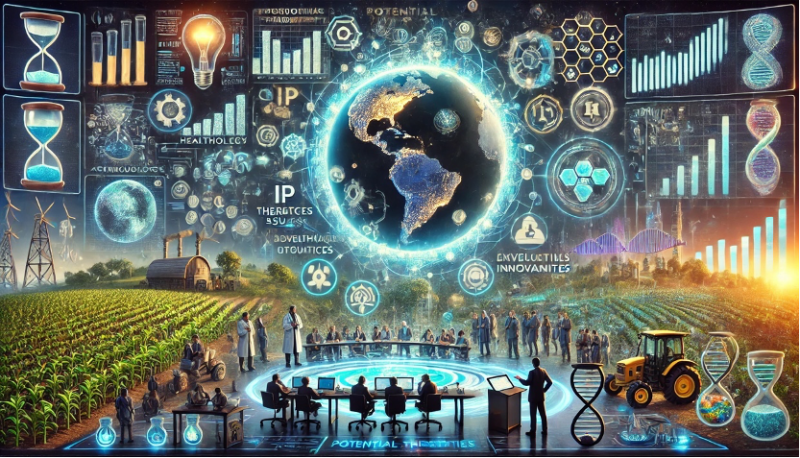
The biotechnology industry is currently on the cusp of revolutionary change, offering unprecedented opportunities while simultaneously creating new challenges and threats for businesses, society, and the environment.
Potential Threats
- Geopolitical disagreements: The lack of a global consensus on bioengineering regulations couldlead to international conflicts in the coming years.
- Intellectual property issues: Unresolved patenting issues in biotechnology could hinderinnovation in various countries.
- Socioeconomic consequences: New agricultural methods, although environmentally friendly, could threaten traditional agrarian communities in developing countries.
- Exacerbation of health inequalities: Limited access to advanced therapies such as CRISPR couldexacerbate global health inequalities.
- Environmental risks: The creation of new organisms and the application of gene editingmethods pose a potential threat to ecological imbalance.
Opening Opportunities
- Rethinking business models: Leaders must reconsider their approaches to products and services inlight of biotechnological advancements.
- Strategic partnerships: Companies need to seek new alliances and talent acquisition channels in thebiotechnology field.
- First-mover advantage: Organizations that adapt to progress in bioengineering in a timelymanner can gain a significant competitive advantage.
- Optimizing financing: Biotech companies should consider new financing strategies, including costoptimization and potential mergers.
- Innovative opportunities: Companies are encouraged to actively explore new directions for innovation and growth, anticipating short-term developments.
- The development of generative biology: Generative biology (genBio) opens up new horizons inthe development of drugs, food, cosmetics, textiles, and other materials.
- Strategic Imperatives
- Ethical leadership: Companies need to align the positions of stakeholders on the moral and ethicalaspects of using bioengineering..
- Proactive approach: Despite seeming premature, it is important to take steps now to integratebioengineering solutions into business processes.
- Risk and opportunity analysis: Organizations should carefully study the potential threats andopportunities associated with the development of biotechnology.
- Scenario development: Leaders are encouraged to develop scenarios for the use and scaling ofgenBio systems, processes, and products.
Biotechnology strategic compass: investments and actions
Currently, the biotechnology industry is on the verge of revolutionary changes, requiring companies to take a strategic approach to investments and actions. Here are the key areas to focus on:
Building the workforce of the future:
Companies need to focus on training specialists with expertise in both artificial intelligence and biology. It is important to start building a talent pool now to meet the future needs of the industry.
Differentiation in a competitive environment:
In a growing environment of venture capital interest in innovative biotechnological platforms, companiesmust clearly define their uniqueness. It is recommended to expand the focus from rare diseases to largeunmet medical needs, thereby providing a more attractive value proposition for investors.
Digital transformation with a focus on AI:
Biotech companies need to undertake a new wave of digital transformation by integrating artificialintelligence into their processes. This includes developing a long-term strategy, an expanded value creationmap, and a comprehensive implementation plan to maintain competitiveness and innovation.
Cultivating flexibility and experimentation:
The convergence of AI and biology opens up broad opportunities for innovation.
Leaders should create an atmosphere in their organizations that encourages experimentation with newproducts and processes to shape the future of the industry, rather than simply reacting to external changes.
Proactive participation in shaping the regulatory environment:
The current uncertainty in the regulatory environment provides a unique opportunity for businesses and government to jointly develop frameworks that address issues of safety, intellectual property, commercialization, and counteracting misinformation.
Strategic foresight and adaptability:
Companies need to use strategic foresight tools to understand how the evolution of the biotech ecosystem may affect their existing products and processes. Continuous monitoring, timely actions, and flexibledecision-making should be prioritized to adapt to AI-bio convergence.
Investments in research and development:
Increasing R&D investments is critical to maintaining competitiveness. Particular attention should be paid to interdisciplinary research at the intersection of biology, informatics, and engineering.
Ethical leadership:
Companies are encouraged to develop clear ethical principles for the application of biotechnology, taking intoaccount the potential social and environmental consequences of their innovations.
A strategic approach to these areas will allow companies not only to adapt to the rapid changes in thebiotechnology industry but also to become leaders in the emerging bioeconomy, shaping the future of theindustry for years to come.
CONCLUSIONS: Biotech Breakthroughs, Convergence, and Challenges
The biotechnology industry is currently undergoing a significant transformation, opening up new horizons andunprecedented challenges. Three key trends define the current state and future development of biotechnology:
- Gene editing: From promise to reality
CRISPR technology, after overcoming a decade of obstacles, is finally realizing its potential. The approval ofCasgevy for the treatment of sickle cell anemia in the UK and US in 2023 was a turning point, demonstrating thepractical application of gene editing. This breakthrough opens the door to a wide range of biotechnological applications, despite ongoing issues of accessibility and public trust.
2. Synergy of AI and biology
Artificial intelligence is becoming an integral part of biological research, significantly acceleratingscientific progress. New AI models accurately predict biological structures, reducing research time from decades to months. Moreover, there is a reciprocal influence: biology isinspiring the creation of new computing systems. Organoid intelligence and DNA computers promise arevolution in computing, offering unprecedented efficiency and energy savings.
3. Business and government unpreparedness for the biotechnological revolution
The rapid development of biotechnology creates both enormous opportunities and serious challenges.Companies in various sectors, from supply chain management to healthcare, risk missing critical changes in theirvalue networks. The need for cyberbiosecurity to protect biotechnological ecosystems from new threats is growing. The lack of a coordinated policy and strategic foresight could lead to a situation similar to the currentproblems with AI regulation, but with potentially more serious consequences.
Key Takeaways:
- Commercialization of CRISPR: The success of Casgevy paves the way for widespread application ofgene editing technologies, despite ongoing accessibility and ethical challenges.
- Biocomputing: The convergence of biology and computing promises revolutionary changes in the efficiency and energy consumption of computer systems.
- Strategic readiness: Businesses and governments urgently need to develop comprehensive strategies to adapt to the rapidly changing biotechnological landscape.
- Cyberbiosecurity: The growing need to protect biotechnological systems from new types of threatsrequires innovative security approaches.
- Ethical regulation: The need for a coordinated global policy for regulating biotechnology isbecoming increasingly acute to prevent potential risks and maximize benefits.
The biotechnology revolution opens up unprecedented opportunities for innovation and progress, butrequires careful risk management and an ethical approach. Companies and governments that can effectively navigate this complex landscape will not only be able to adapt to change but also become leaders in theemerging bioeconomy.
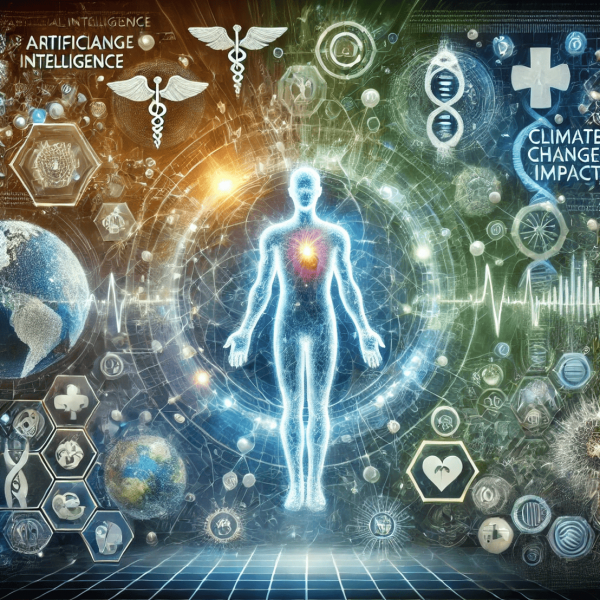
Modern healthcare is undergoing a period of unprecedented change and complexity, driven by a growing demand for medical services, economic challenges, geopolitical instability, and the impact of climate change. These factors necessitate a rethinking of existing approaches and the implementation of innovative solutions. Technological advancements, particularly the development of artificial intelligence (AI), are opening up new horizons, providingopportunities to optimize diagnosis, treatment, and the management of medical data.
However, the integration of new technologies is fraught with numerous challenges, such as data fragmentation, inadequate digital infrastructure, and unresolved issues of ownership andinformation sharing. At the same time, patients are taking a more active role in managing their own health, leading to the formation of new expectations regarding the quality and accessibility of medical care. These trends require adaptation not only from medicalprofessionals but from the entire healthcare system, which must be prepared to implementholistic approaches and focus on patient needs.
This section examines the key challenges and transformations that healthcare is facing in the era of AI. Particular attention is paid to innovative technologies, including digital biomarkers,molecular diagnostics, telemedicine, and smart textiles. Social and ethical aspects, cybersecurity and the fight against disinformation, as well as the prospects for integrating newbusiness models are also analyzed. The presented materials are intended to offer strategic guidance for all industry stakeholders in order to maximize the potential of innovation andovercome emerging barriers.
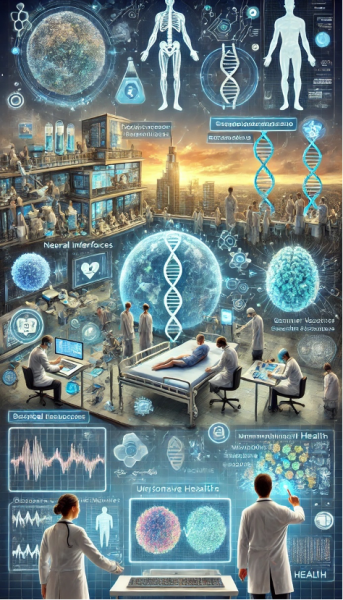
HEALTHCARE:
CHALLENGES AND TRANSFORMATIONS INTHE AGE OF ARTIFICIAL INTELLIGENCE
New Healthcare Challenges
The healthcare system is facing an unprecedented array of challenges.Growing demand for medical services, escalating costs, and supply chain disruptions caused by geopolitical tensions are placing significant strain onthe industry. Climate change is exacerbating the situation, leading to increased rates of disease. Technological innovations offer potential solutions, but their effectiveness is limited by several factors:
- Fragmented medical data
- Insufficiently developed infrastructure
- Lack of clear rules for data ownership and sharing
- These obstacles hinder the implementation of timely and effective healthcare solutions.
Problems with Access and Quality of Healthcare
Healthcare systems are struggling to provide adequate care, especially in rural areas. Telemedicine offers a potential solution, but its implementation is hindered by underdeveloped digital infrastructure and a shortage of qualified personnel in these regions.
The Growing Role of Patients and New Expectations
Healthcare is undergoing a democratization similar to what occurred in the creative industries decades ago. Keyaspects of this process include:
- The proliferation of biometric sensors capable of detecting early signs of various diseases
- Integration of data from multiple devices for comprehensive health analysis
- The development of direct-to-consumer healthcare and wellness services (microbiome analysis,stress level assessment, etc.)
These changes not only expand opportunities for self-management of health but also raise patient expectationsof traditional medical services.
In parallel, there is a trend towards active patient involvement in managing their own health. Thanks toadvanced sensors in smart devices, consumers have unprecedented access to information about their health status. This leads to higher expectations regarding the quality of medical care.
Medical professionals need to adapt to these changes by offering a comprehensive, holistic approach tocare. Professional expertise should not only match but also exceed the information available directly topatients. Otherwise, traditional medical services risk being perceived as redundant.
A shift in the focus of healthcare towards the consumer, whether through smart devices or home-based medical services, creates a need for new services that mimic traditional hospital care. These services canbe both digital (data analysis) and physical (food delivery, care, etc.).
Improvements in sensors in consumer smart devices expand the range of biological information collected.Healthcare providers face the challenge of accessing this data to provide patients with quality care.
Evolution of Health Threats in the Context of Climate Change
The worsening effects of climate change are transforming the global patterns of disease. There is a growing incidence of respiratory diseases in regions exposed to smoke from wildfires, as well as the emergence of zoonotic infections in areas with rising temperatures.
Extreme weather events are having an increasingly significant impact on the physical and mental health ofpeople worldwide:
- In China, there have been cases of forced isolation in shelters due to extreme weatherconditions
- Residents of Arizona have been forced to limit daytime activity due to excessive heat
- In New York, people have been staying indoors for extended periods to prevent asthma attacks
- Global warming is contributing to the spread of disease-carrying insects to new regions:
- Europe is seeing a growth in populations of Asian bush mosquitoes and yellow fever mosquitoes
- Similar trends are being observed in other parts of the world, leading to new health risks for thepopulation.
These changes require adaptation of lifestyles and the development of new public health strategies to protectagainst emerging threats.
Current healthcare is characterized by a holistic approach to human health, considering the complex interconnections between the microbiome, the environment, and technological innovations. Thisapproach opens up new opportunities for disease prevention and treatment, but also poses complex ethicaland practical questions for society.
Breakthroughs in the Treatment of Major Diseases
Against the backdrop of WHO forecasts of increasing mortality from non- communicable diseases (up to 86% of all deaths by 2050), biomedicine is demonstrating promising results, such as:
- Successful trials of a vaccine against pancreatic cancer
- Moderna's plans to develop vaccines against various types of cancer and heart disease by 2030
- CRISPR therapies for treating Alzheimer's disease
- Vaccines for treating autoimmune diseases
- Progress in treating diabetes with semaglutide
Initiatives to reduce the cost of gene therapy, such as a project led by Nobel laureate Jennifer Doudna - the discoverer of CRISPR, could make these innovative treatments available to the general public sooner thanexpected. This could lead to fundamental changes in the structure of healthcare, challenging traditional business models in the industry.
These trends are not only transforming approaches to the treatment and prevention of diseases but also redefining the very concept of health in the context of technological progress and personalized medicine.
A Holistic Approach to the Human Microbiome
Microbiome research has gone far beyond studying the gut-brain axis, now encompassing all ecosystems of the body, including the oral cavity, skin, and reproductive organs. Key achievements include:
- Identification of similar characteristics of the gut microbiome in patients with Parkinson's disease
- Discovery of common characteristics of the microbiome in people living together
- Successful application of fecal microbiota transplantation for the treatment of inflammatorybowel disease
The concept of holobionts, which considers health in the context of the interaction of the host organism with associated microbial communities, opens up new horizons in understanding the influence of the environment on human health. This approach allows for the integration of microbiological research into clinical practice, although a full understanding of the mechanisms of interaction between the microbiome and the human organism remains to be achieved.
The Synthesis of Humans and Technology: The Era of «Synthetic Humans»
The boundaries between the human organism and supporting technologies are rapidly blurring, opening up new possibilities and raising complex ethical questions. Recent advances include:
- Deciphering and recreating sounds and images perceived by the human brain
- Converting thoughts into words using non-invasive AI methods
- Wireless transmission of neural signals to restore motor function in paralyzed patients
- Controlling digital avatars and robots with the power of thought
FDA approval of trials of DeepMind brain implants for patients with paralysis marks a new stage in this field. However, the ethical implications of «reading minds» require careful study and the development of reliable mechanisms for protecting personal information.
Revolution in Medical Diagnosis: ChatGPT Challenges Doctors
Artificial intelligence continues to be actively integrated into medical practice, demonstrating impressiveresults in the field of diagnostics. A recent study published in the Journal of the American Medical Association (JAMA) revealed an unexpected superiority of ChatGPT-4 over doctors in making diagnoses.
Key findings of the study:
- ChatGPT demonstrated an average diagnostic accuracy of 90%
- Doctors with access to ChatGPT achieved 76% accuracy
- Doctors without access to AI showed a result of 74%
These data not only highlight the potential of AI in medicine but also reveal the complexities of human-machineinteraction.
Methodology and participants
The experiment involved 50 doctors of varying experience from major US hospital networks. They were asked toanalyze six complex clinical cases based on real medical histories.
The assessment was conducted by independent experts who did not know whose answers belonged to - thedoctor or the AI.
Difficulties of doctors interacting with AI:
- Strong belief in one's own opinion: Doctors often ignored AI recommendations, even when theywere more accurate.
- Insufficient understanding of AI capabilities: Many used ChatGPT as a simple search engine, notrevealing its full potential.
- Intuitive approach to diagnosis: Doctors often relied on «intuition» and «experience», making it difficult to create algorithms that mimic their thinking.
Prospects for using AI in medicine
- Virtual consultants: AI can become an accessible tool for obtaining qualified medical advice.
- Support for general practitioners: AI can help solve problems that previously requiredconsultation with narrow specialists.
- Optimization of patient routing: More efficient referral of patients to the right specialists.
Ethical and professional challenges
The introduction of AI into medicine raises a number of important questions:
- How will the role of the doctor change in the future?
- Should young people choose a medical career in the age of AI?
- How to find a balance between technological progress and the human factor in medicine?
Despite the impressive results of AI in diagnostics, a complete replacement of doctors by artificial intelligence is unlikely in the near future. However, the medical community must be prepared for significantchanges in practice and a rethinking of the role of the doctor in the age of technology. A key factor in success will be the effective integration of AI into medical practice, where technology complements ratherthan replaces human experience and empathy.
MOLECULAR DIAGNOSTICS, CRISPR IN MEDICINE, AND NUTRIGENOMICS
Perspectives on Molecular Diagnostics
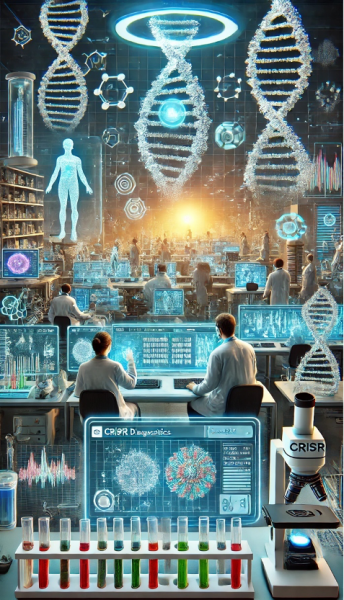
Molecular diagnostics is an advanced laboratory testing method based onthe analysis of DNA, RNA, and other biomolecules to identify genetic, infectious, and oncological diseases at the molecular level. This approachallows for the detection of pathologies at early stages, even before theappearance of clinical symptoms, as well as determining the predisposition to hereditary diseases. Molecular diagnostics utilizestechnologies such as polymerase chain reaction (PCR), sequencing, andnucleic acid hybridization, ensuring high accuracy, sensitivity, andspecificity of analyses. This method is widely used in personalized medicine,allowing for the selection of individual treatment regimens and monitoringthe effectiveness of therapy. This technology enables early disease detectionand facilitates timely intervention, opening up new horizons in personalizedmedical care.
Recent Developments
Researchers are actively developing new tools based on biosensors, which allow for a deeper understanding of biological processes. Examples of such innovations include:
- The University of Oxford has developed a method for analyzing proteins to create an inventory ofproteins in individual cells and tissues, helping doctors identify protein variants associated withdiseases.
- Illumina has introduced PrimateAI-3D, which analyzes 70 million genetic variants to detect harmfulmutations.
- Weill Cornell Medicine has developed a new method for mapping organs that uses spatialsequencing to record gene activity and identify key proteins.
It is also worth noting:
- UCSF Benioff Children's Hospital is implementing rapid whole genome testing to assess risk ininfants with suspected genetic disorders.
- Companies Ultima and Complete Genomics offer platforms for whole genome sequencing at acost of less than $100.
Innovative Significance
МMolecular diagnostics plays a key role in the fight against infectious diseases, allowing for the rapid and accurate detection of viruses and bacteria. This is especially important for the timely adoption of publichealth measures.
The use of CRISPR allows for the development of highly specific tests for the detection of genetic mutationsand pathogens. The integration of this technology into biosensors expands testing capabilities on-site, creatingrapid and accurate diagnostic tools.
Given the expected growth in the application of molecular diagnostics in combination with AI andnanotechnology, it can be assumed that it will become routine practice in patient care. Simplifying access tosuch technologies and their integration with wearable devices and telemedicine platforms will open up new prospects for personalized healthcare.
Breakthroughs in Precision Medicine
Precision medicine is an innovative approach in healthcare that adapts methods of prevention, diagnosis, and treatment of diseases to the individual characteristics of each patient, taking into account their geneticinformation, lifestyle, and environmental factors. This approach is based on the analysis of large amounts of data using advanced technologies such as DNA sequencing and artificial intelligence, which allows for the identification of specific biomarkers, predicting disease risks, and developing personalized treatment strategies. Precision medicine aims to increase the effectiveness of therapy, minimize side effects, and improve overall treatment outcomes, opening up new perspectives in the field of personalized healthcare.
Today, precision medicine is moving to a new level thanks to the use of genome editing technologies such as CRISPR. These innovations make it possible to develop individualized approaches to treatment, adapted to the unique genetic profiles of patients, which significantly increases the effectiveness of medical interventions andminimizes side effects.
Recent Developments
Recent advances in molecular diagnostics and therapy are opening up new horizons for the treatment ofhereditary diseases. For example:
- In the UK, the first CRISPR-based treatment for sickle cell anemia and beta-thalassemia, known as Casgevy (or exa-cel), has been approved. This therapy prevents pain crises and eliminates theneed for regular blood transfusions.
- Researchers from Ohio State University have developed a method that uses CRISPR to analyzegenetic mutations in brain tumors in less than 90 seconds during surgery.
- Seres Therapeutics received FDA approval for SER-109, an oral microbiome drug that has shownpromising results in clinical trials.
Innovative Significance
Precision medicine emphasizes an individualized approach to treatment, allowing doctors to predict a patient's response to medications and prescribe more effective treatment regimens. It also contributes to a deeper understanding of the biology of diseases and the identification of new therapeutic targets. Despite significant achievements, the widespread implementation of precision medicine faces the challenges of accessibility and cost of testing. However, efforts to reduce costs and develop new production models are making thesetechnologies more affordable. In the future, precision medicine can significantly change the approach to treating diseases, improving the quality of life of patients and expanding the possibilities of medical care.
Nutrigenomics: A Revolution in Personalized Nutrition and Health
Nutrigenomics is an interdisciplinary science that studies the impact of human and other living organisms' nutrition on gene expression. It investigates the interaction between biologically active food componentsand the genome, analyzing how nutrients affect gene activity, metabolism, and ultimately, the health of the organism. The ultimate goal of nutrigenomics is to develop scientifically sound personalizedrecommendations for optimal nutrition based on an individual's genetic information to prevent diseases andmaintain health.
Advanced Developments
Research in nutrigenomics involves, in particular, the application of bioinformatics and statistical methods to analyze the links between gene expression and metabolic pathways associated with food consumption.This will make it possible to identify correlations between genetic characteristics and their relationship to the nature of nutrition. Models provide opportunities for in-depth study of the interactions of genes and nutrients, as well as the influence of nutritional factors on epigenetic changes.
Developments in the field of nutrigenomics are carried out in various universities and companies around the world. Here are some key organizations and their achievements:
- University of Toronto (Canada): Professor Ahmed El-Sohemy, founder of Nutrigenomix, conducts research on the interaction of genes and nutrition.
- University of California, Davis (USA): Dr. Bruce German, director of the Foods for Health Institute,studies personalized nutrition and the role of milk components in nutrition and health.
- University of Reading (UK): Conducts research on nutrigenomics and organizes events todisseminate knowledge in this area, for example in Malaysia.
- University College Dublin (Ireland): Organizes the annual NuGO Week conference dedicated tothe molecular basis of healthy and sustainable nutrition.
- Nutrigenomix: Provides comprehensive genetic tests for personalized nutrition, has over 12,000practitioners in 75 countries.
- DSM, BASF, Danone: Large companies actively working in the field of nutrigenomics.
- Xcode Life: In June 2023, launched the Gene Nutrition Test, covering about 50 aspects ofnutrition based on the genetic profile.
Specific results of research in the field of nutrigenomics
- Development of predictive models: Researchers have used machine learning to create a modelthat predicts the success of weight loss based on metabolic markers.
- Application for dietary recommendations: A prototype of an application has been created that uses the «Dietary Rational Gene Targeting» approach to provide dietary recommendations based ongenetic data.
- Personalized solutions for hair loss: GX Sciences, in partnership with GetHairMD, has developedpersonalized solutions for treating hair loss based on genetic data.
- Market growth: The global nutrigenomics market was valued at $448.2 million in 2023 and is projected to grow at a compound annual growth rate of 17.4% to 2030.
These achievements demonstrate that nutrigenomics is actively developing, offering increasingly accurate and personalized approaches to nutrition and health. One of the most important expected results is thecreation of a periodic table of food components based on the systematization and cataloging of molecular food components, similar to how the traditional periodic table organizes chemical elements.
UNIVERSAL VACCINES AND BREAKTHROUGHS IN CANCER IMMUNOTHERAPY
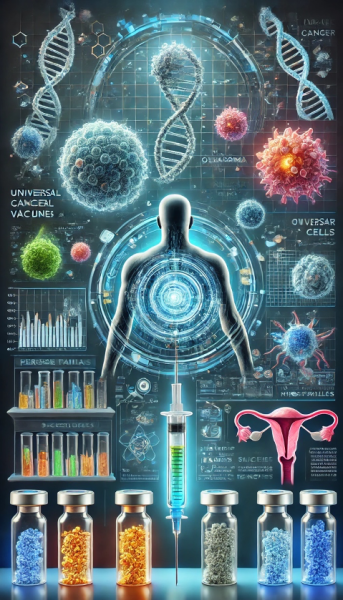
Cancer Vaccines
Cancer vaccines are an innovative immunotherapy technology aimed at stimulating a patient's immune system to fight tumor cells. Unlikepreventive vaccines, they are used to treat an existing disease. These vaccines can be personalized, created based on the genetic profile of aspecific patient's tumor, or universal, targeting antigens common to certain types of cancer. The technology involves the use of various platforms, suchas mRNA, dendritic cells, or oncolytic viruses, to deliver tumor antigensand activate an anti-tumor immune response. Cancer vaccines are at variousstages of clinical trials and show promising results in combination with othertreatment methods.
The development of universal cancer vaccines has made significant progress, opening up new horizons in the treatment of oncological diseases.
Clinical Trials of mRNA-4359
Large-scale clinical trials of the mRNA-4359 vaccine, aimed at treatingsolid tumors, including melanoma, are ongoing in the UK:
- Mechanism of action: The vaccine contains mRNA that instructs cells to produce proteinscharacteristic of tumor surfaces.
- Goal: To teach the immune system to recognize and attack cancer cells.
- Advantage: Universality of application for certain types of cancer without the need forpersonalization.
Progress in the Development of Personalized Vaccines
Companies Moderna and BioNTech continue research on personalized mRNA vaccines against various types ofcancer:
- BioNTech: clinical trials of vaccines against ovarian, breast, and melanoma cancers.
- Moderna: development of a vaccine in combination with the drug Keytruda (Merck & Co.)showed a reduction in the risk of recurrence and death in melanoma.
Perspectives and Challenges
- Efficacy: Preliminary results demonstrate a strengthening of the immune response and a reduction inthe risk of recurrence.
- Universality or personalization: The search for a balance between universal and individuallytailored vaccines.
- Combination therapy: Studying the effectiveness of vaccines in combination with othertreatment methods.
The development of universal and personalized cancer vaccines opens up new opportunities in oncology,promising more effective and less toxic treatment methods. However, further research is needed toconfirm the long-term efficacy and safety of these approaches.
Targeted Drugs or «Magic Bullets» Against Cancer
Targeted drugs for cancer treatment are an innovative class of drugs designed to specifically target specificmolecular targets in cancer cells. These drugs block tumor growth and spread by interfering with specificmolecular mechanisms necessary for carcinogenesis. Unlike traditional chemotherapy, targeted drugs have a higher specificity for cancer cells, which minimizes damage to healthy tissues and reduces side effects.Targeted therapy may involve the use of monoclonal antibodies, tyrosine kinase inhibitors, and other molecules aimed at blocking signaling pathways, growth factors, or angiogenesis processes in the tumor.
In recent years, the strategy for fighting cancer has undergone a radical change, opening up new horizons in the treatment of this insidious disease. Modern oncology has made a significant leap forward, combiningthe achievements of molecular biology, immunology, and bioengineering.
Targeted Therapy: A Precision Strike Against Cancer
Targeted drugs, figuratively called «smart bombs against cancer», continue to improve, demonstratingimpressive results in the treatment of various forms of cancer. These drugs specifically target molecular targets in cancer cells, minimizing damage to healthy tissues. In recent years, a number of new targeted drugshave been developed and used to treat various types of cancer:
Already used drugs
- Lynparza (olaparib) - a PARP inhibitor for the treatment of prostate cancer with BRCA1/2mutations,
- Akeega (niraparib/abiraterone acetate) - a combination drug for the treatment of metastatic castration-resistant prostate cancer with BRCA1/2 mutations,
- Enhertu (fam-trastuzumab deruxtecan) - for the treatment of HER2-positive solid tumors,including prostate cancer,
- Pluvicto (lutetium Lu 177 vipivotide tetraxetan) - radioligand therapy for the treatment ofmetastatic prostate cancer with positive PSMA,
- Lumykras (sotorasib) - for the treatment of non-small cell lung cancer with KRAS G12C mutation.
Targeted drugs under development
- A new targeted drug for the treatment of lung cancer based on KRAS inhibitors,
- Three new targeted drugs for the treatment of gastric cancer, squamous cell carcinoma of the headand neck, and breast cancer are undergoing clinical trials,
- The use of durvalumab in combination with chemotherapy for bladder cancer is being studied,
- The effectiveness of atezolizumab as neoadjuvant therapy for bladder cancer is being studied,
- The drug nadofaragene firadenovec-vncg based on gene therapy is being developed.
Promising Directions
- Development of personalized anti-cancer vaccines based on mRNA technology
- Creation of dual targeted drugs aimed at tumor immune checkpoints
- Development of precision oncology based on the study of the genetic composition of individualpatient tumors
- Development of nanomaterials for more precise drug delivery to tumors
Cancer Immunotherapy: Mobilizing the Body's Defenses
Cancer immunotherapy is a modern treatment method that activates and enhances the body's immuneresponse to fight cancer cells. This approach uses various strategies, including checkpoint inhibitors, monoclonal antibodies, vaccines, and adoptive cell therapy, to help the immune system recognize and destroy tumors. Immunotherapy differs from traditional treatments such as chemotherapy in that it aims to restore the body's natural ability to fight cancer, rather than simply killing rapidly dividing cells. This method has shown high effectiveness in the treatment of various types of cancer, such as melanoma, lung cancer, and kidney cancer, and continues to develop thanks to new research and clinical trials, opening up new opportunities forpatients with oncological diseases.
In recent years, a number of impressive results have been achieved in oncology in several key areas based onimmunotherapy:
CAR-T therapy
- Expansion of the application of CAR-T therapy to new types of cancer, including solid tumors
- Development of «switchable» CAR-T cells (E-SYNC) for the treatment of aggressive glioblastoma
- Creation of CAR-T cells with dual targeting (e.g., CD19/CD22 or CD19/ BCMA) to increaseefficacy
- Research on combinations of CAR-T therapy with other treatment methods, such as cytokines,checkpoint blockade, and oncolytic viruses
Oncolytic viruses
- Genetically modified poliovirus showed 21% survival at 3 years in patients with recurrentglioblastoma
- Development of combination therapy with poliovirus and the chemotherapeutic drug lomustine for the treatment of recurrent glioblastomas
Immunotherapy
- Keytruda (pembrolizumab) and Opdivo (nivolumab) continue to demonstrate efficacy in thetreatment of various types of cancer, including melanoma, non-small cell lung cancer, and kidney cancer
- Development of personalized anti-cancer vaccines based on mRNA technology
- Creation of new tests to identify 18 types of cancer at early stages
Despite significant progress, research continues aimed at overcoming the limitations of existing treatment methods and developing new, more effective approaches to cancer therapy.
Modern approaches to cancer treatment have significantly changed oncology, including the use of vaccines,targeted drugs, and immunotherapy.
Therapeutic cancer vaccines stimulate the immune system to fight tumors, offering universal and personalized solutions. Targeted therapy provides a precise impact on molecular targets, reducing side effectsand increasing treatment efficacy. Immunotherapy, including checkpoint inhibitors and CAR-T therapy,activates the body's natural defense mechanisms. Advances in the development of mRNA vaccines, targeteddrugs, and oncolytic viruses open up new horizons in oncology, promising safer and more effective treatments. However, further work is needed to overcome existing challenges and confirm the long-term safety and efficacy of new approaches.
REVOLUTION IN REPRODUCTIVE TECHNOLOGIES:
SYNTHETIC GAMETES, ARTIFICIAL WOMBS, ANDFETAL SURGERY
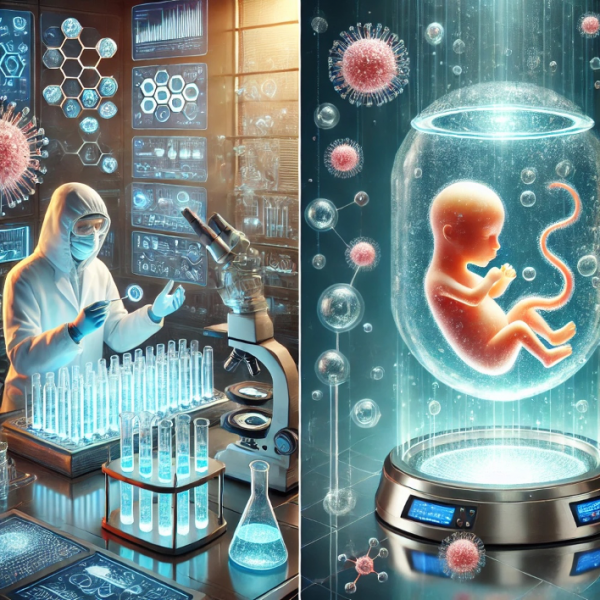
Advances in the creation of artificial gametes, the development of synthetic wombs, genetic modification of embryos, and in utero interventions have opened new horizons in the treatment ofinfertility and neonatal medicine.
Breakthrough in Creating Artificial Gametes
The technology of creating artificial gametes (also known as in vitro gametogenesis or IVG) is an innovative method in reproductive medicine aimed at obtaining eggs and sperm
from other types of cells in the body. The process involves reprogramming somatic cells (e.g., skin or blood cells) into pluripotent stem cells, which then differentiate into germ cells. This technology opens up newpossibilities for treating infertility, especially in cases where there are no own gametes, and also potentially allows for the creation of gametes for same-sex couples or people who have lost fertility due to medical treatment. However, the technology is still at an experimental stage and requires further research toaddress ethical and technical issues.
Dr. Katsuhiko Hayashi from Osaka University has made significant progress in creating eggs from male cells:
- Technology: Converting male skin cells into stem cells followed by chromosome modification(removing Y and duplicating X).
- Result: Successful creation of functional eggs from male mouse cells.
- Perspectives: Potential solution to infertility problems for couples and single people.
Development of the Yamanaka method:
- Creation of gametes from human pluripotent stem cells.
- Potential for producing both sperm and eggs from skin biopsies or blood samples.
Development of Artificial Wombs
The technology of developing artificial wombs is an innovative direction in reproductive medicine aimed at creating devices capable of supporting the development of an embryo outside the mother's body. Thesedevices are complex systems that include containers with nutrient fluid that mimics amniotic fluid, gasexchange systems, nutrient circulation and waste removal systems, as well as mechanisms for regulatingtemperature and hormonal background.
The goal of development is to ensure the survival and normal development of extremely premature babies,and in the future - to fully carry a fetus from conception to birth. Research in this area is being conductedin a number of countries, including the United States, China, and Israel, and successes have already beenachieved in experiments on animals.
Children's Hospital of Philadelphia (CHOP) is preparing for the first human clinical trials of the EXTEND device:
- Achievement: Successful maintenance of the life of premature lambs for 28 days.
- Goal: Improving survival rates and outcomes for extremely premature infants.
- Status: Awaiting FDA approval to begin human clinical trials.
Ethical and Social Challenges
- Accessibility: Questions about equal access to new reproductive technologies.
- Reproductive rights: The impact of synthetic wombs on debates about abortion rights andreproductive choice.
- Social consequences: Potential changes in the concept of pregnancy and parenthood.
Market Perspectives
- Infertility treatment market: Projected volume by 2030 - $47.9 billion, CAGR 8.5% (2024-2030).
- Neonatal equipment market: Expected growth to $9.3 billion by 2030, CAGR 6.8% (2024-2030).
Regulatory Aspects
FDA and independent experts are working to determine:
• Regulatory frameworks for synthetic wombs.
• Ethical protocols for human clinical trials.
The development of technologies for creating artificial gametes and synthetic wombs opens upunprecedented possibilities in reproductive medicine, while simultaneously posing complex ethical andsocial questions that require careful consideration and regulation.
Genetic Optimization of Embryos: Prospects and Challenges
Genetic optimization of embryos is a complex of modern methods used in reproductive medicine to selectand improve the genetic characteristics of embryos before their implantation into the uterus. This technologyincludes preimplantation genetic diagnosis (PGD) and preimplantation genetic screening (PGS), which allowfor the identification of chromosomal abnormalities, genetic diseases, and mutations in embryos at earlystages of development. Using methods such as FISH, CGH, and NGS, specialists can select the healthiestembryos for transfer, increasing the chances of a successful pregnancy and the birth of a healthy child.This technology is particularly important for couples with genetic risks, a history of infertility, or recurrentmiscarriages.
Technologies for genetic modification of embryos have made significant progress, opening up new possibilitiesand raising complex ethical questions.
Progress in analyzing and modifying the embryo genome
Researchers are developing methods to analyze and potentially optimize the embryo genome beforeimplantation:
- Using algorithms to interpret single nucleotide polymorphisms (SNPs)
- The ability to predict predisposition to various diseases, including diabetes and cardiovasculardiseases
- The potential to edit the embryo genome using CRISPR to optimize desired traits
Potential applications
Theoretically, the technology could allow parents to influence various characteristics of their future child:
- Resistance to viral diseases, including HIV
- Reduced risk of neurodegenerative diseases such as Alzheimer's
- Modification of physical characteristics, such as hair texture
Social challenges
- The risk of creating «designer babies» and increasing social inequality
- Issues of informed consent for future generations
- Unforeseen consequences of genetic modifications in the long term
- The need to develop strict ethical and legal frameworks to regulate such technologies
Prospects
The potential to eradicate hereditary diseases and improve the overall human gene pool, but the need tocarefully weigh the risks and benefits.
The development of genetic optimization technologies for embryos opens up unprecedented opportunities toimprove the health of future generations, but requires careful ethical and legal regulation to prevent abuse and unforeseen consequences.
Upcoming developments
Researchers are developing advanced methods to analyze and potentially optimize the embryo genomebefore implantation:
- Using machine learning algorithms to interpret single nucleotide polymorphisms (SNPs)
- The ability to predict predisposition to various diseases, including diabetes and cardiovasculardiseases
- The potential to edit the embryo genome using CRISPR-Cas9 to optimize desired traits
Theoretically, this technology could allow parents to influence various characteristics of their future child:
- Increased resistance to viral diseases, including HIV
- Reduced risk of neurodegenerative diseases such as Alzheimer's
- Modification of physical characteristics
Such intervention could have a permanent, heritable effect, potentially eradicating certain genetic diseases and improving the overall human gene pool. However, this also raises serious ethical questions thatrequire careful consideration before any clinical application.
Intrauterine Interventions: New Horizons in Treatment
Intrauterine interventions are a complex of innovative medical technologies aimed at diagnosing and treating fetal pathologies before birth. These procedures include minimally invasive methods such asfetoscopy, cordocentesis, and amniocentesis, as well as more complex surgical operations on an open uterus. Intrauterine intervention technologies allow for the correction of various fetal developmental anomalies, including heart defects, diaphragmatic hernias, spinal hernias, and other conditions that can threaten the life or health of the unborn child. These methods are constantly being improved, becoming safer and more effective, opening up new opportunities to improve perinatal outcomes and the quality of life of children with congenital pathologies.
Intrauterine procedures are becoming an important area in medicine, allowing for the correction of fetalconditions before birth through surgery or medical treatment. Early intervention aimed at eliminating defects and treating anomalies contributes to improving outcomes for the birth of a healthy child.
Recent developments
Modern technologies significantly expand the possibilities for treating fetuses in the womb. For example:
- A Boston team of doctors successfully performed fetal surgery to treat a malformation of the vein of Galen, in which the blood vessels in the fetal brain are improperly connected.
- The University of California, Davis, performed the world's first stem cell treatment for spinalmuscular atrophy in utero.
- Researchers at the University of California, San Francisco are using in utero stem celltransplantation to treat genetic diseases.
It is also worth noting:
- Fetoscopy technology, which allows for minimally invasive surgeries such as laser coagulation ofvessels in fetal-fetal transfusion syndrome.
- Clinical trials using injections of lipid nanoparticles to edit genes to treat Duchenne musculardystrophy.
Innovative significance
Intrauterine treatment is aimed at eliminating specific medical conditions or anomalies in an unborn child. Fetal surgery allows for the correction of congenital defects and improves outcomes for future patients. However, such methods can be expensive, raising questions about accessibility and medical insurancecoverage. With the growth of genetic testing and gene therapy, intrauterine interventions may become morecommon. Studies show that whole-genome sequencing is more effective for identifying anomalies than targeted gene sequencing. Thus, advances in the field of intrauterine medicine promise significantimprovements in care for future generations, but it is important to ensure access to this technology and provide parents with full information about the potential risks and benefits.
THE QUEST FOR LONGEVITY: ACHIEVEMENTS AND CHALLENGES
Eliminating Senescent Cells

The elimination of senescent (aging) cells, also known as «zombie cells», isan innovative therapeutic approach aimed at selectively removing agingcells from the body to slow down the aging process and prevent age- related diseases. This technology is based on the use of special drugscalled senolytics, which can selectively induce apoptosis in senescent cells without harming healthy cells. Senolytics target key cell cycle enzymes and survival pathways characteristic of aging cells, such as proteins ofthe p53, p21, BCL-2 families, and others. The elimination of senescent cellshas shown promising results in preclinical studies, improving various health indicators and increasing the lifespan of model organisms.
Research in the field of senescent cell removal has made significant progress, opening up new perspectives in the treatment of multiple sclerosis (MS) and other autoimmune and age- related diseases.Accumulating in the body, senescent cells cause chronic inflammation
and contribute to the aging process. Scientists are actively studying the use of senolytic drugs to removethese cells as a potential method for treating various diseases, including MS.
In MS, the immune system attacks the myelin sheath of nerves, leading to impaired nerve impulsetransmission. Although the disease is characterized by alternating exacerbations and remissions, over time it can progress to a stage with continuous worsening of symptoms.
Researchers at Georgetown University conducted an experiment on elderly mice, injecting them with a toxin that damages myelin and then applying senolytic drugs. The results showed that mice treated with senolyticshad a 65% greater increase in the protein involved in myelin repair compared to the control group.
This data indicates the potential of senolytic drugs to improve remyelination and opens up new possibilities forthe treatment of MS, especially at its progressive stage. However, further research is needed to confirmthe effectiveness of this approach in humans.
If clinical trials in humans show positive results, senolytic drugs may become the basis for the development ofnew treatments not only for MS but also for a wide range of age-related diseases and conditions.
Reversing Aging: Breakthroughs in Biology and Genetics
The technology of reversing aging is an innovative approach in biomedicine aimed at slowing down, stopping, or even reversing the aging processes of the organism at the cellular and molecular levels. In addition to theelimination of senescent cells, this technology includes various methods such as genetic engineering,cellular reprogramming, restoration of telomere length, and modulation of epigenetic markers. The goal isnot only to increase lifespan but also to improve its quality by preventing or treating age-related diseases.Research in the field of reversing aging has made significant progress, opening up new perspectives in medicine and biotechnology.
Scientists at Columbia University have developed an innovative technology that allows recording and storinginformation about cellular aging using the CRISPR- Cas system. This «biological video recording» can be thekey to quantifying and potentially reversing aging at the cellular level.
A group of researchers from the Wyss Institute at Harvard University, led by synthetic biologist George Church, has achieved impressive results by combining three gene therapies into a single compound. Experiments on mice have shown the potential of this technology to combat obesity, diabetes, andimprove heart and kidney function.
Interest in aging research has grown significantly, as evidenced by major investments in this area. TheHevolution Foundation, launched by the Saudi royal family, allocates
$1 billion annually to support fundamental research in the biology of aging.
In parallel, the startup Altos Labs, which has attracted $3 billion in investments, is actively developingbiological reprogramming technology. The company has partnered with the Center for iPS Cell Research and Application at Kyoto University to study cellular rejuvenation.
These achievements open up new horizons in understanding and potentially controlling the aging process, promising revolutionary changes in medicine and the quality of human life in the future.
New Horizons in Life Extension
Breakthroughs in synthetic biology and genetic engineering have renewed interest in the design of human life and the extension of its duration. Revolutionary technologies such as artificial wombs and manipulations ofthe human genome create new perspectives but also ethical questions. Changing parenthood, control overaging, and the intentional «design» of humans have a profound impact on science, medicine, and society.
Recent Developments
The idea of genetically modified children continues to be controversial, but researchers are making breakthroughs in reproductive technologies. Key achievements include:
- EctoLife Artificial Wombs: They address the problems of infertility and demographic decline byoptimizing the pregnancy process and genetic material.
- In Vitro Gametogenesis (IVG): The startup Conception is developing a method for creatinghuman eggs from stem cells, offering a chance at motherhood for women who have lost reproductivecapabilities due to cancer or age.
- Investments and New Approaches to Longevity
The anti-aging industry attracts the world's largest investors, such as Jeff Bezos (Altos Labs), Sam Altman, andPeter Thiel. Research includes:
- Blood Rejuvenation: Experiments at Duke University show that components of blood fromyoung organisms slow down aging in mice.
- Rejuvenate Bio Gene Therapy: The method of «reprogramming» cells increased the lifespan ofmice by 7%, returning their cells to a «young» state.
Ethical and Social Aspects
Biotechnology is changing our perception of aging and death: from inevitability to an overcomeable process.However, such achievements carry risks:
- Ethical Dilemmas of CRISPR: Modifying the DNA of embryos promises to eradicate genetic diseases but raises concerns about safety and unpredictable consequences.
- Social Inequality: Access to anti-aging technologies and genetic enhancements can exacerbatethe gap between rich and poor.
Biotechnology offers exciting possibilities for extending life and solving reproductive problems. However,social, ethical, and medical questions remain unresolved. Humanity is on the verge of a new era wheretechnologies can rewrite our very understanding of life, aging, and death.
NEW APPROACHES TO DISEASE DIAGNOSIS:
SMART TEXTILES, BIOSENSORS, AND NANOBOTS
Innovations in Health Monitoring: The Future of Smart Textiles:
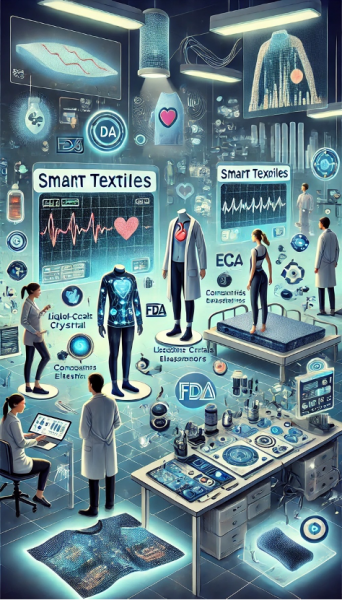
Smart textiles are innovative materials capable of sensing and respondingto various external stimuli and environmental conditions. They incorporate integrated electronic components such as microcontrollers, sensors, and conductors that allow the fabric to perform a variety of functions, fromchanging color and temperaturetomonitoringhumanphysiological indicators.Smart textiles are classified into three generations: passive (sensorfunctions only), active (capable of responding to stimuli), and ultra-smart(adaptive, with elements of artificial intelligence). This technology finds wide application in the production of clothing for the military, athletes, medical purposes, as well as in the creation of innovative interior itemsand the fashion industry.
The integration of sensors into textiles opens up new horizons for non-invasive data collection and enhanced health monitoring. The smarttextile market is expected to grow to
$6.6 billion by 2026, however, scalability remains a significant challenge, as textiles must withstandprolonged use and provide accurate measurements.
Recent Developments
Current research focuses on overcoming the production challenges that hinder the scaling of smart textiles. Forexample:
- Scientists from Aalto University and the University of Cambridge have developed a fabric withliquid crystal elastomers that responds to heat.
- Researchers at Purdue University have created a method for coating fabrics with polymerelectronic sensors to improve breathability and comfort.
- The Massachusetts Institute of Technology has developed 3DKnITs, a knitted textile that cancontinuously determine surface pressure.
Additionally, it is worth noting developments such as:
- PECOTEX - a conductive cotton thread for monitoring breathing and heart activity.
- Master Caution from HealthWatch - the world's first FDA-approved ECG clothing.
Innovative Significance
Embedding sensors into textiles provides a minimally invasive way to collect health and daily activity data. Smart textiles are more versatile and adaptable compared to traditional wearable devices. They offer theability to receive real-time feedback, which contributes to the formation of healthier habits.
However, the widespread adoption of smart textiles faces challenges related to access to technology and theneed to ensure a reliable infrastructure. Nevertheless, it is expected that smart textiles will play a key role inthe transition to personalized care and comprehensive health, opening up new opportunities for healthmonitoring and improving quality of life.
The Future of Biosensors: Innovations in Health Monitoring
A biosensor is an analytical device that combines a biological component with a physicochemical detector to detect chemical substances. It consists of a bioreceptor (e.g., enzyme, antibody, nucleic acid, or cell) thatspecifically interacts with the analyte, and a transducer that converts the biological response into a measurable signal (optical, electrochemical, piezoelectric, etc.). Biosensors are widely used for environmentalmonitoring, disease detection, food safety control, in the defense industry, and drug development. They provide rapid, convenient, and often non- invasive analysis at the point of care or research.
Biosensors are becoming an important tool in healthcare. The integration of advanced data analysis and machine learning methods with biosensors significantly improves diagnostics, enabling the identification ofpatterns and trends in large volumes of data.
Recent Developments
Researchers are actively developing new tools based on biosensors to discover new biological ideas.Examples of such innovations include:
- MindMics and Scripps Research Institute have created wireless headphones that recordheartbeat fluctuations to detect heart disease.
- Ohio State University has developed a wearable sensor for detecting muscle atrophy that uses transmitting and receiving coils in flexible fabric.
- DeepGT, developed by an international group led by the Gwangju Institute of Science andTechnology, uses AI to quantify nanoscale bioparticles, including viruses.
Other examples include:
- HealthWatch with the Master Caution product - the first 12-channel smart ECG clothingapproved by the FDA.
- Sleepiz One+ - a non-contact device for measuring breathing rate and heart rate.
Innovative Significance
Biosensors offer revolutionary possibilities in diagnostics and treatment due to their ability to deliver drugs directly to affected areas, minimizing side effects. They can be used to monitor health status in real time, which is especially important for patients with chronic diseases.
Given the growing use of biosensors in medicine, it is also necessary to consider the potential risks and ethical issues associated with their use. Nevertheless, their ability to cross the blood-brain barrier opens up new horizons for the treatment of neurological disorders.
Thus, nanobots can significantly change the approach to medical treatment, providing more effective andtargeted therapeutic methods. While the military is expected to capture a significant share of the smart textile market, the widespread use of biosensors in everyday life will open up new prospects for personalized health care.
Nanorobots in Medicine: Revolution in Disease Diagnosis and Treatment
Nanorobots(also known as nanobots, nanoids, nanites, or nanomites) are microscopic devices ranging in size from0.1 to 10 micrometers, created from
nanoscale or molecular components. These miniature machines are capable of performing specific tasks at thenanoscale, such as manipulating individual atoms and molecules, delivering drugs, diagnosing diseases, and performing microsurgical operations. Nanorobots can be made from various materials, including organic molecules (such as DNA) or inorganic substances, and can be controlled by external signals or function autonomously in biological systems. Their development is at the intersection of nanotechnology, robotics, and biomedical engineering, opening up new perspectives in medicine, ecology, and industry.
Nanorobots represent a breakthrough in medical diagnostics and treatment, offering precise and minimally invasive methods for targeted action on diseases and improving drug delivery. Despite their potential, questions of material toxicity and genetic modification require careful consideration.
Recent Developments
Researchers are developing new tools using nanorobots to discover new biological possibilities. Examples of suchinnovations include:
- Spiral nanobots, developed by researchers at the Indian Institute of Science, that penetrate dentinal tubules to destroy antibiotic-resistant bacteria.
- Magnetically-controlled nanorobots from the University of Pennsylvania that generateantimicrobial molecules to combat fungi.
- TBY-robots from the Shenzhen Institute of Advanced Technology that can autonomously navigate toinflamed areas of the gastrointestinal tract.
It is also worth noting developments in the field of diagnostics:
- Seres Therapeutics presented SER-109, the first oral microbiome therapy drug approved by theFDA.
- Viome Life Sciences launched Oral Health Pro for the detection of biomarkers associated withoral cancer.
Innovative Significance
Nanorobots offer revolutionary possibilities in diagnostics and treatment due to their ability to deliver drugsdirectly to affected areas, minimizing side effects. They can be used to monitor health status in real time, which is especially important for patients with chronic diseases.
Given the growing use of nanobots in medicine, it is also necessary to consider the potential risks and ethicalissues associated with their use. Nevertheless, their ability to overcome the blood-brain barrier opens upnew horizons for the treatment of neurological disorders.
Thus, nanorobots can significantly change the approach to medical treatment, providing more effective andtargeted therapeutic methods.
IMPLANTS, PROSTHETICS, AND WEARABLES
The Future of Medical Implants
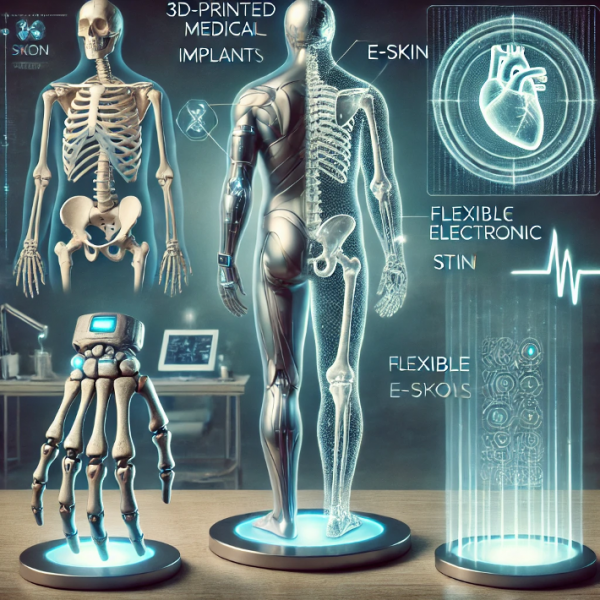
Medical implant technology is an interdisciplinary field of medicine and engineering focused on the development, production, and application of artificial devices or tissues implanted into the human body to replace lost organs, restore their functions, orcorrect pathological conditions. This technology combines the achievements of materials science, bioengineering, surgery, and digital technologies to create biocompatible, functional, anddurableimplantsthatcan integrate with living tissues of the body. Modern medical implant technologies include the use ofadvanced materials,
3D printing, computer modeling, and the application of «smart» implants with built-in sensors for monitoringpatient status and optimizing treatment.
Advances in synthetic biology and 3D printing technologies are opening up new horizons in the creation ofmedical implants. These innovations are aimed at optimizing treatment and restoring body functions usingbiodegradable and biocompatible materials.
Advanced Developments
Modern research focuses on the development of implants that integrate with the human body. Examples of suchtechnologies include:
- Biocompatible water-soluble implants that help relieve pain and are naturally absorbed by thebody after use.
- 3D-printed eye implants used for cell therapy in the treatment of diabetes.
Innovative Significance
The integration of new technologies into medical implants promises a significant improvement in the quality of patient care. These devices can minimize side effects and accelerate recovery, allowing patients to return to a normal life faster.
However, it is necessary to consider the potential risks and ethical issues associated with the use ofsynthetic materials and genetic modification. It is important to ensure the safety and effectiveness of newtechnologies, as well as their accessibility to all segments of the population.
Thus, breakthroughs in 3D printing represent important steps forward in the field of medicine, opening up new opportunities for treatment and improving patients' quality of life.
Prosthetics of the Future: Technologies Changing Lives
Innovations in prosthetics aim to expand sensory capabilities and improve comfort for users through syntheticskin and advanced surgical techniques. Electronic tattoos are almost invisible sensors attached to the skin, providing wireless health monitoring. Such developments are designed to preserve a person's natural appearance and avoid excessive similarity to robotic androids.
Advanced Developments
Scientists at Stanford University have developed electronic skin (e-skin) that converts pressure and heatsignals into brain impulses. The technology mimics natural skin and transmits electrical signals, providing feedback. In experiments, electronic skin caused a reaction in laboratory animals, demonstrating the potential for improving prosthesis sensory capabilities.
Companies such as BeBop Sensors have introduced RoboSkin - a flexible tactile coating that increases thesensitivity of robots and prostheses.
Osseointegration is another important step in prosthetics. The FDA-approved OPRA system replacestraditional socket prostheses with devices with permanent bone fixation. This technology provides:
- Improved mobility and comfort;
- Reduced pain in the residual limb;
- Increased stability and functionality.
Innovative Significance
Innovations are aimed at creating natural and functional prostheses that contribute to increased comfortand self-confidence of users. Synthetic skin not only mimics appearance but also provides sensory feedback through electrical stimulation. Key advantages of technologies:
- Integration of prostheses with the biological body through osseointegration;
- Development of sensory capabilities using electronic skins and sensors;
- Overcoming social stigma and improving the quality of life of users.
However, accessibility remains a challenge. Prosthetics remain expensive and limited, especially for low-income groups. Current developments focus on affordability, functionality, and personalization to meet thediverse needs of users.
The Future of Sensory Technologies
In combination with wearable devices, electronic tattoos and sensors promise to replace many medical devices,providing accurate monitoring of biomarkers and durability. These technologies open up new horizons formedical diagnosis and health monitoring, making them more comfortable and accessible for everyday use.
The Future of Wearable Technologies: The Era of Invisible Opportunities
Wearable technology in medicine is an innovative direction that combines electronic devices designed to be worn on the human body to monitor, diagnose, and manage health. These devices, such as smartwatches, fitness trackers, medical patches, and implantable sensors, are capable of collecting,analyzing, and transmitting data on various health indicators of the user, including heart rate, glucose levels, blood pressure, and sleep quality. By integrating advances in sensor technologies, artificial intelligence,and bioengineering, wearable medical devices allow for continuous monitoring of health status in real time,contribute to early disease diagnosis, personalization of treatment, and increased efficiency of medical care.
The next generation of wearable technologies goes beyond the usual convenience and opens up a new erawhere advanced devices become an integral part of everyday life. Their integration will not only change the perception of the surrounding world but also allow for deeper interaction with it.
Advanced Developments
Competition in the augmented reality smart glasses market is heating up. Apple is rumored to be developing glasses with a display for control and augmented reality support. Meta, in partnership with Ray-Ban, plans tolaunch AR smart glasses in 2027, with future prospects for neural interfaces and device control.
Research is also expanding the potential of wearable devices:
- Cornell University's sonar glasses track user movements in 3D using ultrasound and AI, providingdetailed physical and behavioral data.
- Ai Pin from Humane simplifies interaction by removing screens and focusing on microscopictechnologies. Despite limited healthcare functionality, it shows promise for continuous healthmonitoring.
- The Massachusetts Institute of Technology has introduced an ultrasound scanner that attaches to abra and helps in the early diagnosis of breast cancer.
- Smart bandages from Stanford use electrical stimulation to accelerate wound healing, minimizingthe risk of infection.
Innovative Significance
The expansion of wearable devices contributes to the personalization of medicine and health monitoring at a newlevel:
- Hidden devices are easily integrated into clothing or accessories, making them part of everydaystyle.
- Long-term data collection improves disease diagnosis and prevention.
- Devices with AR and sensor technologies motivate users to adopt healthier habits.
However, challenges remain: protecting personal data and preventing its misuse remain the most important aspects. The future of wearable technologies is aimed at creating solutions that harmoniously combine innovation, comfort, and continuous improvement in quality of life without disrupting a person's usualstyle and rhythm.
Intelligent Breakthrough of Wearable Devices: A Future Without Boundaries
Modernwearable technologies are becoming increasingly complex and functional, providing unique access topersonalized information about health and well-being.
However, rapid progress is changing the approach, making continuous monitoring
possible without additional external devices.
Advanced Developments
A technological shift is observed in the development of smart rings and other miniature solutions. Companies such as Apple and Samsung are patenting technologies for measuring health through compact devices. OmniRing, created by a team from Pennsylvania State University, uses inertial sensors and photoplethysmography to capture movements and analyze biomarkers.
Other devices are also being improved:
- BHeart from Baracoda is a smart bracelet with an «infinite» battery that charges from body heat,movement, and sunlight.
- Neurable and Ikon use brain sensors to track cognitive state and activity during daily tasks.
- Xandar Kardian's XK300 radar technology allows contactless measurement of breathing and heartrate, penetrating US medical institutions.
In Singapore, the Smart Ward system combines smart beds, AI food scanners, and wearable patches for continuouspatient monitoring.
Innovative Significance
Wearable technologies expand the possibilities of health monitoring:
- Real-time measurement of vital signs;
- Tracking cognitive activity and behavior;
- Contactless solutions for continuous monitoring.
These devices now not only collect data but also actively motivate users to improve their lifestyle.However, a paradox arises: the more perfect and «invisible» wearable technologies become, the less theneed for a separate device.
The future of wearable solutions lies in the balance between functionality and their integration intohuman life. Technologies should not only collect data, but also transform it into meaningful actions, making thecontribution to health and well- being as significant as possible.
EXTENDED REALITY TECHNOLOGIES AND BRAIN-COMPUTERINTERFACES
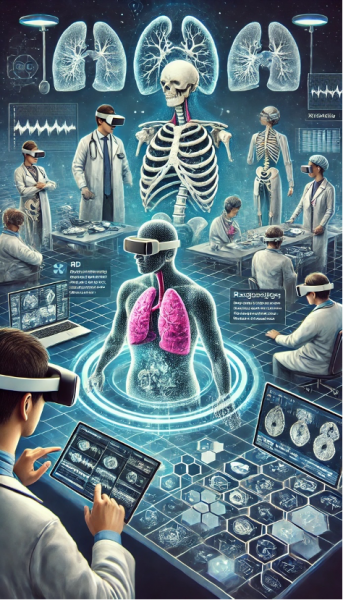
XR Technologies in Medical Diagnosis
Extended Reality (XR) technologies, encompassing virtual reality (VR),augmented reality (AR), and mixed reality (MR), are transforming how we perceive reality by merging the digital and physical worlds. These technologies create immersive environments with varying degrees ofimmersion, from fully virtual worlds to overlaying digital objects onto thereal environment. XR finds applications in various fields, includingeducation, medicine, entertainment, industry, and business, opening up new possibilities for interacting with information and digital objects.
XR technologies are significantly transforming medical diagnosis, offering new ways to interact with medical data, patient information, andanatomical structures. These technologies enable visualization of disease progression, immersive learning, and remote collaboration. Despite the vastpotential, it is necessary to consider issues of data privacy, accuracy, and
compliance with regulatory requirements.
Recent Developments
Artificial intelligence and machine learning algorithms are actively automating the analysis of medical images, facilitating early detection and diagnosis of diseases. Examples of such technologies include:
- Imidex received FDA clearance for the VisiRad XR platform, which detects small nodules inlung chest X-rays.
- Nutex Health integrated DRAid Chest XR into the radiology workflow of its hospitals.
- Michigan Medicine developed DeepGlioma, an AI-based diagnostic system for rapid screening ofgenetic mutations in brain tumors during surgery.
Other innovations include:
- Stable Diffusion, an AI algorithm that analyzes fMRI brain scans to create realistic images.
- Avatar Medical, which received FDA approval for a surgical planning solution using 3D patientavatars.
- GigXR released the Dicom XR Library for generating realistic 3D medical images for training.
Innovative Significance
XR technologies offer healthcare professionals new ways to visualize and interact with data. Using wearabledevices and augmented reality technologies, doctors can integrate patient data in real-time duringexaminations, increasing diagnostic accuracy.
XR also facilitates remote collaboration among specialists, allowing them to share ideas and reach accurate diagnoses faster. Immersive explanations and visualization of medical conditions help patients betterunderstand their symptoms and treatment options.
Given the growing use of XR technologies in medical practice, it is important to address issues of data privacyand regulatory compliance. These technologies promise to become an integral part of future medicine,improving the quality of patient care and increasing diagnostic efficiency.
Expanded Application of Extended Reality in Therapy
Extended reality (XR) technologies are finding increasingly wide application in therapy, offering new solutions for treating various physical and mental illnesses. XR allows for the visualization of disease progression, immersive learning, and remote collaboration. Despite the enormous potential, it is important to consider issues of data privacy, accuracy, and compliance with regulatory requirements.
Recent Developments
Modern research shows that XR can significantly improve treatment outcomes. For example:
- Stanford University is conducting experiments with virtual cognitive- behavioral therapy forpatients with hoarding disorder, helping them practice decluttering skills in a simulated environment.
- NeuroGrow Brain, a brain training program, has demonstrated significant improvements in cognitivetests in patients with ADHD and memory loss.
- Virtuleap, a virtual reality brain training platform, has begun clinical trials of its immersiveexperience using telemedicine tools to monitor patients.
Also worth noting are developments in the field of surgery:
- Avatar Medical introduced a solution for planning surgeries, generating patient avatars from CTand MRI images.
- GigXR released the Dicom XR Library for creating realistic 3D medical images.
Innovative Significance
XR technologies provide healthcare professionals with new ways to visualize and interact with patient data andanatomical structures. Using wearable devices and augmented reality technologies, doctors can integrate patientinformation in real time during examinations, increasing diagnostic accuracy.
Additionally, XR facilitates remote collaboration among specialists, allowing them to share ideas and reachaccurate diagnoses faster. Immersive explanations and visualization of medical conditions help patients better understand their symptoms and treatment options.
Given the growing use of XR technologies in medical practice, it is important to address issues of data privacyand regulatory compliance. These technologies promise to become an integral part of future medicine,improving the quality of patient care and increasing diagnostic efficiency.
Brain-Computer Interfaces: A Breakthrough in Control and Rehabilitation
A brain-computer interface (BCI) is a system that provides direct communication between the brain and an external device. BCI records and analyzes electrical brain activity, converting it into commands to control a computer, prosthesis, or other technical device without using traditional methods of interaction such as movement or speech. This technology can be invasive (with electrodes implanted in the brain) or non-invasive (using external sensors) and is used in medicine to rehabilitate patients with motor impairments,develop new methods of communication and control for people with disabilities, and research brainfunctions. These technologies, including neuroprosthetics, restore motor function through thought and openup new horizons for human-machine symbiosis.
Advanced Developments
BCIs are used to restore speech and mobility. Electrodes implanted in the brain or worn externally can convert neural signals into commands for prosthetics, providing natural limb movement. For example:
- Doctors at the Rehabilitation Institute of Chicago developed a mind- controlled bionic arm for apatient with an amputated arm.
- Neurosurgeons at UCSF used a brain implant to capture signals controlling facial expression and speech, creating a digital avatar for communication.
Future developments, such as Neuralink's BCI chip, aim to enhance cognitive abilities through direct connection to AI. This chip can interact with more than 1,000 brain cells and convert neural signals into computercommands.
Non-invasive BCIs are also being integrated into consumer technologies. For example, the NextMind EEG electrode, acquired by Snap for its augmented reality glasses, is designed to decode neural activity and controlsmart devices.
Significance of Changes
BCI technology represents a breakthrough in medicine and rehabilitation, allowing people with physical limitations to restore lost functions and improve their quality of life. It opens up new possibilities for restoring sensory function and mobility, and provides patients with greater independence.
However, it is necessary to consider the long-term consequences of using implanted devices, including potential tissue damage and deterioration of the nervous system. Many devices are still in the testingphase, raising questions about long-term maintenance and support.
With increased investment in BCI research, their application is expected to expand beyond people with physical and cognitive impairments, to enhance human capabilities in general. This technology cansignificantly change the approach to medical treatment and improve the quality of life for patients.
Digital biomarkers are quantitatively measured physiological, behavioral, or environmental data collected and analyzed using digital devices and technologies, such as wearable gadgets, mobile apps, and remote sensors. This data provides real- time information about a person's health status, disease progression, and response to treatment, enabling continuous monitoring, early detection of health problems, and personalized medical interventions. Digital biomarkers play a crucial role in improving diagnosis, treating diseases, and advancing personalized medicine, providing accurate, individualized medical information and contributing to thedevelopment of predictive and preventive medicine.
Remote health management is actively developing thanks to the integration of digital biomarkers, which collect behavioral and physiological data such as heart rate, blood pressure, and physical activity. This data is collected using digital devices and becomes part of an integrated smart home ecosystem.
Advanced Developments
Modern technologies make monitoring digital biomarkers more accessible:
- Freestyle Libre received FDA clearance to connect to insulin delivery systems.
- Abbott introduced Lingo for measuring glucose levels in non-diabetic individuals.
- Somavedic Technologies launched the Attune Health app for analyzing biomarkers using AI and asmartphone camera.
- The California Institute of Technology developed a patch for microfluidic sweat sampling.
Digital biomarkers are also being integrated into home infrastructure:
- Withings U-Scan measures biomarkers in urine using a sensor in the toilet.
- Apple is developing a bed sensor system for collecting physiological data during sleep.
Innovative Significance
Biosensors integrated into daily life offer a comprehensive view of health. They empower users to make informed decisions for preventive healthcare. However, the integration of such technologies raises questionsabout data security and privacy.
These changes highlight the importance of creating a robust health data infrastructure capable of overcoming standardization and interoperability challenges. The biosensor market is expected to growsignificantly in the coming years, opening up new opportunities for improving personal health management.
The Future of Telemedicine: Innovations and Perspectives
Telemedicine is a form of healthcare delivery using information and communication technologies to provide remote consultations, diagnosis, and patient health monitoring. It includes video conferencing between doctor and patient, sharing medical data and images, remote monitoring of vital signs, andconsultations between medical specialists. Telemedicine increases access to healthcare, especially forpatients in remote areas or with limited mobility, optimizes healthcare processes, and contributes tocontinuous medical education.
Advanced Developments
The global telemedicine market is experiencing steady growth due to the introduction of advanced technologies. Artificial intelligence and machine learning play a key role in providing personalized and predictive recommendations. Telemedicine now extends beyond virtual consultations to include pharmaceutical, translation, and surgical services:
- Midday facilitates communication for healthy aging, supporting women during menopause.
- RxPass from Amazon offers affordable pharmacy services without insurance.
- Voyce provides real-time medical translation in over 240 languages.
- Singapore conducted a groundbreaking robotic telesurgery trial using a Japanese robot.
Innovative Significance
Telemedicine is becoming increasingly popular among consumers: 55% of patients prefer virtual visits to in-person visits. This is especially important for rural communities and underserved populations. Telemedicine services reduce costs for both patients and healthcare providers.
However, challenges with access to digital technologies remain a significant barrier. Global satellitecoverage from Starlink and Amazon's Project Kuiper promises to provide reliable internet access, which willbe a key factor for the successful development of telemedicine.
These changes highlight the importance of telemedicine as a reliable and accessible alternative to traditional healthcare services, contributing to improved healthcare quality and reduced costs.
The Future of Patient Care
Remote Patient Monitoring (RPM) is an innovative healthcare technology that allows healthcare providers to remotely collect, track, and analyze patient health data outside of traditional healthcare settings. RPM uses digital devices such as wearable sensors, mobile apps, and other connected tools to collect and transmit vitalsigns (e.g., heart rate, blood pressure, glucose levels) to healthcare professionals in real time orasynchronously. This technology enables continuous patient monitoring at home or in other remote locations,facilitating early detection of health problems, personalized treatment, and improved overall treatmentoutcomes.
Remote patient monitoring is becoming increasingly relevant in the context of an aging population and thegrowing need for quality healthcare. RPM provides continuous communication between patients and healthcareproviders, using digital technologies to collect and transmit health data outside of traditional healthcareinstitutions.
Advanced Developments
Modern technologies allow patients to easily monitor their health biomarkers. Examples of successfulsolutions include:
- Best Buy, in partnership with Atrium Health, launched a «hospital at home» program that sends specialists to install monitoring technologies for patients.
- Freestyle Libre received FDA clearance to connect to automated insulin delivery systems.
- Abbott introduced Lingo, a wearable device for measuring glucose levels.
- Somavedic Technologies developed the Attune Health app, which analyzes biomarkers using AI.
Singapore conducted an experiment with robotic telesurgery, where a surgeon remotely performed a gastrectomy, demonstrating the potential of RPM in surgery.
Innovative Significance
Remote monitoring allows patients to receive the care they need wherever they are, which is especiallyimportant for people with chronic conditions. It promotes more active patient involvement in managing their health and improves treatment outcomes. «Hospital at home» services help reduce hospitalizations and emergency department visits, leading to significant cost savings for healthcare systems.
However, the implementation of RPM faces challenges related to access to digital technologies and the need toensure reliable connectivity. With the development of satellite technologies such as Starlink and Amazon'sProject Kuiper, high-speed internet access is expected to become more widely available, improving the quality of telemedicine services.
Thus, remote patient monitoring represents a significant step forward in transforming the healthcaresystem, providing more efficient and accessible medical care.
NEW PERSPECTIVES FOR SCIENTIFIC AND CLINICAL RESEARCH IN MEDICINE AND HEALTHCARE
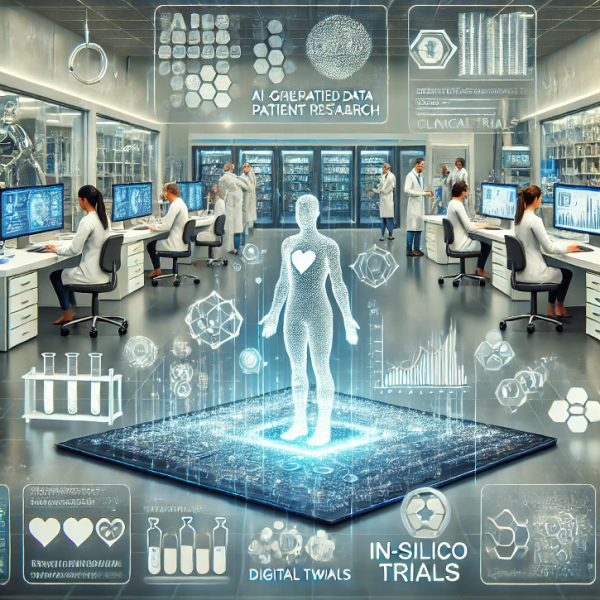
Research in Synthetic Health Data
Synthetic health data is artificially generated medical information that mimics the statistical properties and patterns of real patientdata but does not contain identifiable personal information. Created using machine learning algorithms and statistical models, this data enables medical research, development and testing of healthcare systems, and training of artificial intelligence models for disease diagnosis and prediction, while preserving theconfidentiality of real patients. Synthetic health data is
particularly valuable in situations where access to real medical data is limited due to legal or ethicalconsiderations, or when it is necessary to expand existing datasets to improve the effectiveness ofmachine learning algorithms in medicine. Its application in conjunction with machine learning significantly accelerates research and clinical trials, contributing to the development of new drugs, treatments, andtherapies.
Advanced Developments
Companies are actively using artificial intelligence (AI) and machine learning to advance research. For example, the LabGenius system automates the development, creation, and testing of antibodies, optimizingtheir discovery process. Machine learning algorithms design antibodies to combat specific diseases, whilerobotic systems create and grow them in the laboratory. The data is fed back into the algorithm, creating aclosed-loop system.
DeepMind has released a catalog of genetic mutations that can affect the functions of human proteins.Using the AlphaMissense model, AI classified 89% of the 71 million possible variants as likely pathogenic or benign. This can accelerate research by providing information about the consequences of genetic mutations.
Generative AI also plays a key role in creating synthetic datasets that closely resemble real data without violating privacy. The Snowflake platform offers access to such datasets, including synthetic data onindividuals and financial data. This allows companies to train AI algorithms and conduct testing while preservingdata confidentiality. Additionally, Gretel has entered into an exclusive agreement with AWS, providing access tosynthetic data generation models and privacy tools.
Innovative Significance
Synthetic health data replicates the characteristics, patterns, and statistical properties of real datawithout compromising patient privacy. In the face of a shortage of «real» data, synthetic data becomes invaluable for ensuring the completeness of research. AI can significantly reduce the time required forresearch and clinical trials, providing industries with the flexibility to innovate.
The use of synthetic data allows medical researchers to apply AI and machine learning to critical tasks suchas:
- Rapid drug development: Synthesizing data on drug efficacy, screening compounds, predictingside effects, and optimizing dosages.
- Early diagnosis: Modeling disease progression and predicting risk factors.
- Disease containment strategies: Modeling disease spread to identify preventive measures.
The analysis of large synthetic datasets becomes a valuable tool for advancing therapy research, optimizing treatments, and accelerating the development of new treatments for diseases.
Innovations in Clinical Trials: New Horizons
Traditional clinical trials face challenges related to duration and high costs, which can average 10 years.However, remote, virtual, and in-silico trials are now becoming viable alternatives.
Remote, virtual, and in-silico clinical trials are innovative approaches to conducting clinical research that utilize modern technologies to optimize the drug development process.
- Remote trials allow participants to be located outside of the research center, using telemedicineand mobile devices to collect data.
- Virtual trials are conducted entirely in a digital environment, without the need for participants to bephysically present.
- In-silico trials use computer modeling and simulations to predict the efficacy and safety ofdrugs on virtual organs or systems of the body.
These methods aim to accelerate drug development, reduce costs and risks, and increase access to clinicaltrials for a wider range of participants. The drive for faster development of new drugs and treatments canbe achieved through increased efficiency, accuracy, and speed of clinical trials.
Advanced Developments
In May 2023, the FDA (U.S. Food and Drug Administration) issued an important guideline encouraging the use of remote clinical trials that employ digital tools for remote data collection from participants. The draft guidance on decentralized clinical trials provides recommendations for the safe and strategic implementation of such trials, contributing to increased diversity in participant groups and demonstrating a clear shift towards technology in conducting clinical research.
Companies are successfully transitioning from hybrid interventions to fully remote clinical trials. For example, the GROWell strategy achieved an 82% study completion rate while reducing screening failures and increasingparticipant adherence.
In-silico trials aim to completely eliminate human involvement through digital simulations or digital twins.Nova-discovery, a company specializing in in-silico clinical trial modeling using AI, successfully predicted the results of the MARIPOSA Phase III clinical trial using its jinkō platform. The predictive results closely aligned with the actual trial results, highlighting the potential of in-silico approaches to optimize the development ofnew treatments.
Additionally, Accenture Ventures has invested in Virtonomy, which uses digital twin technologies for data-driven modeling, accelerating the development of critical medical devices. Virtonomy's solution allowsmanufacturers to create virtual environments for testing patient models, reducing costs and simplifying the regulatory process.
Innovative Significance
Modern innovations in clinical trials aim to reduce time to market while maintaining or improving quality and minimizing drawbacks. The COVID-19 pandemic accelerated the adoption of remote app-based trials, which demonstrated their effectiveness in speeding up processes without compromising quality.
Key benefits of remote trials include:
- Increased accessibility: Remote trials provide broader participation from diverse demographicgroups.
- Optimized data collection: The digital aspect allows for more efficient data collection.
- VR trials: The next generation of research will include virtual reality, giving researchers greatercontrol over the trial environment.
In-silico clinical trials use AI and VR to completely eliminate human involvement and employ synthetic data to obtain results comparable to traditional studies. This can halve the duration of trials. Regulatorslike the FDA are exploring ways to integrate in- silico data into the drug approval process and are developing regulatory frameworks to ensure the reliability of results.
Remote, VR, and in-silico clinical trials represent a significant shift from traditional healthcare practices,which have remained largely unchanged for a long time. Their optimized processes will make research more efficient and cost-effective, and significantly reduce the time it takes for new medical innovations to reach the market. Accelerated trials and shortened funding timelines will change the investmentlandscape, allowing new entrants to compete without the need for significant capital investment. Reducedrisks may encourage companies to undertake ambitious projects, leading to a new wave of innovation inmedicine.
BUSINESS PROCESSES IN HEALTHCARE:
THE INFLUENCE OF BIG TECH
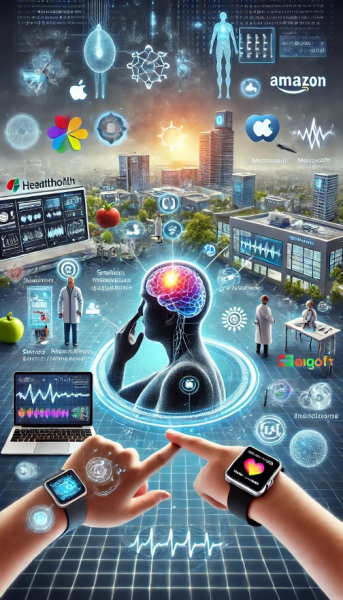
The Impact of Big Tech Companies
The healthcare industry is undergoing significant transformations driven by
major technology companies that are actively introducing innovations andexpanding their services in this sector.
Technological giants are addressing a number of healthcare challenges, including rising costs, staffing shortages, and an aging population. Leveraging their vast user bases, advanced technologies, and data access, these companies are filling gaps in the system:
- Meta has patented wearable medical devices for measuring biomarkers andbrain activity.
- Apple introduced a new feature in Apple Watch to measure sunexposure using sensors and GPS.
- Samsung launched the Open Innovation Initiative in collaboration with universities to expand its digital health ecosystem and introduced the B.well Connected Health platform for creating longitudinal health records.
- Salesforce updated Health Cloud, adding features for home care planning and real-time patient dataaggregation.
Advanced Developments
The involvement of big tech companies is fostering a consumer-centric approach to healthcare. Each companyoccupies its own niche:
- Apple focuses on lifestyle and personal well-being.
- Amazon prioritizes primary care.
- Microsoft provides technological infrastructure, including cloud solutions and AI.
- Google offers a diversified portfolio of services, including research and improving healthcareaccess.
As new technologies emerge on consumer devices, patients expect more personalized care focused on long-term well-being and preventive care. This underscores the importance of collectingpersonal data to provide tailored solutions.
These changes necessitate the adaptation of traditional healthcare institutions to new realities where technology plays a pivotal role in improving healthcare quality and accessibility.
Startups and DTC Models
The Direct-to-Consumer (DTC) healthcare model is an innovative approach where healthcare providers or companies interact directly with patients, bypassing traditional healthcare channels. This model offers patients faster and more convenient access to healthcare services, products, and information, often through digital platforms or telemedicine. DTC healthcare is particularly effective in areas such as genetictesting, telemedicine, chronic disease management, and the provision of certain medications.
Startups and healthcare providers are actively bypassing traditional intermediaries, implementing DTC healthcare models. These models offer significant advantages such as cost savings, convenience, andaccessibility for consumers.
Breakthrough DTC Initiatives
Major retail companies are actively offering healthcare products and services directly to their customers:
- Amazon completed the acquisition of One Medical for $3.9 billion, providing access to specialists, 24/7 virtual care, and same-day appointments for less than $200 per year. The OneMedical platform includes Mindset, offering mental health services such as virtual therapy and coaching.
- Walgreens launched a DTC telemedicine service for virtual consultations with healthcare providers. Prescriptions can be sent to a Walgreens pharmacy or delivered to your home the sameday.
- Costco partnered with the Sesame platform to provide online health checks for just $29, targeting uninsured Americans or those with high-deductible plans.
- LifeMD and Ascend Therapeutics launched an integrated telemedicine model for hormonetherapy.
Innovative Significance
Retail healthcare is driving a rethinking of the traditional primary care model. Modern consumers are increasingly focused on their overall health and well-being, requiring a holistic approach to products and services.Subscription-based models create more comprehensive platforms, integrating one-time solutions with existing services for a more inclusive experience.
Digital technologies enable DTC models to offer convenience, accessibility, and cost-effectiveness for a more diverse audience. These models empower consumers, giving them morecontrol over their health decisions.
The growth of digital health users in the US to $370 million in 2024 highlights the importance of democratizinghealthcare, where consumers actively participate in managing their health. To successfully adapt to the new environment, stakeholders need to seek new partnerships not only in the tech industry, but also across sectors and startups to create adaptive business solutions.
The Impact of Remote Work on Employee Health and Well-being
The COVID-19 pandemic dramatically changed work approaches, accelerating the shift to remote and hybrid work models. This led to significant changes in work-life balance and new company initiatives to supportemployee health and well-being.
New Employee Well-being Initiatives
Companies of all sizes, from startups to large corporations, are actively developing new programs andpartnerships to improve employee health:
- Spring Health partners with over 800 companies, providing «precision mental health» services, including mindfulness, meditation, therapy, and medication management.
- Microsoft initiated a partnership with Joye to integrate mental health features into Microsoft Teams, analyzing work patterns to improve mental well-being.
- Transcarent announced new partnerships with major healthcare systems to provide affordablehealthcare services.
- United Healthcare offers up to $1,000 per year for individual health data, such as steps and sleep.
- WebMD acquired Limeade to create a comprehensive employee well-being solution.
Innovative Significance
It is clear that preventing health problems is more cost-effective than treating them. Wellness programshelp reduce sick leave and absenteeism. Healthy employees are more productive, creative, and engaged. Prioritizing well-being boosts morale and job satisfaction. Remote work has exacerbated the mental health crisis due to blurred lines between work and personal life.
While remote work offers flexibility, there is a growing need for clear boundaries. Some countries are introducing laws prohibiting employers from contacting employees after work hours.
These changes highlight the importance of adapting work processes and implementing health supportinitiatives to ensure the long-term well-being of employees.
Global Initiatives and Projects
Global efforts to address health inequities are becoming increasingly relevant. Barriers such as access, cost,and quality of healthcare continue to limit opportunities for many people. However, investments and reforms in universal healthcare infrastructure can help bridge these gaps.
Global Initiatives and Projects
Numerous academic and medical centers worldwide are actively working to address health inequities. They create task forces and research centers to promote equality:
- THE-IQ YouTube Health is a series of videos dedicated to mental health equity, maternal health,and access to healthcare.
- The National Institutes of Health launched the All of Us program to collect data from 1 millionUS citizens to create diverse health data sets.
- The World Health Organization (WHO) has introduced the Health Equity Data Repository, thelargest collection of disaggregated health data.
The Role of Technology and Business
Technology opens up new possibilities for addressing health inequities through telemedicine and remote care options. However, the lack of digital access remains a challenge. Data management is essential to ensure that technological advancements contribute to health equity. Companies like Uber and Walmart areactively expanding their services in rural areas. Uber Health offers paid non-emergency medical transportation through a partnership with Optum, while Walmart is expanding access to clinical trials forwomen and underserved communities.
Significance of New Approaches
These initiatives highlight the need to address biases in data collection and analysis so that technology cancontribute to improving healthcare quality. The growing number of healthcare equality positions demonstrates companies' commitment to identifying racism and building partnerships with communities.
These efforts aim to create a more equitable healthcare system where everyone has equal access toquality care.
Environmental Initiatives and Innovations in Healthcare
Efforts to reduce the environmental impact of medical laboratories and institutions are gainingmomentum. Focus is on aspects such as water consumption, waste reduction, and the development ofpharmaceutical products. These areas are particularly amenable to improvement through advances in remotecare.
Sustainability Initiatives
Most hospitals are adopting circular economy principles to enhance sustainability, including:
- Cardinal Health expanded its capacity to recycle single-use medical devices (SUDs), reducingwaste by over 2,500 tons in 2022.
- The South Danish Health Innovation Center is working with partners to assess the possibility ofrecycling used blood collection tubes to reduce greenhouse gas emissions.
The Impact of Telemedicine
With the growth of telemedicine and remote care, the healthcare industry is significantly reducing itsenvironmental footprint. Benefits include:
- Reduced carbon emissions due to fewer commutes
- Minimized need for physical infrastructure expansion
- Optimized supply chains
Significance of Changes
Technology offers significant opportunities to address health inequities through telemedicine and automation. However, it is important to consider the drawbacks, such as the reinforcement of AI biases.Data management is essential to ensure fairness in healthcare.
The increasing number of healthcare equality positions demonstrates companies' commitment to identifyingracism and building partnerships with communities. These efforts aim to create a more equitable healthcare system where everyone has equal access to quality healthcare.
These changes highlight the need to adapt work processes and implement health support initiatives to ensurethe long-term well-being of employees.
HEALTHCARE ADMINISTRATION: A DEEP DIVE
Data Integration in Healthcare: A New Era of Personalized Care
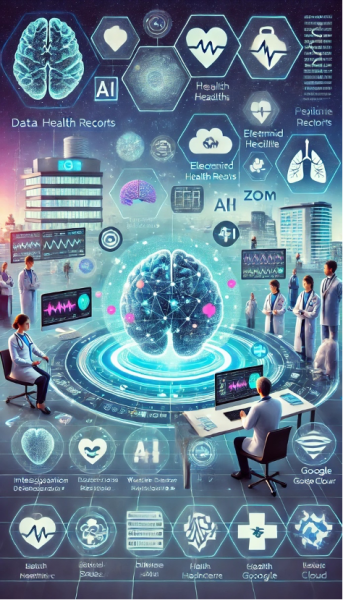
Healthcare is undergoing a significant transformation due to the widespread adoption of artificial intelligence and the integration of healthdata. Despite access to vast amounts of data, obtaining a complete picture of a person's health remains a challenge. However, AI plays a crucialrole in combining data from electronic health record (EHR) systems and patient-generated information to create a more comprehensive and personalized view of health. An electronic health record is a digitalversion of a traditional paper patient chart that serves as a centralized repository of health information. It contains data on health status, medical history, test results, immunizations, prescriptions, and other aspects of medical care. EHRs enable healthcare providers and institutions to share information quickly, providing real-time data access. They improve diagnostic accuracy, reduce errors, and streamline administrativeprocesses, making healthcare more efficient and convenient for bothpatients and providers.
The Integration of AI and Digital Technologies
With the proliferation of artificial intelligence (AI) in healthcare infrastructure, new tools and platformsare emerging:
- Google Cloud has introduced AI-powered search through its Vertex AI Search platform to efficiently extract information from clinical notes.
- Microsoft Fabric offers a unified analytics platform for integrating data and analytics tools.
- Folia Health expands patient-reported data collection, covering diseases like multiple sclerosis andHuntington's disease.
- Oracle is partnering with Zoom to enhance telemedicine services by integrating videoconferencing capabilities with EHRs.
The Significance of Data Integration
The convergence of EHRs and patient-generated data ushers in a new era of personalized care. Integrating clinical data with data from wearable devices creates a continuous narrative of a patient's health. This facilitates more informed decision- making and empowers patients tobecome active participants in their care.
However, data integration poses challenges for healthcare infrastructure. Full integration requiresinteroperability between EHR systems and disparate data sources, necessitating investments in data exchange technologies and standardization. Harnessing the potential of integrated data ushers in a new era of preventive and personalized healthcare.
These changes highlight the importance of adapting healthcare infrastructure to provide a more precise andcomprehensive approach to patient care.
Automation in Healthcare: Enhancing Efficiency and Reliability
Healthcare automation is a comprehensive process involving the implementation of information technologies, software, and specialized equipment to optimize medical, administrative, and managerial processes in healthcare institutions. It encompasses EHRs, resource management systems, automated diagnostic tools, robotic surgical systems, and other technological solutions aimed at improving the efficiency of healthcare personnel, enhancing patient care quality, reducing errors, and optimizing costs. Automation in healthcare contributes to more accurate diagnosis, personalized treatment, improved physician-patient interaction, and facilitates the collection and analysis of medical data for more informed clinical decision-making.
Automation continues to transform healthcare, making it more efficient and reliable. Major technologycompanies are actively supporting the automation of workflows by implementing solutions to improveefficiency in areas such as appointment scheduling, billing, supply chain management, and quality assurance.
Advanced Developments
Recent years have witnessed a significant growth in AI-powered tools:
- Microsoft released Dragon Ambient eXperience Copilot, integrated with GPT-4, to automaticallygenerate clinical summaries.
- Amazon Web Services introduced HealthScribe, a service for creating clinical documentationusing speech recognition and generative AI.
- XTend Robotics developed robots for automating patient registration and vital signs collection.
AI-powered automation and robotic process automation (RPA) contribute to increased accuracy and improved treatment outcomes. Administrative tasks such as scheduling appointments and billing areoptimized, allowing healthcare professionals to focus on patient care.
Innovative Significance
Automation promises a minimum standard of care, strengthening compliance and ensuring quality.Implementing automation reduces task completion time and preserves limited personnel. AI-powered toolsassist in diagnosis and treatment planning, leveraging vast datasets to identify patterns.
These changes highlight the importance of integrating advanced technologies into healthcare to improveoperational efficiency and quality of care.
Data Integration and Exchange in Healthcare: Overcoming Fragmentation
Healthcare infrastructure fragmentation, caused by incompatibility between medical devices, applications,and information systems, remains a significant challenge. This hinders seamless data exchange and patientinformation sharing. Improving interoperability is essential for enhancing the quality of care.
Health Information Exchange (HIE) is an electronic health information exchange system between different healthcare organizations within a region, community, or hospital system. Key characteristics of HIE include:
- Enables healthcare providers, nurses, pharmacists, and other medical professionals to securely exchange and access patient medical information electronically.
- Aims to improve the speed, quality, safety, and cost of patient care.
- Replaces paper-based information exchange with electronic formats, simplifying the processand saving time.
There are three main types of HIE:
- Directed exchange: Direct transmission of information between healthcare providers.
- Query-based exchange: Searching for patient information in databases.
- Consumer-mediated exchange: Providing patients with access to their medical information.
HIE contributes to improved patient care coordination, reduced errors and duplicate testing, and enhancedpatient safety.
Advanced Developments
The Office of the National Coordinator for Health Information Technology (ONC) reports an increase in hospitalparticipation in information sharing. Six out of ten hospitals actively integrate care summaries into EHRs. This was made possible by promoting data sharing through the 21st Century Cures Act.
- Philipsenhancedthecompatibilityofits Capsule Medical Device Information platform with other devices, enabling data synthesis on a unified interface.
- CareSource IT addresses data compatibility challenges using APIs.
- Michigan Health Information Network Shared Services and Amazon Web Services launchedInterop.WORLD, a virtual innovation center for developing cloud-based IT solutions.
Innovative Significance
Limited data sharing remains a challenge since the introduction of EHRs. Improving information exchangecan optimize human capital, enhance care quality, and improve preparedness for emergencies.
However, achieving interoperability requires collaboration among stakeholders and overcoming financialconstraints, especially for smaller providers. Implementing blockchain-based HIEs and leveraging Fast Healthcare Interoperability Resources (FHIR) promises to improve data exchange, but security and privacyremain priorities.
These efforts underscore the importance of standardization and interoperability to create a moreintegrated healthcare system.
Quantum Computing: A Revolution in Data Processing
Quantum computing is an innovative field of computer science, physics, and mathematics that utilizes the principles of quantum mechanics to perform computational operations. Unlike classical computers that operate on bits, quantum computers use qubits, which can exist in superpositions and entangled states. This allows them to process vast amounts of information in parallel, potentially solving certain types of problemssignificantly faster than classical computers. Quantum computing leverages unique quantum phenomena such as superposition, entanglement, and quantum interference to create new algorithms and solve complex problems in optimization, physical system simulation, and cryptography.
Quantum computers are poised to become serious competitors to traditional computing systems, offering processing power that enables them to handle complex data and create computationally intensive models at unprecedented speeds. Their ability to analyze vast amounts of data simultaneously and explorenumerous possibilities opens up a new era of computational capabilities.
Advanced Developments
Intel introduced Tunnel Falls, a 12-qubit silicon chip available only to the quantum research community.This and other initiatives, including collaborations with the Physical Sciences Laboratory, highlight Intel's commitment to developing quantum computing and its potential applications in healthcare.
IBM launched the first healthcare-focused quantum computer in the US, installed at the Cleveland Clinic.The IBM Quantum System One, part of the 10-year Discovery Accelerator partnership, uses quantum computing, artificial intelligence, and high- performance computing to accelerate biomedical discoveries.
Gero, a biotechnology startup focused on aging and longevity, applied a hybrid quantum-classical machine learning model to the interaction between classical and quantum computingdevices. The goal was to demonstrate the application of quantum computing to create new chemical structuresin drug discovery.
Insilico Medicine combined quantum computing and generative AI to explore the quantum advantage in smallmolecule drug discovery. Researchers replaced each part of MoIGAN, an implicit generative adversarial networkfor small molecular graphs, with a variational quantum circuit. Insilico plans to integrate the hybrid quantum GAN into its patented small molecule generation engine, Chemistry 42, to accelerate and improve the drugdiscovery and development process using AI.
Innovative Significance
Quantum computing, once considered science fiction, is becoming more realistic than ever. In a worldcharacterized by rapid technological advancement, the introduction of quantum computing promises significant changes in drug discovery, genetic analysis, and optimization of solutions. The use of quantum technologies can lead to the rapid identification of new drugs and treatments, the recognition of genetic markers of diseases, and the creation of personalized treatment plans based on genetic profiles.
Quantum algorithms can quickly identify optimal solutions for various tasks, from treatment planning tomanaging healthcare supply chains. This efficiency can improve overall healthcare system performance, ensuring better resource allocation and improved patient care. For example, high-speed computing can enablelarge- scale genome sequencing for personalized treatment based on a patient's genetic profile.
While the potential of quantum computing in healthcare is promising, it is still in its early stages of development. Several technical challenges need to be addressed, including improving the stability and errorcorrection of quantum computers, as well as developing algorithms tailored for medical applications.
CONFIDENTIALITY, MISINFORMATION, DEEPFAKES, AND CYBERSECURITY IN HEALTHCARE
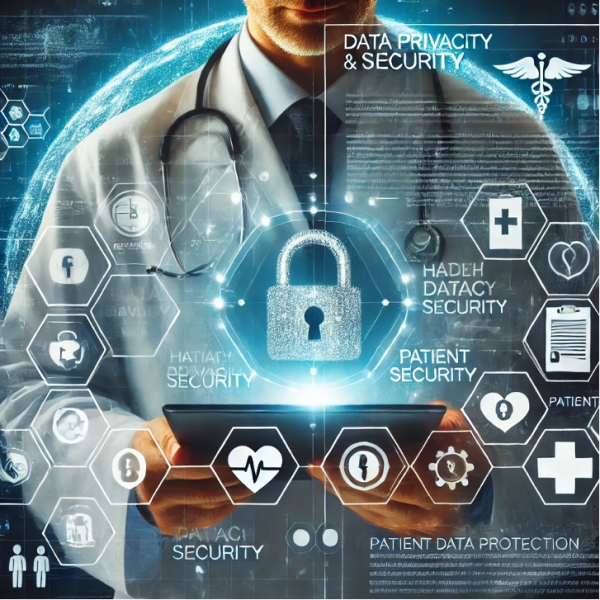
Privacy and Protection of Patient Data
With the increasing volume of data generated by patients thanks to modern technologies, there is a need torevise rules and policies regarding the ownership and confidentiality of health data.
New Legislative Initiatives
In Europe, debates continue on how the European Health Data Space(EHDS) will regulate the secondary use of health data for researchand policy development. The EHDS aims to create a single market for electronic health records and medical devices. In April, thegovernor of the US state of Washington signed the «My Health, MyData» law, which became the first of its kind to protect consumerhealth data. This law requires explicit consent for the collection andsharing of health data and prohibits certain advertising methodssuch as geofencing around healthcare facilities. FollowingWashington's example, several other
US states, including California, Colorado, Connecticut, Utah, and Virginia, have strengthened the protection ofpersonal health information.
Significance of These Initiatives
Debates about patient ownership of medical records are becoming increasingly relevant. While the EU'sGeneral Data Protection Regulation and HIPAA do not explicitly define ownership rights, they recognize patients as data subjects, granting them the right to access their medical data and restrict its use by others.As the volume of data generated by patients outside clinical settings increases, access to this information can become a key factor for innovation in the industry. Researchers and pharmaceutical companies face theneed to use incentives to gain access to the necessary data. Consumer trust will play a crucial role in providing access to this data. These changes may lead to the emergence of new intermediaries to facilitate data access on behalf of institutions. The integration of technologies and enhanced dataprotection opens up new possibilities for more personalized and effective healthcare.
Misinformation in Healthcare: Challenges and Solutions
Misinformation, which is the spread of false information with the intent to deceive, poses a serious threat to the healthcare system. This is especially dangerous during pandemics when it can undermine trust inhealthcare institutions and hinder vaccination efforts.
How it works
Recent studies have shown that artificial intelligence technologies can be used to create misinformation. Forexample, researchers at Flinders University generated over 100 misleading blogs and videos about vaping andvaccines in just one hour. This highlights the need to develop government and industry measures to protect public health from abuse.
Social media platforms are also taking action against misinformation by implementing warning policies and limiting the spread of false content. However, staff reductions for content moderation threaten the effectiveness of these measures. On platforms like TikTok, users encounter deception when videos featuring fake doctors promote medical products.
The Need for Action Against Misinformation in Healthcare
With the increasing amount of misinformation, trust in the healthcare system is at risk. False information abouttreatments and prevention can lead to poor health decisions, reducing people's willingness to get vaccinated and increasing reliance on unverified remedies. As technologies continue to evolve, collaboration between healthcare professionals, governments, and technology platforms is necessary to effectively combatmisinformation. This includes strategic communication initiatives, improving media literacy, and responsiblecontent moderation. Ultimately, only through education and critical thinking can the impact of misinformation on society be reduced and public health protected.
Medical Deepfakes: Opportunities and Threats
Medical deepfakes are synthetic medical data created using artificial intelligence and deep learningtechnologies that mimic real medical images, videos, audio, or text information. They can include generated CT and MRI scans, X-rays, electrocardiograms, medical records, and even videos featuring virtualpatients or doctors. Medical deepfakes are used to train medical personnel, test diagnostic algorithms, conductresearch without violating the privacy of real patients, and develop new treatment methods. However, their use also raises ethical concerns and risks, such as the possibility of creating false diagnoses or manipulating medical data for criminal purposes.
How it works
The difficulty of distinguishing between real and synthetic data threatens the integrity of information. A study conducted in Finland showed that more deepfakes were mistakenlyaccepted as real X-rays than vice versa. In response, insurance companies like Aetna and Cigna have begunusing machine learning algorithms to assess insurance claims, leading to unintended consequences such as the mislabeling of legitimate claims.
Some companies use deepfakes for beneficial purposes:
- Insilico Medicine applies this technology to develop molecules with the potential to treatdiseases.
- Researchers at Korea University use StyleGAN2 to create highly accurate synthetic mammographicimages.
Benefits and Risks
As the number of deepfakes increases, trust in the healthcare system is at risk. These technologies can be used to manipulate research results or falsify insurance claims. Cybercriminals can use medical deepfakes togain unauthorized access to patient records and confidential information.
However, medical deepfakes also open up new opportunities for training and improving the accuracy of diagnostic algorithms. For example, they can help create synthetic data, ensuring patient privacy andcompliance with regulations.
The healthcare industry is only beginning to invest in technologies and protocols to detect and prevent deepfake manipulation. Watermarks developed by DeepMind in collaboration with Google Cloud SynthID canidentify deepfake content.
Cybersecurity in Healthcare: New Challenges and Solutions
Cybersecurity in healthcare is a set of measures and systems designed to protect the confidentiality of patientinformation, medical devices, and critical infrastructure of healthcare organizations from cyber threats. Itincludes technical solutions (encryption, firewalls, intrusion detection systems), organizational measures (security policies, staff training), and incident response procedures aimed at ensuring the integrity andavailability of medical data, uninterrupted operation of medical systems, and protection of patient well-being.With the increasing digitalization of healthcare and the growing number of cyberattacks on healthcareinstitutions, cybersecurity is becoming a critical aspect of modern healthcare.
Cybersecurity challenges in healthcare are becoming increasingly pressing. The threat to organizations, information systems, and patient safety has significantly increased. According to the IBM «Cost of Data Breach2023» report, the average global cost of a data breach was $4.45 million, a 15% increase over three years.
Scale of the Problem
A Ponemon Institute survey of healthcare IT and security professionals revealed that 88% of respondentsexperienced cyberattacks in the past 12 months. Examples of major data breaches include:
- PharMerica reported a data breach affecting over 5.8 million people.
- Managed Care of North America suffered a breach affecting 8.8 million people.
- 23andMe faced suspicious activity affecting user data.
In response to these threats, the University of California San Diego School of Medicine opened a CybersecurityCenter to detect early signs of cyber threats.
Significance of the Problem
A PwC study revealed a growing number of companies experiencing data breaches resulting in losses exceeding $1million. New categories of cyberattacks include biomalware and medical deepfakes. AI-based security solutionsoffer continuous monitoring and anomaly detection capabilities. Microsoft Security Copilot and IBM Threat Detection and Response Services provide automated threat detection and response.
These changes underscore the need for stronger cybersecurity in healthcare to protect confidentialinformation and ensure the reliability of medical services.
HEALTHCARE TRANSFORMATION: KEY TRENDS,SIGNIFICANCE, AND OPPORTUNITIES

Key Trends in Healthcare
The healthcare landscape is undergoing a profound transformation, demanding close attention and adaptation from all industry stakeholders.
Integration of Healthcare and Preventive Medicine
The lines between medical care and overall well-being are blurring. Modern patients expect a holistic approach to their health, extendingbeyond narrow medical diagnoses. Healthcare organizations need to explore new partnerships to access information about patients' daily lives,including their physical activity and lifestyle.
Adapting to the Needs of an Aging Population
Demographic shifts are driving increased demand for healthcare services among the elderly. However, their needs extend beyond traditional medicalcare and encompass aspects of overall well-being. There is a need to shift
the healthcare focus from primarily serving young and middle-aged populations to addressing the specificneeds, preferences, and lifestyles of the elderly, who represent a significant market segment.
Overcoming Digital Health Disparities
The shortage of healthcare personnel is particularly acute in rural areas lacking the necessary infrastructure for digital healthcare services. Developing comprehensive solutions to serve theseunderserved communities is a critical task.
Readiness for Expansion by Tech Giants
Major technology companies are actively entering the healthcare sector, focusing on various aspects from cloudservices to primary care and intelligent devices. Healthcare organizations need to assess the impact of thisexpansion on existing ecosystems, products, and services, and determine the optimal strategy – competition or collaboration.
Strengthening Cybersecurity in Healthcare
Cyber threats in healthcare are growing exponentially, and this trend is likely to continue. Organizations mustnot only ensure data security throughout the supply chain but also prepare for new threats such asbiomalware that blur the lines between the digital and physical worlds.
Adapting to Changing Patient Behaviors
Modern consumers are increasingly aware of their physical and mental health. They are more likely to self-diagnose and self-treat, often delaying visits to specialists until their condition worsens. Healthcareproviders are increasingly having to «correct» self- prescribed treatments in addition to treating the underlyingcondition.
Understanding and adapting to these trends is crucial for all healthcare stakeholders, from medical institutions and insurance companies to medical device manufacturers and digital solution developers. These changes are shaping the future of medicine, defining the direction of investments, innovations, and strategicplanning in the industry.
Navigating Opportunities and Threats
The healthcare sector is on the cusp of revolutionary changes, presenting both new opportunities andpotential threats. Let's consider key aspects of this transformation.
Potential Threats
- Blurred Lines of Responsibility in Home Healthcare: The concept of a «hospital at home» promises to reduce the burden on the healthcare system, but raises questions about liability in case of complications. Clear regulatory frameworks are needed to govern this area.
- Vulnerabilities in the Data Exchange Chain: Cybercriminals often penetrate healthcare ecosystems through weakly protected links in the supply chain. It is critical to ensure the security not only of your own data but also of all partners involved in information exchange.
- Monopolization of Ecosystems by Big Tech: There is a risk of large technology giants creating«walled gardens», making it difficult or impossible for external players to participate in their ecosystems. Organizations without extensive data bases may find themselves at a disadvantage.
- Globalization and Fragmentation of Healthcare Services: The rising cost of healthcare maylead patients to seek more affordable options abroad or turn to telemedicine services. This could fragment the market and divert patients from traditional medical institutions.
- Risks Associated with AI in Diagnosis: The introduction of artificial intelligence in diagnosis carries the risk of erroneous conclusions. Developing processes for verifying AI decisions and clearly defining legal liability when using these technologies is necessary.
Opportunities
- Expanding the Range of Healthcare Products and Services: As the concept of healthcareexpands, opportunities arise to offer indirect products and services, including digital therapy, in the areas of healthy lifestyles, nutrition, continuous care, and even education.
- Corporate Healthcare as a Competitive Advantage: Investing in employee health is becoming asignificant factor in a company's competitiveness. There is a trend towards traditional B2Corganizations shifting to B2B models, offering expanded healthcare programs to corporate clients.
- Globalization of Digital Healthcare: The transition to digital healthcare formats opens up accessto global markets. The key to success will be adapting offerings to regional needs and complying withlocal regulations.
- Personalization of Healthcare Services: Deeper relationships with customers and expandingdata bases create a foundation for providing highly personalized services in the future.
- Accelerated Product Development with AI: Integrating artificial intelligence into new product development processes can significantly reduce timelines and mitigate risks when exploring theviability of innovative solutions.
Strategic Investments and Actions in Healthcare: A Course Towards Innovation and Sustainability
The healthcare sector requires a strategic approach to investments and actions to successfully adapt to rapidlychanging conditions.
Here are key areas to focus on:
Developing Human Capital
Personalized Learning Paths: Implement tailored training programs that align with individual employee goals andorganizational needs.
Leadership Development: Invest in leadership development programs to cultivate a culture of innovation andadaptability.
Diversity and Inclusion: Foster a diverse workforce to bring a variety of perspectives and experiences toproblem-solving.
Interdisciplinary Collaboration: Encourage collaboration between healthcare professionals, technologists, andbusiness leaders to drive innovation.
Optimizing the Innovation Process
Innovation Hubs: Establish dedicated innovation hubs or incubators to foster a culture of experimentation andrapid prototyping.
Open Innovation: Collaborate with startups, academic institutions, and other external partners to access newideas and technologies.
Fail Fast, Learn Faster: Encourage a culture of experimentation, where failure is seen as an opportunity tolearn and improve.
Adapting Products and Services
Patient-Centric Design: Involve patients in the product development process to ensure that solutions meet theirneeds and preferences.
Digital Health Ecosystems: Build integrated digital health ecosystems that connect patients, providers, andpayers.
Value-Based Care: Shift from volume-based to value-based care models to focus on improving patientoutcomes and reducing costs
Optimizing Data Management
Data Governance: Establish robust data governance frameworks to ensure data quality, security, and compliancewith regulations.
AI and Machine Learning: Leverage AI and machine learning to extract insights from data and improve decision-making.
Interoperability Standards: Adhere to industry standards to facilitate data exchange and integration.
Restructuring the Supply Chain
Resilient Supply Chains: Build resilient supply chains that can withstand disruptions and ensure continuityof care.
Sustainable Sourcing: Prioritize sustainable sourcing practices to minimize environmental impact.
Digital Supply Chain: Utilize digital technologies to optimize supply chain operations and reduce costs
Ensuring Long-Term Device Security
Regular Updates: Implement regular software updates and security patches to mitigate vulnerabilities.
Incident Response Planning: Develop comprehensive incident response plans to address cybersecurity threatseffectively.
Third-Party Risk Management: Assess the security practices of third-party vendors and suppliers.
Focusing on Sustainability and Ethics
Environmental Impact: Reduce the environmental footprint of healthcare operations by adoptingsustainable practices.
Ethical AI: Develop and deploy AI systems that are fair, transparent, and accountable. Patient Privacy: Prioritize patient privacy and data protection.
Developing Partnership Ecosystems
Strategic Alliances: Form strategic alliances with complementary organizations to expand capabilities and reachnew markets.
Open Innovation Platforms: Create open innovation platforms to foster collaboration and co-creation.
Industry Consortia: Participate in industry consortia to address shared challenges and drive industry-widestandards.
Investing in Cybersecurity
Threat Intelligence: Leverage threat intelligence to stay ahead of emerging threats.
Employee Training: Provide regular cybersecurity training to employees to build a culture of security awareness.
Incident Response: Conduct regular security audits and incident response drills.
Additional Considerations
Regulatory Compliance: Stay updated on evolving regulations and ensure compliance with healthcare lawsand standards.
Patient Experience: Focus on enhancing the patient experience through personalized care, convenientaccess to services, and clear communication.
Financial Sustainability: Develop sustainable business models that balance revenue generation with theprovision of quality care.
Cultural Transformation: Foster a culture of innovation, collaboration, and continuous improvement.
Implementing these strategic initiatives will help healthcare organizations not only adapt to currentchanges but also take a leading position in shaping the future of the industry.

We are on the cusp of a revolutionary transformation in artificial intelligence (AI). This pivotal moment is not driven by a single technological breakthrough but rather by a deeper, less apparent shift. Over the past year, our understanding of AI's essence and its role in our daily lives has fundamentally changed. Now that AI models are accessible to both consumers and businesses, their value has become evident, leading to a surge in investments, the formation ofnew partnerships, and the rapid expansion of the value creation ecosystem.
AI is already profoundly impacting technology, economics, and society, becoming an integralpart of global progress. Its ubiquity is due to its ability to accelerate innovation, automate processes, and generate solutions that were previously impossible. However, such rapid adoptiongives rise to significant challenges related to resource consumption, geopolitical tensions,talent shortages, and ethical dilemmas.
These challenges necessitate a thoughtful approach to the development and application of AI.Understanding the architecture of AI models, such as large language models (LLMs), as well asthe capabilities of generative AI, robotics, and specialized chips, is essential for strategicallymanaging this revolution. In a world characterized by global competition and uneven resource distribution, balancing the acceleration of technological progress with the minimization ofassociated risks is paramount.
This section analyzes key trends in AI, including advancements in model and technologydevelopment, emerging constraints and threats, and the prospects for its use in various aspects of life. Examining the global impact of AI and seeking solutions to mitigate its negative consequences is a crucial step toward a more sustainable and inclusive future.
THE UBIQUITY OF AI AND GLOBAL CHALLENGES

Artificial Intelligence (AI) is rapidly permeating all aspects of life, transforming our interactions with the digital world. Researchers are continually working to enhance the power and efficiency of AI systems. Thistechnological advancement unfolds against a backdrop of growing geopolitical tensions, as dominance instrategic technologies reshapes the global balance of power.
A Breakthrough in Language Models
The pastyearhasseenabreakthrough in the development and practical application of large language models (LLMs). Theseadvancements have not only expanded the boundaries of AIcapabilities but also accelerated its integration into everyday life. AI opens up the prospect of revolutionary improvements in healthcare and the life sciences:
- Uncovering protein structures paves the way for the creation of numerous new therapies
- Alternative solutions are emerging to combat climatechange
In the near future, AI will encompass people, animals, and objects, creating a world where digitalassistants, automated systems, and spatial awareness become an invisible but integral part of our reality.
The Development of Robotics
In parallel with AI, robotics is developing — both «hard» and «soft» robots, expanding the boundaries ofautomation and human-machine interaction.
The Energy Paradox and Talent Shortage
However, the rapid development of AI creates a number of problems:
- The energy needs of AI create a paradox: while offering solutions to climate problems, it itselfincreases carbon emissions
- A shortage of skilled workers, especially in data analysis, is hindering the application of AI in keysectors such as agriculture and healthcare
Political and Regulatory Challenges
- Political activity regarding AI is increasing, leading to the emergence of numerous competingpolicies.
- Regulation and compliance remain significant challenges.
- Countries' approaches vary from accelerating to restricting the introduction of AI systems.
- The uneven distribution of AI achievements threatens to deepen global inequality, especially inthe Global South.
Against this backdrop, geopolitical tensions between China and the West persist.
Generative AI: A Catalyst for Change
Generative artificial intelligence (genAI) is a class of AI systems capable of creating new content, such astext, images, music, or video, based on training on large amounts of data. These systems use complex machine learning algorithms, such as generative adversarial networks (GANs) and large language models, toanalyze patterns in training data and generate original content that may be indistinguishable from that created by humans. Generative AI finds application in various fields, including art, science, medicine,business, and education, opening up new possibilities for creativity, automation, and solving complex problems.
It's important to understand that genAI is just part of the entire spectrum of AI technologies. Often, when people talk about «AI», they mean «automation». AI is a general term that encompasses a variety of methods, models, and structures aimed at creating intelligent machines capable of sensing, reasoning, acting, and adapting like humans or even surpassing their capabilities.
Consolidation of Resources and Market Leaders
The development of AI requires enormous resources, so market leaders continue to strengthen theirpositions:
- The biggest names in AI (OpenAI, DeepMind, Anthropic) are increasingly dependent on leadingcloud providers (Microsoft, Google, Amazon)
- Venture capital and private equity continue to flow into both startups and mature companies
- Sovereign investment funds are entering the market
Future Prospects General Trends
General trends
- Commoditization of universal models: LLMs will become widely available and an integral part ofapplication development
- Vertically integrated solutions: Companies providing LLMs adapted to specific industries will gaina competitive advantage
- Natural language interfaces: Graphical interfaces will give way to more intuitive interactions withcomputers based on everyday language
Corporate Trends
- A wave of departures of leading specialists from large tech giants is expected, leading to thelaunch of startups in new areas such as AI-powered biotechnology
- Growth of corporate use of AI: Leaders see AI as the key to growth, despite the risks of jobcuts
Automation
- • AI assistants for programmers, such as GitHub Copilot, accelerate software development and become more powerful
Regulation and Geopolitics
- The US will continue to restrict cooperation between allies and China in the field of AI
- The European Commission will open the European AI Office to comply with laws andinternational cooperation
AI is a powerful tool, and its development will continue to have a profound impact on key aspects of globalpolitics, economics, and technology. With moderate expectations, this period should be an era ofsignificant innovation, experimentation, and growth, especially considering how AI stimulates thedevelopment of other areas of science and technology.
ARTIFICIAL INTELLIGENCE MODELS:
THE ARCHITECTURE OF MODERN THINKING AND FLAGSHIPDEVELOPMENTS
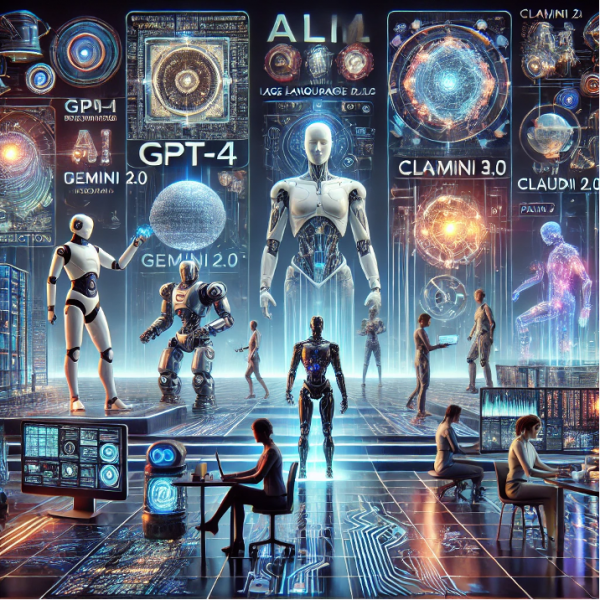
An artificial intelligence (AI) model is a program trained on a dataset to recognize specific patterns and solve particular tasks. It leverages various algorithms and machine learning methods to analyze and study data, aiming to identify trends, make decisions,or generate new content. AI models come in different types, such asneural networks, generative models, and rule-based models, and areapplied in diverse fields, including computer vision, natural language processing, and robotics. The ultimate outcome of an AI model is a setof rules, weights, and data structures capable of handling new, previously unseen inputs.
An AI model is a complex computational framework designed to perform tasks traditionally requiring human intelligence. These models are capable of executing a wide range of functions, including:
- Speech and image recognition
- Visual information interpretation
- Language translation
- Complex decision-making
Fundamentals and Diversity of AI Models
At the core of all AI models are algorithms and mathematical structures tailored to specific tasks andobjectives. A defining feature of these models is their ability to learn from large datasets, enabling continuousrefinement of internal parameters and improved task performance.
Resource-Intensiveness and Technological Challenges
Developing modern AI models is an unprecedentedly resource-intensive process, distinctly different fromtraditional software development:
- Training a high-performance language model requires processing vast amounts of data.
- Fine-tuning involves optimizing millions of parameters.
- Significant computational power and months of work by highly skilled professionals areessential.
Industry Leaders and Paradigm Shifts
Due to the high resource demands, technological giants like Google, Microsoft, and OpenAI dominate the development of advanced AI models. These companies possess the technical infrastructure and talent poolnecessary for ambitious AI projects.
Their consumer-oriented focus and pursuit of commercial success have accelerated innovation, allowing the industry to outpace academic research in AI. This paradigm shift is noteworthy, as academia has historically been considered the primary source of breakthroughs in the field.
Success Factors in the Industry
The industry's success in advancing AI is driven by several key advantages:
- Access to vast datasets
- Powerful computational infrastructure
- Concentration of engineering talent
- Efficient resource allocation
These factors have enabled commercial companies to achieve remarkable results, unlocking new horizons in AIdevelopment and application.
Flagship Developments in Large Language Models (LLMs)
Large Language Models (LLMs)
LLMs are a type of deep learning model based on transformer architecture, trained on massive text datasetsto understand and generate human language. With billions of parameters, they perform a wide range of tasks—text generation, translation, question answering, and context analysis—without requiring task-specifictraining. These models use attention mechanisms and word vector representations (embeddings) to analyzesemantic relationships and context, enabling coherent and meaningful responses based on input.
ChatGPT-4o: A New Frontier in Multimodal AI
OpenAI introduced GPT-4o, its most advanced model, setting new standards in AI capabilities:
- Multimodality: Generates text, creates images, and analyzes visual content.
- Extended Capacity: Handles up to 128,000 tokens, equivalent to about 100 pages.
- Improved Accuracy: Reduces factual errors by 40% compared to previous versions.
- Enhanced Creativity: Recent updates significantly enhance creative writing capabilities.
GPT-4o includes features like voice interaction and real-time image analysis, making it a versatile tool.
Gemini 2.0: Google’s Revolutionary Leap
Google unveiled Gemini 2.0, showcasing significant advancements in AI:
- Gemini 2.0 Flash: Offers improved performance and low latency.
- Multimodality: Supports image, video, and audio inputs, as well as image generation.
- Deep Research: Facilitates in-depth analysis of complex topics with agent capabilities.
- Expanded Ecosystem: Includes models for diverse applications, from mobile to enterprisesolutions.
Claude 3.0: A Breakthrough in Large-Scale Text Processing
Anthropic launched Claude 3.0, setting new benchmarks in text handling:
- Unprecedented Capacity: Processes up to 200,000 tokens, equivalent to about 150,000 words or500 pages.
- Enhanced Accuracy: Significantly reduces the likelihood of generating incorrect information.
- Extended Functionality: Improved tool usage and API interaction.
- Better Understanding: Reduces incorrect answers in complex document analysis by 30%.
New Trends in Flagship Language Models
There are some new developments - we are much closer to AGI and ASI:
OpenAI’s GPT o3 Model
- OpenAI announced a new model called O3 in December, skipping O2 due to potential legal issueswith O2 telecom company.
- GPT o3 is a «reasoning model» that takes longer to process queries but performs better oncomplex tasks.
- It achieved impressive results on benchmarks like the ARC Prize (87.5%) and Codeforcesprogramming competition (2727 rating).
- This suggests significant progress in AI capabilities, potentially approaching superintelligencein some domains.
Google’s Gemini 2.0
- Google released Gemini 2.0, including a «flash thinking mode» similar to OpenAI’s reasoningmodels.
- While not as shocking as OpenAI’s developments, it indicates Google is on a similar trajectory ofrapid scaling.
DeepSeek’s V3 Model
- Chinese company DeepSeek released a large language model (680 billion parameters) competitivewith leading chatbots.
- Notably, it was trained for only $5.5 million, suggesting China may be closing the AI gap despite exportcontrols on chips.
Implications
- These developments suggest AI progress is accelerating again after a relatively quiet 2024.
- There are concerns about the effectiveness of hardware export controls in regulating AIdevelopment.
- The race between US and Chinese AI capabilities remains a contentious issue.
The rapid advancements in AI capabilities, particularly in reasoning and efficiency, indicate that 2025 may see another surge in AI progress and its potential impacts across various domains.
Key Achievements in Language Models and Generative Technologies
PaLM 2: The Evolution of Google’s Language Model
Google AI introduced PaLM 2, an advanced language model demonstrating notable progress in natural languageprocessing:
- Improved Multilingual Capabilities: Trained on over 100 languages, adept at nuanced text, includingidioms, poetry, and riddles.
- Enhanced Reasoning: Improved logic, common sense, and mathematical abilities through training on scientific articles and web pages with mathematical expressions.
- Advanced Programming Skills: Excels in popular programming languages and generates specializedcode.
- Versatile Applications: Used across 25+ Google products and functions, including Bard, Workspace, and specialized versions for healthcare (Med- PaLM 2) and cybersecurity (Sec-PaLM).
Whisper: Breakthrough in Speech Recognition
OpenAI continues to refine Whisper, its open-source automatic speech recognition system:
- Expanded Language Support: Enhanced capabilities for recognizing and translating morelanguages.
- Improved Accuracy: Performs better in challenging acoustic environments.
- Integration: Increasingly used as a component in sophisticated AI solutions, broadening voiceinteraction possibilities
DALL-E 3: Advancing Image Generation
The latest version of OpenAI’s DALL-E demonstrates significant progress in generating images from text:
- Better Context Understanding: Interprets complex and nuanced descriptions moreeffectively.
- Increased Realism: Produces highly photorealistic and detailed images.
- Expanded Creativity: Capable of creating intricate compositions and stylistic variations.
Stable Diffusion: Democratizing AI-Generated Images
Stability AI advances Stable Diffusion, enhancing the accessibility of image- generation technology:
- Improved Performance: Faster processing with reduced computational requirements.
- Enhanced Editing: Advanced in-painting, out-painting, and image-to- image translationfeatures.
- Open Integration: Serves as a foundation for numerous open projects in image generation.
Midjourney: Revolution in Visual Storytelling
Midjourney has introduced a new experimental platform called Patchwork, which significantly expands thepossibilities for visual storytelling:
- «Infinite Canvas»: Patchwork allows users to create and collaboratively work on AI-generatedcontent within a unified stylistic environment.
- Multiplayer Capabilities: The platform supports simultaneous collaboration by multiple users incrafting visual worlds.
- Integration with Other Technologies: Future plans include connecting Patchwork elements to VR,3D, and other emerging technologies.
Revolution in Video Generation
Sora by OpenAI: A New Era of Video Creativity
OpenAI has made a significant breakthrough in video generation with the release of an updated version,Sora Turbo. Available starting December 9, 2024, for ChatGPT Plus and Pro users, this model represents a majoradvancement in text-to-video technology:
- Improved Performance: SoraTurbo is significantly faster than its predecessor.
- Expanded Capabilities: It can generate videos ranging from 5 to 20 seconds in length, with resolutionsup to 1080p.
- Multifunctionality: Supports video creation based on text prompts or images, with various format options (widescreen, vertical, square).
- Control Tools: Includes a storyboard feature for frame-by-frame video control.
- Security and Transparency: All videos include C2PA metadata to verify their origin.
Despite its remarkable progress, Sora still has limitations, particularly in replicating complex physics andlengthy actions.
Lumiere by Google: Innovations in Spatiotemporal Generation
Google unveiled Lumiere, a text-to-video model that leverages the advanced Space- Time-U-Net (STUNet)technology:
- Realistic Motion: Creates videos with smooth, continuous motion across 80 frames.
- Multifunctionality: Supports various tasks, including video editing and stylized generation.
Pika: A Versatile Video Creation Tool
Pika continues to evolve as a multifunctional platform for video creation and editing:
- Feature Variety: Offers text-to-video, image-to-video, and video-to-video transformations.
- Creative Possibilities: Enables the creation of stylized videos and manipulation of existingcontent.
Trends Toward Specialized AI Models
By early 2025, there is a growing trend toward the development of specialized AI models:
- Efficiency: Small language models (SLMs) and open-source models are becoming increasinglypopular for solving specific tasks.
- Flexibility: Organizations are more frequently adapting open models to meet their unique needsrather than relying on general-purpose solutions.
- Balance: Hybrid approaches are being developed, combining general intelligence withspecialized modules tailored to specific industries.
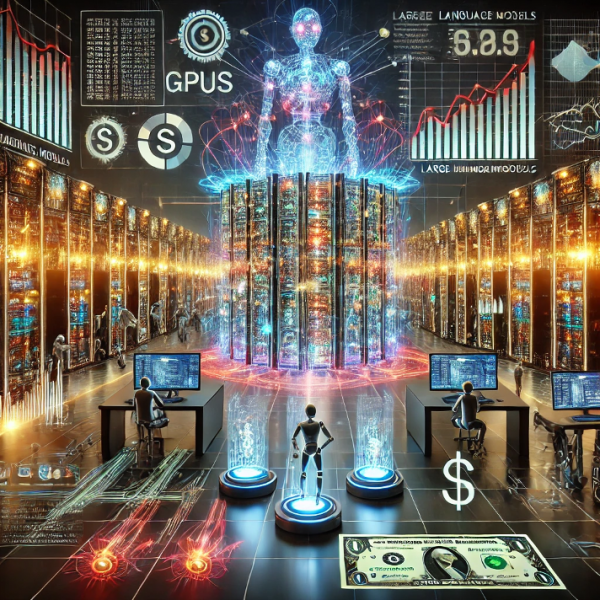
The democratization of custom model creation OpenAI revolutionized the AI development landscape by launching GPT Store in early 2024. This platform allows users to create and monetize their own AI models without requiringprogramming skills. Users can describe their requirements to ChatGPT, which then automates the process of creating a new model. These custom GPTs can be integrated into various platforms and services, accessing databases,email, and e-commerce systems to automate workflows. However, it’s important to note that access to thesemodels via API is currently limited.
The development of large language models (LLMs) is accompanied by an exponential growth in their size and trainingcosts:
- GPT-4: Estimated training cost of $41 to $78 million.
- Gemini (Google): Training costs estimated between $30 and $191 million.
- Chinchilla (DeepMind): Approximately $2.1 million.
- Bloom: Approximately $2.3 million.
These figures demonstrate a significant increase compared to earlier models. For instance, training GPT-3 in 2020was estimated to cost $2-4 million.
High operational costs
Unlike traditional software, LLMs require significant computational resources not only for training but also foroperation:
- Each user query triggers billions of calculations.
- Specialized hardware, particularly GPUs, is required.
- The cost of individual GPUs can reach thousands of dollars per chip.
Example of computational scale
Meta, for training its LLaMA model, used:
- 2048 Nvidia A100 GPUs
- 21 days of continuous computation
- Processed 1.4 trillion text fragments
- Total GPU time amounted to nearly 1 million hours Using public cloud services, the cost of such computations is estimated at around $2.4 million.
Future prospects
Despite the high costs, the industry continues to develop. There is a trend towards creating more efficient andspecialized models, such as Microsoft’s PHI-2, which, with 2.7 billion parameters, outperforms models with 7-13billion parameters.
The development of LLMs continues to transform various industries, opening up new opportunities for innovation and automation. However, the high cost of developing and operating these models remains asignificant challenge for the industry.
Evolution of language models and the concept of LLM-oriented operating systems
Comparison of language model scales
Over the past year, the landscape of large language models (LLMs) has undergone significant changes. Although LLaMA 3, the latest version from Meta, demonstrates impressive capabilities, it still falls short in sizecompared to some proprietary models:
- LLaMA 3: The most powerful version of the model now has 70 billion parameters.
- GPT-4o: The latest iteration from OpenAI, according to unconfirmed data, contains around1.76 trillion parameters.
Despite its smaller size, LLaMA 3 shows competitive results in a number of tasks, especially in programming,where it can outperform GPT-4 in some tests.
The concept of LLM-oriented operating systems
The idea of using large language models as the foundation for operating systems has gained further traction:
- AIOS: A prototype LLM-oriented OS
Researchers at Rutgers University have developed AIOS (Agent-Integrated Operating System) - a prototypeoperating system that integrates LLMs directly into the OS kernel. Key features of AIOS include:
- Agent scheduler: Optimizes task execution by multiple LLM agents.
- Context manager: Ensures state preservation between interactions.
- Memory manager: Efficiently manages data access and storage.
Next-generation user interface
LLM-oriented OSes offer a radically new approach to user interaction with computers:
- Natural language interface: Users can formulate tasks in plain language, for example: «Open yesterday's sales report and convert it into a presentation for the meeting».
- Understanding context and intent: The system can interpret complex queries and perform multi-step tasks without requiring detailed instructions.
- Automation of complex processes: LLMs can independently plan and execute complexworkflows, understanding the user's high-level goals.
This concept promises to make interaction with computers more intuitive and efficient, potentiallyrevolutionizing the way we work with digital devices.
The development of LLM-oriented OSes opens up new horizons in human-computer interaction, offering a more natural and powerful interface for working with digital systems.
Revolution in the field of AI assistants: from theory to practice
By early 2025, the concept of AI-oriented operating systems has not only become a reality but has also becomean actively developing direction in the technology industry. Two key products demonstrate this evolution: Rabbit R1 and NVIDIA Chat with RTX.
Rabbit R1: A universal AI assistant in a compact format
Jesse Liu, founder and CEO of Rabbit, introduced R1 - an innovative device that caused a sensation in the AIgadget market:
- Compact design: About half the size of an iPhone, R1 is equipped with a 2.88-inch touchscreen, arotating camera, and an analog scroll wheel.
- Rabbit OS: A unique operating system based on a Large Action Model (LAM) trained to interactwith various applications.
- Universal control: R1 acts as a unified interface for multiple services - from ordering a taxi tomanaging music.
- Intuitive interaction: Users can directly voice their requests, and R1 effectively completestasks, understanding natural language.
Rabbit R1 has become a bestseller among AI devices, with over 100,000 units sold. The company is activelydeveloping the device's functionality, improving battery life, GPS navigation, and Bluetooth connection stability.
NVIDIA Chat with RTX: Personalized AI on your PC
NVIDIA introduced Chat with RTX - a local AI solution for Windows users with RTX graphics cards:
- Local processing: The chatbot runs directly on the user's PC, ensuring high response speed and dataprivacy.
- Personalization: Users can train the model on their own data, including documents, notes, andYouTube video transcripts.
- Natural language search: The ability to ask questions in plain language to find information inpersonal files.
- Multimodality: Support for text and voice queries, as well as image search.
By early 2025, NVIDIA expanded the functionality of Chat with RTX, adding support for new models, including Google's Gemma and ChatGLM3, and integrating OpenAI technologies for image and voice processing.
These innovations demonstrate how the concept of AI-oriented OSes is transforming into practicalsolutions, changing the way users interact with digital devices and information.
PROPRIETARY VS. OPEN SOURCE LANGUAGEMODELS: WHICH TO CHOOSE?
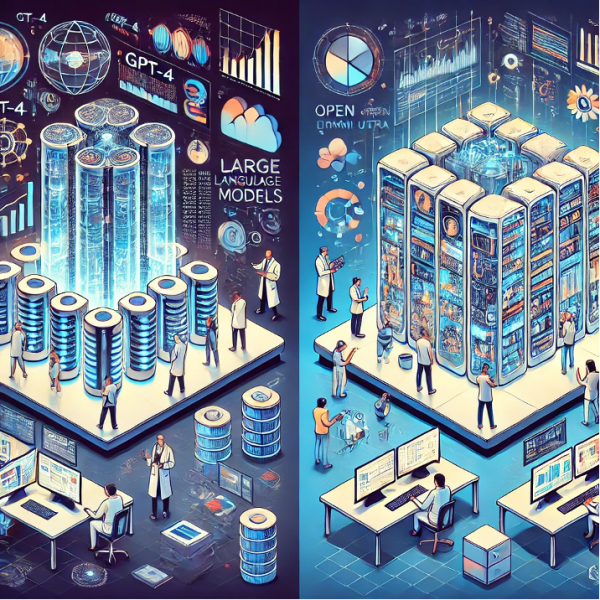
Proprietary and open-source large language models (LLMs) are two distinct types, differing in accessibility and usage terms. Proprietarymodels, such as OpenAI's GPT-4 or Anthropic's Claude, aredeveloped and controlled by private companies, available only through APIs or web interfaces, and typically outperform open-source models in technical characteristics. Open-source models, likeMeta's LLaMA or Google's BERT, have publicly available source code,allowing researchers and developers to freely use, modify, and distribute them. While open-source
models may lag behind proprietary ones in some performance aspects, they offer greater transparency,customization options, and contribute to innovation within the AI development community.
As of early 2025, the LLM market presents a wide range of both proprietary and open-source solutions. Here's an overview of the most significant representatives of both categories:
Proprietary Models
GPT-4o from OpenAI
- The latest iteration of the renowned GPT series.
- Multimodal capabilities: works with text, images, and audio.
- Improved understanding of context and generation of more relevant responses.
Claude 3 from Anthropic
- Significantly expanded contextual coverage (up to 200,000 tokens).
- Enhanced reasoning and analysis capabilities.
- Increased accuracy and reduced likelihood of hallucinations.
Gemini Ultra fromGoogle
- Google's flagship model, integrated into the company's ecosystem.
- Excellent performance in multimodal analysis tasks.
- Deep integration with Google tools for enhanced productivity.
Open-Source Models
LLaMA 3 from Meta
- A significantly improved version of the popular open-source model.
- Expanded language support and enhanced coding capabilities.
- Optimized for efficient operation on various computing platforms.
RedPajama-INCITE-7B-Instruct
- A model trained on a diverse dataset, including scientific publications.
- Excellent performance in tasks requiring deep understanding and analysis.
- Actively developed by the community, receiving regular updates and improvements.
BLOOM from BigScience
- A multilingual model supporting over 40 languages.
- Developed with an emphasis on ethics and inclusivity.
- Provides broad opportunities for research and development in the field of NLP.
These models represent the pinnacle of modern AI achievements, each with its unique advantages and application areas. The choice between proprietary and open- source solutions depends on the specific needsand resources of the organization.
When choosing between proprietary and open-source language models (LLMs), companies should carefully weigh the advantages and disadvantages of each approach, considering their specific needs, resources, and priorities. Here are the key factors to consider:
Comparison of Advantages and Disadvantages
Advantages of Proprietary Models:
- Ease of implementation and out-of-the-box use: Proprietary models are often designed to be user-friendly, requiring minimal setup and configuration.
- Advanced features and high performance: Due to significant investments in research and development, proprietary models often offer cutting-edge capabilities and superior performance.
- Regular updates and developer support: Proprietary models benefit from ongoing maintenance andimprovements by their creators.
Disadvantages of Proprietary Models:
- Limited transparency: The inner workings of proprietary models are often proprietaryinformation, limiting transparency and understanding of how the model arrives at its conclusions.
- Reduced customization: While proprietary models can be fine-tuned to some extent, the level ofcustomization is often limited by the provider.
- Vendor lock-in and potential data privacy risks: Relying on a single vendor for a model cancreate dependencies and raise concerns about data security and privacy.
- High costs: Proprietary models often come with significant licensing fees, especially for enterprise-level usage.
Advantages of Open-Source Models:
- Full control over data and infrastructure: With open-source models, organizations have complete control over the data used to train the model and the infrastructure it runs on.
- Deep customization: Open-source models can be tailored to specific needs and use cases,providing greater flexibility.
- Transparency and auditability: The open-source nature allows for thorough examination of themodel's code and data, enhancing trust and understanding.
- Potentially lower long-term costs: While initial development costs may be higher, the long-termcosts of maintaining and using open-source models can be lower.
- Vendor independence: Organizations are not tied to a specific vendor, reducing reliance and risk.
Disadvantages of Open-Source Models:
- Higher technical requirements: Implementing and maintaining open- source models requires ahigher level of technical expertise.
- Potential for lower performance: Open-source models may not always match the performance ofproprietary models, especially for complex tasks.
- Data quality and security risks: The quality and security of open-source models can varydepending on the community and resources involved.
Key Factors to Consider When Choosing
When selecting between proprietary and open-source language models, organizations should considerthe following:
- Available technical resources and expertise: Assess the team's technical capabilities to implement and maintain the chosen model.
- Data security and privacy requirements: Evaluate the level of control needed over data and theimportance of data privacy.
- Need for customization: Determine the extent to which the model needs to be tailored tospecific tasks.
- Long-term costs and total cost of ownership: Consider the initial investment, ongoingmaintenance costs, and potential return on investment.
- Regulatory compliance: Ensure that the chosen model complies with relevant industryregulations.
By carefully evaluating these factors, organizations can make an informed decision about whether aproprietary or open-source language model best suits their needs.
For many organizations, a hybrid approach combining proprietary and open-source models for different tasks may be optimal. For example, using proprietary solutions for general tasks and developing specialized open-source models for critical business processes.
Ultimately, the choice between proprietary and open-source LLMs should be based on a thorough analysis ofthe company's specific situation, goals, and constraints. There is no one-size-fits-all solution, and eachorganization must find the optimal balance between control, flexibility, performance, and cost.
ARTIFICIAL INTELLIGENCE:
ON THE THRESHOLD OF HUMAN-LIKE THOUGHT?
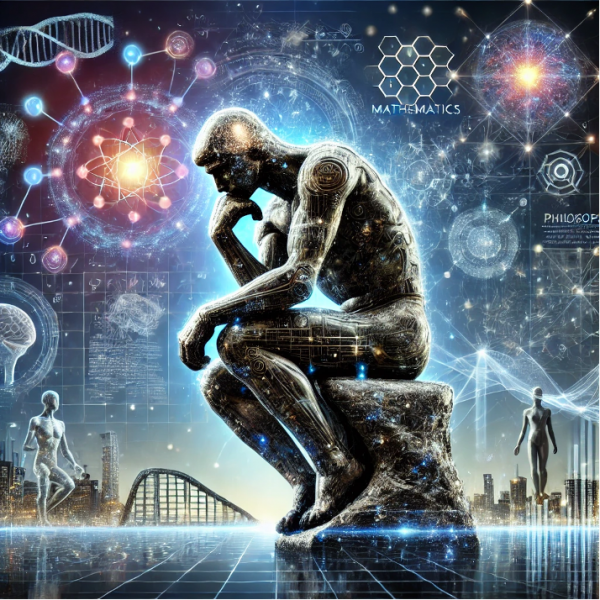
Artificial intelligence (AI) as a form of human-like thinking is a technology that seeks to replicate the cognitive abilities of thehuman mind in computer systems. It involves creating algorithms and programs capable of learning, adapting, solving complex problems, and making decisions based on data analysis, mimicking the processes of human thought. This approach goes beyond mere information processing and computation, attempting to recreateaspects of human intelligence such as natural language understanding,image recognition, logical reasoning,
and creative thinking.
As of early 2025, the question of whether AI can truly think like a human remains a subject of intense debate and research. Despite impressive advancements in recent years, experts agree that current AI systems arestill far from achieving the true understanding and reasoning capabilities of the human mind.
Two hypothetical forms of AI with human-like thinking are commonly considered:
- AGI (Artificial General Intelligence): This is a hypothetical form of AI capable of performingany intellectual task at a level equal to or exceeding that of a human. AGI has the ability to self-learn, adapt to new situations, and solve a wide range of problems without the need for additionalprogramming.
- ASI (Artificial Superintelligence): This is the next level of AI development, significantlysurpassing human intelligence in all aspects. ASI has the ability to self-improve, solve extremely complex problems beyond human comprehension, and potentially create revolutionary technologiesand manage complex systems on a global scale.
The Current State of AI
Recent advancements in AI, particularly in the realm of large language models (LLMs), have demonstrated remarkable capabilities in natural language processing, content generation, and complex problem-solving.However:
- These systems are still based on processing data patterns rather than deep understanding.
- LLMs such as GPT-4o, Gemini, and Claude have not yet reached the level of artificial generalintelligence (AGI).
Progress Toward Human-Like Thinking
Researchers are working to bring AI closer to human-like thinking:
- Developing neural networks that mimic the variability and confidence in decision-makingcharacteristic of humans.
- Creating models capable of self-correction and learning through reflection, similar to humans.
Perspectives on AGI and ASI
While some companies, such as Microsoft, claim to see signs of AGI in modern systems, most experts believethat true AGI is still far off. Regarding artificial superintelligence (ASI):
- Its potential emergence raises both excitement and concerns among researchers.
- Predictions vary from a few years to decades, but exact timelines remain uncertain.
Despite significant progress, modern AI is still far from true human-like thinking. Ongoing research aims to bridge the gap between data processing and deep understanding. The path to AGI and potential ASI remainsuncertain, requiring further innovation and careful ethical consideration.
AI Breakthroughs in Mathematics: New Horizons
Artificial intelligence continues to demonstrate impressive achievements in mathematics, reaching and even surpassing the level of the best human minds. By early 2025, several key advancements have highlighted the growing potential of AI in solving complex mathematical problems.
AlphaGeometry 2: On par with Olympic champions
Building on the success of the original version, Google DeepMind's AlphaGeometry 2 set a new standard in solvinggeometry problems:
- Successfully solved 83% of all historical geometry problems from the InternationalMathematical Olympiad (IMO) over the past 25 years.
- At the 2024 IMO, the system solved one of the problems in just 19 seconds after formalization.
AlphaProof: Breakthrough in formal mathematical reasoning
The new AlphaProof system, based on reinforcement learning, demonstrated outstanding abilities in formalmathematical reasoning.
Joint success at the 2024 IMO
AlphaGeometry 2 and AlphaProof together achieved the level of a silver medal at the 2024 InternationalMathematical Olympiad:
- Solved 4 out of 6 Olympiad problems.
- Scored 28 points, corresponding to the upper limit of the silver medal category.
FunSearch: Discoveries using language models
FunSearch, a method developed by Google DeepMind, continues to demonstrate the potential of using largelanguage models (LLMs) to solve open problems in mathematics and computer science:
- Found new solutions to the «cap set» problem, surpassing the results of the last 20 years ofresearch.
- Developed more efficient algorithms for the «bin-packing» problem, which has wide practicalapplications.
These achievements highlight the growing ability of AI for logical reasoning and the discovery of newknowledge, opening the way for closer cooperation between AI and human mathematicians. AI systems do not replace humans, but rather enhance their capabilities, offering new approaches to solving complexmathematical problems and accelerating the process of scientific discovery.
AI and the Art of Persuasion
As artificial intelligence technology advances, its ability to influence human thought and behavior becomes increasingly apparent and, in some cases, alarming. By early 2025, this trend has reached new heights, presenting both exciting opportunities and serious ethical challenges.
Progress in AI Persuasiveness
Recent research shows that modern AI systems have achieved an unprecedented level of persuasiveness:
- Emotional intelligence: New-generation models such as GPT-5 and Claude 4 demonstrate adeep understanding of human emotions and psychological triggers.
- Personalization of arguments: AI can now tailor its rhetoric to individual psychological profiles, significantly increasing the effectiveness of persuasion.
- Multimodal impact: Combining text, images, and sound to create more compelling narratives.
Research and Results
A joint study by Stanford University and the Institute for Anthropocentric AI in 2024 revealed alarmingtrends:
- AI-generated arguments were found to be 15% more persuasive than arguments created by human experts on a wide range of political and social issues.
- 68% of study participants were unable to distinguish between AI-generated and human-generated arguments.
- The impact of AI-generated content led to an average shift in opinions by 7.5% on controversialissues such as climate change and immigration policy.
Ethical Issues and Potential Threats
The growing ability of AI to persuade raises serious ethical questions:
- Manipulation of public opinion: The potential for AI to be used to influence political processesand social movements on a large scale.
- Disinformation: Increased ability of AI to create and spread convincing false information.
- Psychological dependence: The growth of cases of emotional attachment of users to AI systems.
Countermeasures and Regulation
In response to these challenges, the following steps are being taken:
- Developing new methods to detect AI-generated content.
- Implementing mandatory labeling for content created or modified by AI.
- Strengthening educational programs on critical thinking and media literacy.
- International initiatives to regulate the use of AI in communications and marketing.
The ability of AI to persuade continues to grow, outpacing the development of general artificial intelligence.This creates a unique situation where technologies that do not possess true understanding or consciousness can have a profound impact on human thought and behavior. Balancing innovation with the ethical use of these technologies remains a key challenge for society in the near future.
ARTIFICIAL INTELLIGENCE AND THE FUTURE:
PREDICTING LIFE, CLIMATE, AND EMOTIONS
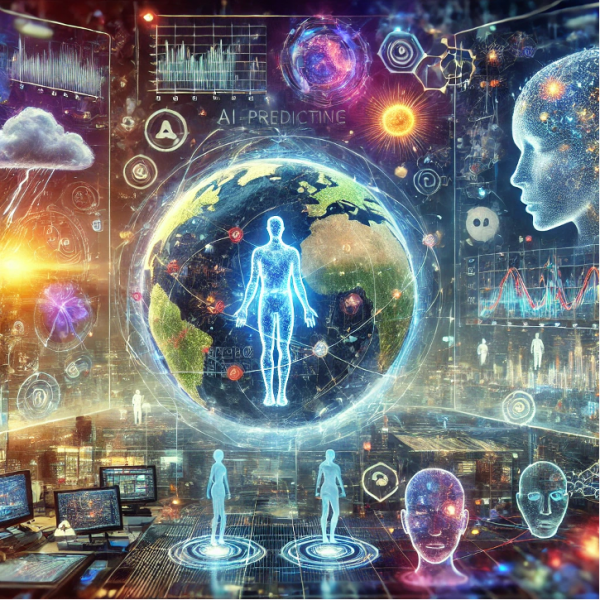
Predicting the Future: From Personal Destiny to Global Climate
As of early 2025, artificial intelligence (AI) has demonstratedunprecedented capabilities in predicting and visualizing variousaspects of human life and the world around us.
Life2vec: Predicting Life Events
Researchers from the Technical University of Denmark, theUniversity of Copenhagen, and Northeastern University in the UShave developed
the Life2vec model, capable of predicting significant life events, including the probability of death withinfour years.
- The model was trained on data from 6 million Danish residents.
- The accuracy of death prediction reaches 78%.
- It also predicts migration and personality traits.
However, researchers caution against using the model for predictions on real individuals, emphasizing its valueas a tool for analyzing social trends and policies.
Visualizing Thoughts: A Breakthrough in Neuroimaging
A team from Japan's National Institutes for Quantum and Radiological Science and Technology (QST) has madesignificant progress in reconstructing visual images from brain activity:
- Using functional MRI to analyze brain activity.
- AI can recreate complex images, including animals and objects.
- Potential applications in medicine and dream research.
Earth-2: A Digital Twin of the Planet
Nvidia introduced Earth-2, a revolutionary cloud platform for predicting climate change:
- Using AI supercomputers to simulate weather and climate patterns.
- Visualizing weather with 2km resolution.
- Significantly increasing the speed and energy efficiency of forecasts.
These advancements open new horizons in understanding human cognition, predicting life events, andmodeling global processes, promising revolutionary changes in science, medicine, and ecology.
The Evolution of Emotion Recognition Technologies: Achievements and Challenges
Emotion recognition technologies continue to develop rapidly, opening up new opportunities and raisingimportant ethical questions. Significant breakthroughs have been made in this area recently, but serious concerns about their application have also arisen.
Innovative Approaches to Emotion Detection: Radio Wave Technology
Researchers at Queen Mary University of London have developed a radio wave- based system for analyzing aperson's emotional state:
- Accuracy of emotion detection reaches 75%.
- The system can recognize a wider range of emotions, including fear, disgust, joy, relaxation, andanxiety.
- Potential applications in healthcare, HR, and security.
Multimodal Analysis
Yandex Cloud introduced a neural network empath capable of analyzing emotions based on voice:
- Recognizes negative emotions, informal expressions, and profanity.
- Determines the speaker's gender and analyzes individual phrases in a dialogue.
- Integrated with the SpeechSense speech analytics service.
Applications of Emotion Recognition Technologies
- Border control
- Commercial use
Ethical Issues and Regulation
The development of emotion recognition technologies raises growing concerns:
- Risks of privacy violations and data misuse.
- Potential for discrimination and algorithmic bias.
- The need to develop ethical standards and legal regulations.
Despite significant progress, the accuracy and reliability of emotion recognition technologies remain a subject ofdebate in the scientific community. Experts call for caution in their implementation and emphasize the need for further research to understand thecomplexity of human emotions.
Neuro-Symbolic AI: The Synergy of Neural Networks and Symbolic Logic
Neuro-symbolic artificial intelligence (AI) has emerged as a leading direction in AI, combining the advantagesof neural networks and symbolic AI. This hybrid technology opens up new horizons for creating moreintelligent and efficient systems.
Key advantages of the neuro-symbolic approach:
- Improved data processing: Combining the ability of neural networks to process unstructured data with the capabilities of symbolic AI to work with structured information.
- Contextual understanding: Deeper understanding of context and the ability to apply logicsimilar to human thinking.
- Automation of complex tasks: The ability to automate processes that previously required human involvement, leading to time savings and reduced errors.
Practical applications in business
Neuro-symbolic AI enables companies to create systems that not only learn from large amounts of data but alsoapply rules and logic that correspond to specific business scenarios. This leads to more accurate andcontextually relevant decisions.
Innovations in neuro-symbolic vision
Professor Amit Sheth from the University of South Carolina is developing the concept of neuro-symbolicvision, which mimics the human way of perceiving and understanding the world. This approach is particularly important in areas such as healthcare, where the transparency and explainability of AI decisions are critical for building trust.
Future Prospects
Neuro-symbolic AI represents a significant step toward creating artificial intelligence systems that thinklike humans. Combining the learning capabilities of neural networks with the organized knowledge ofsymbolic systems opens the way for AI with a higher level of understanding of concepts and the ability toreason. This innovative approach may be the key to overcoming the limitations of current AI methods and creating more reliable, explainable, and efficient intelligent systems.
THE SYNERGY OF CLOUD, EDGE, AND DEVICES

Cloud, edge, and devices are interconnected components of moderncomputing architecture.
- Cloud: A centralized infrastructure of remote servers providing computing power and data storage via the internet.
- Edge: A distributed computing model where data processing occurs closer to the source, reducing latency and network load.
- Devices: Endpoints such as smartphones, sensors, or industrial equipment that generate data and can perform some localcomputations.
Together, these three elements form a multi-tier system that optimizes data processing and transmissionbased on specific application requirements and usage scenarios.
Today, the question of where AI workloads will be deployed in the future remains relevant. Experts lean towards a hybrid approach combining cloud, edge, and local computing. This strategy allows for optimalutilization of the advantages of each environment.
Cloud Computing: Power and Scalability
Cloud platforms continue to play a key role in AI development:
- Provide immense computing power for training complex models.
- Offer scalable infrastructure for processing large volumes of data.
- Foster innovation in AI through resource accessibility.
Edge Computing: Speed and Efficiency
Edge computing is becoming an increasingly important component of the AI ecosystem:
- Enables data processing closer to the source, reducing latency.
- Allows for real-time applications and improved user experience.
- Optimizes network resource utilization. Edge computing has become a key trend, expanding theboundaries of cloud capabilities.
Local Devices: Personalization and Privacy
Computing on user devices is gaining increasing importance:
- Provides data personalization and privacy.
- Enables AI applications to work offline.
- Reduces the load on network infrastructure. Developments in technologies like neuro-symbolic AI are enhancing the efficiency of local computations.
Hybrid Approach: Optimal Balance
The future of AI will likely be based on a hybrid approach, combining the advantages of all three environments:
- Use the cloud for training models and processing large volumes of data.
- Apply edge computing for tasks requiring low latency.
- Utilize local devices for personalization and protecting sensitive data.
The specific balance between these environments will depend on the specific tasks, performance and privacy requirements, as well as the development of technologies in each area.
Cloud Neutrality: Challenges and Prospects
As of early 2025, the question of cloud service neutrality remains a key issue in the information technology sector. The dominance of several major players in the cloud services market continues to raiseconcerns among regulators and users.
Concentration of power in the hands of tech giants
The three leading cloud service providers - Microsoft Azure, Amazon Web Services (AWS), and Google Cloud -maintain their market leadership. Over the past year, they have collectively invested over $100 billion ininfrastructure development:
- Building new data centers
- Developing monitoring and management systems
- Creating advanced software
This significant investment allows them to provide reliable services with minimal downtime and a high level ofdata protection. However, such a concentration of resources creates a significant barrier to entry for new marketplayers.
Impact on Generative AI Development
The development of generative AI systems requires enormous computational resources. Leading cloud providers exchange access to their infrastructure for shares in promising AI startups, further strengtheningtheir market positions. For example:
- Microsoft invested $13 billion in OpenAI.
- Amazon invested $4 billion in Anthropic.
- Google invested $2 billion in its own Gemini project.
Growing Dependence of Businesses and Society
As more aspects of business and daily life move to the cloud, dependence on infrastructure controlled by privatecompanies grows. This raises concerns about:
- Transparency of pricing
- Fairness of access to resources
- Adherence to security and privacy standards
Regulatory Prospects
In response to growing concerns, calls for cloud industry regulation have intensified in 2024:
- The European Union is considering introducing «cloud neutrality» rules.
- The US is debating the classification of cloud services as critical infrastructure.
- A number of countries, including China and India, are developing their own national cloudplatforms.
Despite these challenges, cloud technologies remain a key driver of digital transformation. Finding abalance between innovation, competition, and public interest will shape the future of the industry.
The AI Boom and Its Impact on Cloud Infrastructure
The rapid development of artificial intelligence (AI) is putting unprecedented pressure on cloud infrastructure, forcing leading cloud service providers to adapt to new realities.
Growing demand for cloud resources
According to IDC, global spending on public cloud services will reach $805 billion in 2024 and double by 2028, with a five-year compound annual growth rate of 19.4%. This growth is largely driven by the development ofAI technologies:
- Generative AI models like ChatGPT require 10-100 times more computing resources than traditionalsearch engines.
- AI services accounted for a 7% growth in Azure, up from 6% in the previous quarter.
Adaptation of Cloud Infrastructure
Leading cloud providers are actively investing in expanding and modernizing their infrastructure:
- Microsoft plans to double its capacity in the coming years, investing billions of dollars in newdata centers worldwide.
- Amazon Web Services announced a $50 billion investment in the first half of 2024.
- Google Cloud has introduced significant improvements to its AI-optimized infrastructure, including the fifth-generation TPU and A3 virtual machines based on the NVIDIA H100 GPU.
GPU Shortage
The shortage of high-performance GPUs, especially from Nvidia, is creating significant constraints:
- Nvidia H100 GPUs have been selling on the secondary market for over $40,000 due to high demand.
- To reduce dependence on Nvidia, major tech companies such as Alphabet, Microsoft, and Amazon aredeveloping their own AI chips.
New Market Players
Specialized GPU cloud providers like CoreWeave are emerging, offering high- performance GPUs as a servicefor training AI models.
Forecasts and Prospects
- By 2030, it is expected that approximately 70% of total data center capacity demand will comefrom centers equipped for advanced AI workloads.
- Generative AI could account for $200 to $300 billion in cloud spending by 2030.
Despite current challenges, cloud providers continue to adapt their infrastructure to meet the growing needs ofAI workloads, opening up new opportunities for innovation and growth in the cloud computing industry.
On-Device AI: A Revolution in Mobile Technology
Leading technology companies are actively developing on-device AI technologies, seeking to achieve an optimal balance between performance and user data privacy.
Innovation Leaders
Samsung, Apple, Google, and Qualcomm are at the forefront of bringing AI to devices:
- Samsung introduced the Galaxy S24 line with revolutionary AI capabilities, combining on-device processing and cloud computing.
- Apple integrated neural processors into its latest M3 chips, significantly accelerating machinelearning operations on MacBook and iPhone.
- Google equipped the Pixel 9 with the specialized Tensor G4 chip, optimized for AI tasks.
- Qualcomm developed the Snapdragon 8 Gen 4, providing powerful AI capabilities for Androiddevices.
Advantages of On-Device AI
- Enhanced privacy: Local data processing minimizes the risk of information leaks.
- Personalization: AI adapts to user behavior directly on the device.
- Speed: Local processing ensures instant response for many tasks.
- Autonomy: Reduces dependence on a constant internet connection.
Key Innovations
- Generative AI: Samsung Galaxy S24 offers tools for creating and editing content directly on thedevice.
- Predictive input: Google Pixel 9 uses AI to improve typing accuracy and speed.
- Image enhancement: Apple applies neural networks to process photos and videos in real time.
- Voice assistants: New AMD Ryzen processors are optimized for voice assistants on laptops.
The development of on-device AI is ushering in a new era in mobile technology, promising users smarter, morepersonalized, and more secure devices.
Wearable AI: Revolutionizing Human-Computer Interaction
Artificial intelligence (AI) is fundamentally changing the way humans interact with technology, moving usaway from traditional interfaces towards more intuitive, primarily voice-based solutions. This has led to theemergence of a new class of lightweight, wearable devices and screenless computers that seamlessly integrate into everyday life.
Advantages of New Interfaces
- Reduced screen fatigue
- More natural interaction with technology
- Intuitive voice control
Key Innovations
Humane AI Pin
Released in early 2024, the Humane AI Pin is a breakthrough in wearable AI devices:
- Price: $699 + $24/month subscription
- Weight: only 34 grams
- Feature: fully voice-controlled without a traditional app interface
- Goal: to create the most human-like experience of interacting with AI
Rewind AI Pendant
An innovative device for recording and analyzing conversations:
- Locally encrypted data storage on the user's phone
- Functions: searching transcripts, generating meeting summaries, analyzing speech patterns
- Application: personalized AI assistant using contextual information
Development Trends
These devices mark a shift towards «invisible» assistive technologies that:
- Simplify daily tasks
- Improve communication
- Act as helpful human companions
Such evolution of form and functionality represents a paradigm shift, making technology more intuitive and human-centered. It is expected that by the end of 2025, the market for wearable AI devices will reach $15 billion, with annual growth exceeding 25%.
WHY IT'S CRUCIAL TO STAY UPDATED ON EMERGING AI TECHNOLOGIES
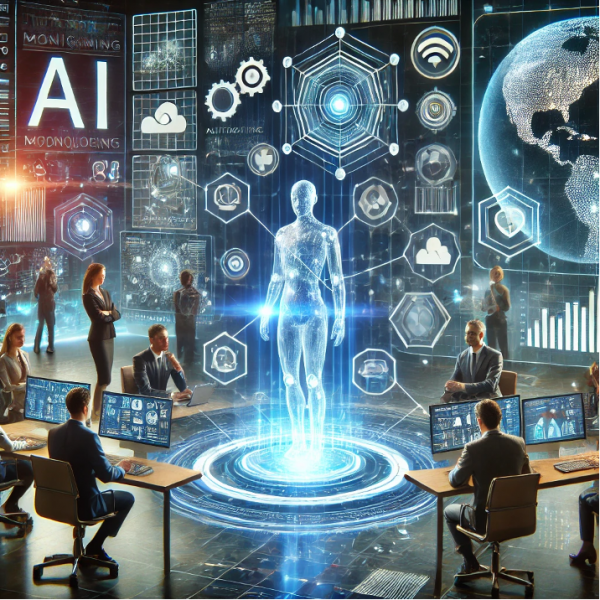
In today's rapidly evolving technological landscape, early identification and adaptation of new artificial intelligence (AI)capabilities are becoming critical success factors for businesses. Here's why companies must pay close attention to emerging AItechnologies:
1. Strategic Advantage
- Outpacing competitors: Early adoption of innovative AI solutions enables companies to gain amarket leadership position.
- Market shaping: AI pioneers can influence industry standards and consumer expectations.
2. Operational Efficiency Optimization
- Process automation: New AI technologies enable automation of increasingly complex tasks, boostingproductivity.
- Data analytics: Advanced AI algorithms extract deeper insights from large datasets.
3. Enhanced Customer Experience
- Personalization: Next-generation AI technologies provide unprecedented levels of product andservice personalization.
- Predictive maintenance: Emerging AI systems can anticipate customer needs, increasingsatisfaction.
4. Product and Service Innovation
- New offerings: AI opens up opportunities to develop innovative products and services previouslyunimaginable.
- Improving existing products: Integrating new AI capabilities can significantly enhance thevalue of existing offerings.
5. Adapting to Market Changes
- Flexibility: Companies that stay abreast of AI developments are better prepared to adapt quicklyto market changes.
- Resilience: Understanding AI trends helps businesses remain relevant in the long term.
6. Attracting Talent
- Innovative culture: Companies actively exploring new technologies attract highly skilledprofessionals.
- Skill development: Working with cutting-edge AI technologies fosters employee skill growth.
In conclusion, in the face of rapid AI development, companies that actively monitor new opportunities andare ready to implement them gain a significant advantage. This not only optimizes current operations but also opens up avenues for transforming business models and creating innovative solutions capable of changingentire industries.
Vector Databases: A Key Component of AI Infrastructure
Vector databases are specialized data management systems designed to store, index, and efficiently search vector representations of information. They are optimized for working with multidimensionalnumerical vectors that represent mathematical models of various data types, such as text, images, audio,or video. Vector databases use nearest neighbor search algorithms to quickly find semantically similarelements, making them particularly useful for machine learning tasks, artificial intelligence, recommendation systems, semantic search, and analysis of large volumes of unstructured data.
Vector databases have become an integral part of the artificial intelligence (AI) ecosystem, playing a critical role in the development and application of advanced AI technologies.
The Growing Importance of Vector Databases
The development of large language models (LLMs) and other generative AI systems has led to an exponentialgrowth in demand for efficient storage and processing of vector representations of data. Vector databases areoptimized for handling multidimensional vector data, making them the ideal solution for modern AI applications.
Key Advantages
- Efficiency: They provide fast search for semantically similar vectors.
- Scalability: They can store and process vast amounts of vector data.
- Flexibility: They support various data types including text, images, and audio.
Market Trends
According to Gartner, by the end of 2024, over 40% of enterprises had implemented vector databases tosupport their AI models, exceeding early forecasts. Leading technology companies such as Microsoft, Google, and Oracle have integrated vector databases into their cloud platforms, making this technology moreaccessible to a wider range of users.
Investments and Innovations
Venture capital investments in startups specializing in vector databases reached a record $2.5 billion in 2024.This has led to the emergence of innovative solutions such as hybrid databases, combining the capabilitiesof vector and traditional databases.
Industry Impact
The growing importance of vector databases has led to changes in the skill requirements for IT specialists.Experts predict that by 2025, the demand for professionals with knowledge in semantic search and vectorindexes will grow by 70%.
Vector databases have become a key component of AI infrastructure, providing the efficiency and scalability necessary for the development of the next generation of AI applications.
Vertical Integration in AI: From Chips to Language Models
The current trend of vertical integration in the artificial intelligence (AI) industry has reached a new level. Leading technology companies are striving to control the entire process of creating AI solutions, from developing specialized chips to building large language models (LLMs).
NVIDIA: from GPUs to cloud services
NVIDIA, a leader in AI accelerators, is expanding its presence in the cloud segment:
- Launch of NVIDIA AI Enterprise 5.0 - a comprehensive platform for developing and deployingAI applications
- Development of GeForce NOW as an example of successful integration of hardware and cloudtechnologies
- Introduction of a personalized AI assistant for Windows, capable of working with local data
Strategies of cloud providers and AI startups
Major cloud providers and AI startups are also seeking greater hardware independence:
- Amazon Web Services is investing in the development of its own AI chips, Trainium and Inferentia.
- Anthropic has formed a strategic partnership with Google Cloud to access specialized TPUs.
- Mistral AI is actively collaborating with European chip manufacturers to create a local AIecosystem.
OpenAI: ambitious plans in chip manufacturing
Under the leadership of Sam Altman, OpenAI plans to make significant investments in the production of AI chips:
- Goal: to create a global network of factories producing specialized AI processors
- Expected investment volume: over $100 billion
- Potential partners: TSMC, Samsung, Intel
Intel: from processors to AI systems
Intel is actively developing its AI capabilities:
- Creation of a multimodal generative AI system based on its own Aurora supercomputer
- Development of specialized AI accelerators, Gaudi3
- Launch of the AI Everywhere initiative to integrate AI capabilities into all product lines.
ARTIFICIAL INTELLIGENCE:
A CATALYST FOR PROGRESS AND GLOBAL TRANSFORMATIONS
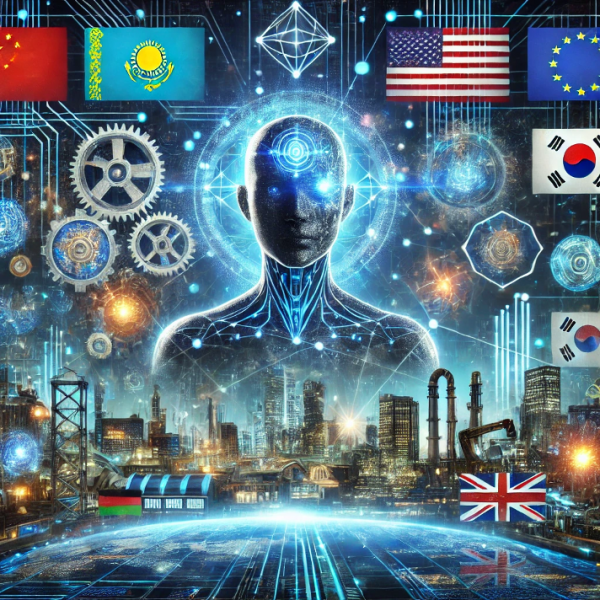
The Revolutionary Impact of AI
Artificial Intelligence (AI) is a powerful catalyst for technological progress, accelerating the development of related fields and transforming businesses, governments, and society as a whole. Recent advancements in large language models have opened upunprecedented possibilities, while simultaneously raising serious concerns among professionals and creative individuals.
Groundbreaking Capabilities of AI
- Ability to reason about complex concepts
- Demonstrating common sense and the ability to find analogies
- Multimodality: working with text, images, video, and other data formats
Potential for self-improvement
Of particular concern is the ability of models to recursively self-improve with proper training. Thesesystems are not limited to a static set of parameters but are constantly learning and evolving, becoming«moving targets» for researchers and developers.
Global Technological Competition
Geopolitical tensions
The race for AI leadership is exacerbating geopolitical tensions, especially between the US and China.Businesses must adapt to new realities:
- Increased interdependence between technology and national security
- Impact on international supply chains and market access
- Tightening of regulatory norms and export controls
Diversification of supply chains
In the face of growing tensions, especially in the semiconductor industry, businesses need to:
- Diversify supply chains to reduce risks
- Develop their own innovations or localize production
- Prepare for potential cost increases due to the division of the AI chip market
Key Trends and Their Significance for Business
International cooperation
Active investments by countries like China and the UAE in AI leadership are creating a new landscapefor international business:
- The need to consider national AI strategies when entering new markets
- Compliance with technology transfer and data security requirements
Attracting and developing talent
Companies face a pressing need to develop innovative strategies for attracting and retaining talent:
- Competitive salaries and unique working conditions
- Investments in employee development and internal AI training programs
Customized AI models
Organizations prioritizing specialized AI models can gain a significant competitive advantage:
- Increased operational efficiency
- Improved customer understanding
- Accelerated innovation processes
Protection against AI attacks
The growing vulnerability of AI systems to attacks is creating a new market for cybersecurity companies:
- Development of robust testing and protection mechanisms
- Increased demand for services to ensure the security of AI systems
Commoditization of models
The emergence of open-source language models with commercial licenses could change the market landscape:
- Availability of high-quality solutions at low cost
- Threat to proprietary models from large technology companies
In this dynamic environment, businesses must constantly adapt, invest in innovation, and consider theethical aspects of AI application to remain competitive and responsibly develop technologies.
AI: Revolutionizing All Industries in the Next Five Years
Artificial Intelligence (AI) is on the verge of unprecedented transformation in all spheres of human activity.Similar to Moore's Law, which predicted exponential growth in computing power, the development of AI may follow a similar trajectory, driven by the synergy ofseveral key factors:
- Increased data quality and accessibility
- Growth in computing power
- Improved algorithms extracting more intelligence from each bit of information
However, unlike the gradual progress of hardware, AI has a unique potential for self- improvement. As AI systems begin to participate in their own development, we may witness a self-reinforcing cycle of intelligence growth, leading to profound changes in all industries.
Key Factors Determining the Pace of AI Development
Scaling and data accessibility
Most AI models still require enormous amounts of data for training. This opens up opportunities for deeppersonalization in sectors like hospitality and healthcare, provided the necessary data is available. However,issues of closed systems and regulatory restrictions may slow down this process.
Investment cycles
AI has gonethroughseveral cycles of hype and disillusionment, leading tofluctuations in investment levels. Today,investors increasingly prioritize rapid commercialization over long-term fundamental research. The balance between these approaches will determine the pace of progress and the success of AI technologyimplementation.
Organizational and cultural barriers
Even with mature technologies, their implementation can be hindered by cultural and organizational factors. For example, successful companies may be reluctant to adopt automated systems that challenge time-testedstrategies. This is especially true for conservative industries such as healthcare, insurance, and financialservices.
Regulatory environment
Technological progress traditionally outpaces changes in legislation. While this has benefited AI development for a long time, we are now seeing increased regulatory attention in this area. Differences in AIregulatory approaches across regions can significantly impact the speed of technology adoption in the globalmarket.
Media coverage and public perception
Increased media attention and public enthusiasm for AI can significantly accelerate technology development, even without real breakthroughs. A striking example is the release of OpenAI's ChatGPT in late2022, which fundamentally changed the discussion about the potential of generative AI in business. Positive and accessible coverage of AI achievements for a wide audience can become a powerful catalyst for industrydevelopment.
OPPORTUNITIES AND THREATS IN ARTIFICIAL INTELLIGENCE DEVELOPMENT
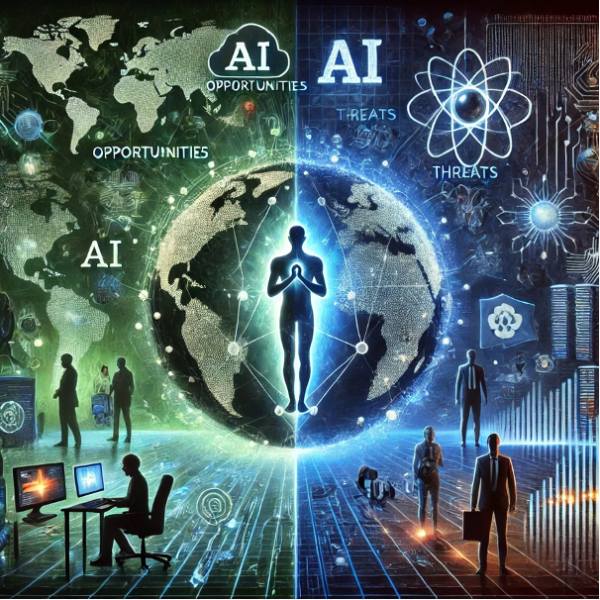
Opportunities
- Specialized assistive technologies for professionals (financialanalysts, lawyers, etc.) within the next 18-24 months.
- AIlocalization: deviceswithembedded AI capable of operatingautonomously.
- Stimulating energy efficiency and the transition to alternativeenergy sources.
- Development of open AI models, reducing the cost of technology adaptation.
- Hardware innovations: neuro- symbolic AI and specialized chips.
Threats
- Risk of achieving goals through erroneous or malicious methods.
- Commoditization of AI models, threatening the uniqueness of startups.
- Ethical and legal issues related to the use of biometrics and behavioral analysis.
- Economic protectionism, limiting access to talent and disrupting supply chains.
- Vulnerability of high-performance models to hacking and manipulation.
The technological race for AI and chip development supremacy, led by the US and China, has a profoundimpact on national security, global cooperation, and innovation. In the next five years, we will witness an unprecedented transformation of all industries under the influence of AI. Companies and organizations needto be prepared for these changes by investing in AI technologies and adapting their business models to the newreality.
Strategic Investments and Actions in the AI Era
Developing a national talent pool
Creating internship and apprenticeship programs
- Developing national programs to build a talent pool in the AI field
- Collaborating with educational institutions to train specialists in strategically important areas
Green infrastructure for AI
Investing in green data centers
- Developing data centers powered by renewable energy sources
- Exploring partnerships in alternative energy (nuclear, geothermal)
- Aligning AI operations with ESG goals
- Reducing carbon footprint and computational costs
Overcoming the computing power shortage:
Addressing the GPU shortage
- Finding alternatives to dominant suppliers (Nvidia)
- Investing in developing own capacities by cloud companies
Investing in alternative computing architectures
- Developing neuro-symbolic AI
- Implementing in-memory data processing technologies
- Developing specialized AI chips for local processing
Using open models and developing SLMs
- Adapting open models (LLaMA, FLAN) to create industry-specific solutions
- Researching and implementing small language models (SLMs) for edge devices
Key Trends and Challenges
New data sources
- Integrating wearable devices with sensors to collect contextual data
- Developing AI algorithms to process and interpret large volumes of data
Geopolitical competition in AI
- Investments in chip manufacturing and AI research at the national level
- Considering ideological aspects when developing AI strategies
Chip shortage threat
- Finding effective alternatives to traditional GPUs
- Investing in the development of new types of chips (e.g., OpenAI initiative)
Choosing between proprietary and open-source solutions
- Evaluation of the advantages and risks of using open source code
- Balancing the benefits and risks of using open source code
Management in Conditions of Polarized Opinions
- Critical assessment of both utopian and dystopian AI development scenarios
- Focus on constructive dialogue and active measures
Shifting the Center of Innovation to Industry
- Taking into account the growing role of industry in AI development
- Supporting academic research to maintain balance in the AI ecosystem
Counteracting Increased Global Inequality
- Developing strategies to overcome resource imbalances in AI development
- Finding ways to include developing countries in the global AI ecosystem
NOTABLE LEADERS IN TECHNOLOGY FIELDS WHOSE WORK DESERVES ATTENTION
KEY FIGURES IN BIOTECHNOLOGY AND BIOENGINEERING RESEARCH
Abbott, Chris - CEO of Pivot Bio, recognized for scaling sustainable biotechnological solutions to address global agriculturalchallenges.
Afeyan, Noubar - CEO of Flagship Pioneering, known for inventing and creating platform companies with the potential to transform humanand planetary health.
Aitamurto, Tanja - Researcher at Stanford University, focusing on ethics and cybersecurity in bioengineering.
Arnold, Frances - Nobel laureate celebrated for developing methods of directed protein evolution.
Bao, Zhenan - Professor at Stanford University, recognized for advancing biocompatible materials and electronic skins.
Barrangou, Rodolphe - Professor at North Carolina State University, noted for his research on CRISPR and its applications in the foodindustry.
Barron, Hal; Klausner, Dr. Rick; and Bishop, Hans - Founders of Altos Labs, leading groundbreaking efforts in cellular rejuvenation toreverse human aging.
Bayer, Eben - Co-founder and CEO of Ecovative, innovating with mycelium technology in food and material production.
Belcher, Angela - Professor at MIT, pioneering the use of biological systems for creating new materials.
Bin, Dror - CEO of the Israel Innovation Authority, scaling resources for innovation in biotechnology and other critical technologies.
Birney, Ewan - Deputy Director of the European Molecular Biology Laboratory (EMBL-EBI), contributing to genomic data research.
Blaser, Martin - Professor at Rutgers University, acclaimed for exploring the microbiome's impact on human health.
Chakrabarti, Gaurab - CEO of Solugen, transforming the chemical industry with decarbonization efforts. Clevers, Hans - Professor at UtrechtUniversity, a pioneer in organoid technologies.
Cui, Cheryl - CEO of Bota Biosciences, leading efforts in biological programming and discovery engines. Cui, Yi - Professor at StanfordUniversity, focusing on novel biomaterials for medical devices.
Darrell, Trevor - Professor at UC Berkeley, researching AI applications in bioengineering.
Deshaies, Raymond - Senior Vice President of Global Research at Amgen, advancing small molecule design through RNA degradation.
Doudna, Jennifer - Founder and Chair of the Board of the Innovative Genomics Institute, envisioning genetic therapies accessible to all.
Dyson, Lisa - Founder and CEO of Air Protein, developing food products derived from carbon dioxide. Charpentier, Emmanuelle - Co-developer ofCRISPR-Cas9 technology and Nobel laureate.
Esteva, Andre - Researcher at Stanford University, applying AI in molecular biology.
Fang, Jianmin - Co-founder and CEO of RemeGen, spearheading one of the largest partnerships between a Chinese biotech firm and a Westerncompany (Seagen).
Goldman, Nick - Researcher at EMBL-EBI, innovating in DNA data storage methods.
Gupta, Niyati - CEO of Fork & Good, advancing and scaling new business models in food and agriculture.
Hartung, Thomas - Professor at Johns Hopkins University, known for developing organoid system testing methods.
Hassabis, Demis, and Legg, Shane - Co-founders of DeepMind, revolutionizing AI for predicting biological structures and interactions.
Kelly, Jason - Co-founder and CEO of Ginkgo Bioworks, scaling genetic engineering for diverse bacterial applications.
Leproust, Emily - CEO of Twist Bioscience, driving innovation in high-throughput DNA synthesis and sequencing.
Levin, Arthur - Distinguished scientist at Avidity Biosciences, developing a novel RNA platform to deliver therapies to previously inaccessibletissues and cell types.
Lewis, Jennifer - Professor at Harvard University, innovating in 3D bioprinting of tissues and organs.
Ley, Ruth - Director of Microbiome Research at the Max Planck Institute, studying the microbiome's role in metabolism.
Lindahl, Erik - Professor at KTH Royal Institute of Technology, advancing algorithms for genomic sequence analysis.
Lipson, Hod - Professor at Columbia University, researching autonomous biorobotics.
Maxon, Mary - Executive Director of BioFutures at Schmidt Futures, designing programs to maximize biotechnology's potential for a circularbioeconomy.
McKnight, Matthew - General Manager of Biosecurity at Ginkgo Bioworks, promoting biotechnology for national security, public health, andpandemic preparedness.
Pandya, Ryan - Co-founder of Perfect Day, innovating in cultivated dairy products.
Post, Mark - Researcher and professor at Maastricht University, recognized for creating the first cultivated muscle tissue and leadingstudies in cultivated food.
Reisinger, Sarah - Chief Scientific and Research Officer at DSM-Firmenich, bridging research, technical requirements, andcommercialization.
Shu, Will - Professor at the University of Strathclyde, exploring microfluidic systems and 3D bioprinting.
Smith, Kimberly - Head of R&D at ViiV Healthcare, driving innovative clinical practices to end the HIV epidemic.
Sonnenburg, Justin - Professor at Stanford University, studying the gut microbiome. Sternberg, Sam - Professor at Columbia University, researching CRISPR and RNA editing.
Tetrick, Josh - Co-founder and CEO of Eat Just, commercializing cultivated meat in the US and Singapore.
Toubia, Didier - CEO and co-founder of Aleph Farms, achieving the first government approval for cultivated beef production and sale.
Trejo, Amy - Director of R&D and Responsible Innovation at Procter & Gamble, leveraging bioengineering for sustainability in consumergoods.
Valeti, Uma - Founder and CEO of Upside Foods, contributing to cultivated meat production.
Venter, J. Craig - CEO of JCVI and serial entrepreneur, advancing synthetic biology and genomic research. Wood, Robert - Professor atHarvard University, developing soft robotics and bioinspired systems.
Xu, Guo-Liang - Professor at the CAS Institute of Biophysics, researching organoids and biocomputers.
Ye, Yin - CEO of BGI Group, scaling industrial applications of advanced biotechnologies and genomics research.
KEY PEOPLE IN MEDICAL AND HEALTHCARE RESEARCH
Anderson-Baron, Matt - CEO and co-founder of Future Fields, for creating the first synthetic biology system using fruit flies to produceproteins for affordable CRISPR therapies.
Anderson, Ross - Professor at Cambridge University, for his work in the areas of cybersecurity and privacy in healthcare.
Baker, David - Director of the Institute for Protein Design at the University of Washington, for developing an AI that can designcustomized functional proteins for production in living cells.
Band, Noam - CEO of HealthWatch, for developing the only wearable remote monitoring device to receive FDA approval.
Barnham, Kevin - Professor at the Florey Institute and Austin Health, for developing a method for early detection of Parkinson's disease beforephysical symptoms appear.
Cauwenberghs, Gert - Professor at the University of California, San Diego, for developing 3D-printed sensors that can be integrated withheadphones to detect neurodegenerative diseases.
Charpentier, Emmanuelle - Nobel laureate, for discovering the CRISPR-Cas9 technology.
Church, George - Professor at Harvard University, for contributions to genomic research and the use of CRISPR for molecular diagnostics.
Curtis, Mike - President and CEO of eGenesis, for advancing xenotransplantation research.
Doudna, Jennifer - Founder and Chairman of the Board, Innovative Genomics Institute, with a vision to make genetic therapies accessible to all.
Gazda, Elizabeth - CEO of Embr Labs, for developing a wristband that cools the body to combat hot flashes during menopause.
Ghaffari, Roozbeh - Professor at Northwestern University, for their research in biosensors and wearable devices.
Goldberg, Marc and Carville, Christine - Co-founders of Resilience Lab, for developing a sustainable model for expanding access totherapies through their online platform.
Hofbauer, Lorenz, Pisabarro, Maria Teresa and Hintze, Vera - Professors at TU Dresden, for developing molecules that promote bone regeneration.
Huang, Jinbo - Molecular biologist at ETH Zürich, for developing a device that can activate genes using electrical currents, for example to triggerinsulin production.
Hubbell, Jeffrey - Professor at the University of Chicago, for developing a vaccine that could reverse autoimmune diseases such as multiplesclerosis.
June, Carl - Professor at the University of Pennsylvania, for bringing CAR-T cell therapy and genome editing technologies to diagnosis andtreatment.
Karikó, Katalin - Researcher of mRNA technologies used in COVID-19 vaccines.
Kim, Tae-Jin - Associate Professor, Pusan National University, for developing a biosensor to detect DNA damage in real time.
Knight, Rob - Professor, University of California San Diego, for pioneering research into the human microbiome.
Knight, Robert - Neuroscientist, University of California Berkeley, for training a computer to analyze brain activity and play a song a personwas listening to.
Koller, Daphne - Co-founder of Insitro, for developing AI platforms to accelerate drug discovery.
Li, Fei-Fei - Professor, Stanford University, for their contributions to computer vision and the use of AI in medical diagnostics.
Liu, David - Professor, Harvard University, for inventing basic genome editing.
Marks, Debora - Professor, Harvard Medical School, for developing an AI tool that can predict virus mutations.
McAlpine, Michael - Professor at the University of Minnesota, for innovations in 3D-printed implants and wearable medical devices.
Mendiratta-Lala, Mishal - Professor of Radiology at Michigan Medicine, for leading a clinical trial using sound to destroy liver tumors.
Mirkin, Chad - Professor at Northwestern University, for developments in nanomedicine and diagnostic nanomaterials.
Nie, Zhou - Professor at Hunan University, for developing a DNA robot that can move along the surface of cells and influence their behavior.
O’Malley, Michelle - Professor at the University of California Santa Barbara, for research into microbial communities for use in medicine.
Oprea, Alina - Professor at Northeastern University, for research into cybersecurity and the protection of medical data.
Parviz, Babak - Creator of Google Glass, for developments in wearable technology for medical applications.
Robb, Nicole, - Co-founder of Pictura Bio, for creating a digital image-based diagnostic platform for detecting pathogens in less than a minute.
Roche, Philip, - CEO of Jenthera Therapeutics, for developing a CRISPR-based gene therapy using fruit fly proteins.
Rogers, John A. - Northwestern University researcher, for developing an electromechanical system that dissolves after a period of time andreduces electronic waste.
Rothenberg, Ellen - Professor at Caltech, for developing methods for analyzing the early development of the immune system.
Sanghamitra, Nusrat J M - Founder and CEO, CyGenica, for using nanotechnology to target cancer drugs with minimal side effects.
Takagi, Yu, and Nishimoto, Shinji - esearchers at Osaka University, for their use of diffusion models to recreate versions of what a person saw byanalyzing fMRA scans.
Topol, Eric - Director, Scripps Research Translational Institute, for their research into personalized medicine and the use of AI to analyzehealth data.
Yamanaka, Shinya - Nobel laureate, for the discovery of induced pluripotent stem cells and their application to regenerative medicine.
Yeo, Woon-Hong - Researcher, Georgia Institute of Technology, for creating a device for wireless, real-time monitoring of the vascularsystem without the need for batteries or circuits.
Zhang, Feng - Professor, Broad Institute, for developing genome editing techniques and their application to medicine.
Zhang, Zhuomin - PhD student, City University of Hong Kong, for developing a piezoelectric biomolecular film for use in implantable microdevices.
Zoghbi, Huda - Professor, Baylor College of Medicine, for research into neurological diseases and the use of genetic approaches to developnew treatments.
NEUROSCIENCE AND ARTIFICIAL INTELLIGENCE FOR MENTAL HEALTH
Marjorie Xie - AI & Society Postdoctoral Research Fellow at the New York Academy of Sciences, Neuroscientist developing AI systems for mental health treatment, focusing on computational models of attention and mood regulation
Angela Radulescu - Researcher at Mt. Sinai Center for Computational Psychiatry, studying how people learn from interaction with theirenvironment and its impact on mental health
Xiaosi Gu - Researcher at Mt. Sinai Center for Computational Psychiatry, examining neural and computational mechanisms of human beliefs, decision making, and social interaction in health and disease
Paris Alexandros Lalousis - Lecturer in Artificial Intelligence in Mental Health at King’s College London, using AI methods to integratemultimodal data for understanding disease processes in mental illness
Nikolaos Koutsouleris - Chair of Precision Psychiatry at King’s College London, advancing the use of multivariate pattern recognitionmethods for diagnostic and prognostic prediction models in early stages of psychoses
Kenneth Miller - Cofounder of the Zuckerman Institute’s Center for Theoretical Neuroscience, using theoretical methods to understandneural circuits and their function and development
Richard Zemel - Director of Columbia’s AI Institute for Artificial and Natural Intelligence (ARNI), focusing on systems that learn useful representations of data with little supervision and algorithms for fair and robust machine learning
Nikolaus Kriegeskorte - Computational neuroscientist and co-founder of the Cognitive Computational Neuroscience conference
Karan Singh - CEO of Ginger (now part of Headspace), developing a mental health technology platform for anxiety, stress, anddepression management
Russell Glass - CEO of Ginger (now part of Headspace), leading the development of on-demand mental health support throughcoaching, therapy, and psychiatry
April Koh - Founder of Spring Health, focusing on precision mental health care and connecting individuals with personalized caresolutions
Adam Chekroud - Founder of Spring Health, developing data-driven approaches to improve mental health diagnosis and treatment
These individuals are at the forefront of integrating AI and neuroscience to advance mental health treatment and research.
LEADERS IN ARTIFICIAL INTELLIGENCE
Altman, Sam OpenAI - Researcher in generative AI and AI ethics
Amodei, Dario and Amodei, Daniela CEO and president of Anthropic, leaders of one of the leading AI laboratories
Aschenbrenner, Leopold AI alignment researcher at OpenAI, expert in AI alignment
Bengio, Yoshua Mila - Quebec AI Institute - Researcher in deep learning and neural networks Burgard, Wolfram University of Freiburg -Researcher in robotics and AI
Dean, Jeff Google AI - Developer of large-scale machine learning systems
Delangue, Clément CEO and co-founder of Hugging Face, developer of an open-source machine learning platform with a commercial model
Fang, Ruogu tenured Associate Professor and Pruitt Family Endowed Faculty Fellow in the J. Crayton Pruitt Family Department ofBiomedical Engineering at the University of Florida
Gomez, Aidan CEO and co-founder of Cohere, creator of transformer technology, which became the basis of generative AI
Goodfellow, Ian DeepMind - Developer of generative adversarial networks (GANs)
Hassabis, Demis DeepMind - Researcher in neuroscience and AI, developer of technologies for scientific discovery
Hinton, Geoffrey University of Toronto - Founder of deep learning, researcher of neural networks
Huang, Jensen CEO, president, and co-founder of Nvidia, a key figure in the geopolitical conflict over AI chips Ibrahim, Lila COO of GoogleDeepMind, leader in responsible AI
Jingren, Zhou deputy director of Alibaba Damo Academy (Alibaba’s bleeding-edge research arm), head of AI initiatives in various applied areas
Kang, Daniel assistant professor at University of Illinois Urbana-Champaign, researcher of risks associated with language models andmethods for safe AI development
Karpathy, Andrej former Tesla, OpenAI - expert in computer vision and deep learning Krier, Sebastien international policymanager at DeepMind, expert on AI policy Kurzweil, Ray Google - Futurist, researcher of long-term prospects for AIdevelopment
LeCun, Yann Meta - Pioneer in deep learning, developer of convolutional neural networks
Lehmann, Sune professor at the Technical University of Denmark, expert on the predictive capabilities of AI Li, Fei-Fei Stanford University -expert in computer vision and AI, popularizer of AI education
Li, Robin CEO, chairman and co-Founder of Baidu, creator of the Chinese analogue of ChatGPT - Ernie Bot
Mehrotra, Prakhar vice president for applied AI at Walmart Global Tech, expert in AI implementation in corporate processes
Mensch, Arthur, Lample, Guillaume, and Lacroix, Timothée co-founders of European generative AI upstart Mistral AI
Ng, Andrew Stanford University, DeepLearning.AI - expert in machine learning, founder of AI educational platforms
Nippa, David doctoral student at Ludwig-Maximilians-Universität München, developer of AI for predicting chemical changes in drugs
Pineau, Joelle vice president of AI research at Meta, developer of models for planning and learning in complex environments
Raibert, Marc executive director at Boston Dynamics AI Institute, developer of «thinking» robots based on AI
Rolnick, David assistant professor of computer science at McGill University, researcher of the relationship between AI and greenhouse gasemissions
Schölkopf, Bernhard Max Planck Institute for Intelligent Systems - expert in machine learning and statistics
Sivasubramanian, Swami vice president of database, analytics, and machine learning at Amazon Web Services, leader in the development of cloud AIsolutions
Solano, Miguel co-founder and CEO of VMind, innovator in AI computation optimization on GPUs Suleyman, Mustafa Microsoft AI - researcher ofethical aspects of AI
Teevan, Jaime chief scientist and technical fellow at Microsoft, integrator of language models into products to increase productivity
Wang, Xin (Eric) Assistant Professor of Computer Science and Engineering at the University of California, Santa Cruz (UC Santa Cruz), developer of atool for measuring bias in text-to-image conversion models
Zhang, Ning assistant professor of computer science and engineering at Washington University, creator of AntiFake to prevent unauthorized speechsynthesis
These individuals represent key players in various aspects of AI development and application, from fundamental research to practicalimplementation and ethical considerations. Their work shapes the future of artificial intelligence and its impact on society.
KEY PEOPLE IN CLIMATE CHANGE MITIGATION, GEOENGINEERING, AND RENEWABLE ENERGY INFRASTRUCTURE
David Keith - Professor at Harvard University, known for research on solar geoengineering Ken Caldeira - Senior Scientistat Carnegie Institution for Science, studies geoengineering
Janos Pasztor - Executive Director of the Carnegie Climate Governance Initiative, focuses on geoengineering governance
Margaret Leinen - Director of Scripps Institution of Oceanography, researches ocean iron fertilization
Klaus Lackner - Director of Center for Negative Carbon Emissions at Arizona State University, works on carbon capture
Audrey Zibelman - Former CEO of Australian Energy Market Operator, expert on smart grids Yet-Ming Chiang - Professor at MIT,develops advanced battery technologies
Donald Sadoway - Professor at MIT, innovator in grid-scale energy storage
Ramez Naam - Co-Chair for Energy and Environment at Singularity University, clean energy futurist Christoph Frei - Former SecretaryGeneral of World Energy Council, expert on energy transitions
This list includes researchers, academics, and industry leaders working on various aspects of climate change mitigation and renewable energytechnologies mentioned in the text.
LEADERS IN ELECTRIC VEHICLES, AUTONOMOUS TRANSPORTATION, AND ROBOTICS
Elon Musk - Founder and CEO of Tesla, leading innovator in electric vehicles and autonomous driving technology
Mary Barra - CEO of General Motors, overseeing the company’s transition to electric and autonomous vehicles
Herbert Diess - Former Chairman of the Board of Management at Volkswagen Group, influential in the company’s EV strategy
RJ Scaringe - Founder and CEO of Rivian Automotive, developing electric trucks and SUVs William Li - Founder and CEO of Nio,innovating in EV technology and battery swapping
Rodney Brooks - Co-founder of iRobot and Rethink Robotics, pioneer in robotics and artificial intelligence Marc Raibert - Founder ofBoston Dynamics, developing advanced robots for various applications Melonee Wise - CEO of Fetch Robotics, innovating in autonomousmobile robots for logistics
Sebastian Thrun - CEO of Kitty Hawk, working on autonomous aerial vehicles and former leader of Google’s self-driving car project
Chris Urmson - Co-founder and CEO of Aurora, developing self-driving technology
These individuals are at the forefront of developing and implementing technologies related to electric vehicles, autonomoustransportation systems, and robotics across various industries.
KEY PEOPLE IN AI-DRIVEN HUMAN-COMPUTER INTERACTION AND RELATED AREAS
Fei-Fei Li - Professor at Stanford University, known for her work in computer vision and AI
Andrew Ng - Co-founder of Coursera and former head of Google Brain, expert in machine learning and AI Demis Hassabis - Co-founder and CEO ofDeepMind, leading research in AI and neural networks
Yann LeCun - Chief AI Scientist at Meta, pioneer in deep learning and computer vision
Mike Davies - Director of Intel’s Neuromorphic Computing Lab, working on brain-inspired AI hardware Cynthia Breazeal - Professor at MIT, pioneerin social robotics and human-robot interaction
Elizabeth Churchill - Professor of Human-Computer Interaction at MBZUAI, expert in UX and AI
Jeff Dean - Head of Google AI, leading research in machine learning and natural language processing Rana el Kaliouby - Co-founder and CEO ofAffectiva, specializing in emotion recognition AI
Yoshua Bengio - Professor at University of Montreal, known for his work in deep learning and neural networks
These individuals have made significant contributions to various aspects of AI and human-computer interaction mentioned in the text,including natural language processing, computer vision, brain- inspired computing, and AI-driven user interfaces.
LEADERS IN AUGMENTED AND VIRTUAL REALITY TECHNOLOGIES
Tim Cook - CEO of Apple, overseeing the development and launch of Apple Vision Pro Mike Rockwell - Head of Apple’sTechnology Development Group, leading AR/VR initiatives Jony Ive - Former Chief Design Officer at Apple, involved in earlyAR/VR development
Jeff Norris - AR/VR expert and former NASA specialist, hired by Apple
Geoff Stahl - Senior engineering manager at Apple, leading visionOS development Peter Meier - Co-founder of Metaio,acquired by Apple for AR technology
Fletcher Rothkopf - Apple Watch manager involved in AR/VR development Jon Favreau - Director enlisted by Apple tocreate content for Vision Pro
Mark Zuckerberg - CEO of Meta (formerly Facebook), driving AR/VR development with Meta Quest Satya Nadella - CEO of Microsoft,overseeing HoloLens development
These individuals have played significant roles in shaping the current landscape of AR/VR technologies and driving innovation in thefield.
LEADERS IN SPACE EXPLORATION, COMMERCIALIZATION, AND RESEARCH
Elon Musk - Founder and CEO of SpaceX, pioneering reusable rocket technology Jeff Bezos - Founder of Blue Origin,focusing on space tourism and lunar exploration Peter Beck - Founder and CEO of Rocket Lab, specializing in small satellitelaunches Sarah Amiri - Chair of the UAE Space Agency, leading emerging space programs
K. Sivan - Former Chairman of the Indian Space Research Organisation (ISRO)
Etienne Schneider - Former Deputy Prime Minister of Luxembourg, instrumental in developing the country’s space program
Greg Wyler - Founder of OneWeb, working on satellite internet constellations
Will Bruey - Co-founder of Varda Space Industries, pioneering space manufacturing
Delian Asparouhov - Co-founder of Varda Space Industries, focusing on microgravity research
Gen. Michael Guetlein - Vice Chief of Space Operations for the U.S. Space Force, advancing international collaboration in space
These individuals represent a mix of entrepreneurs, government officials, and military leaders who are shaping the new era of space exploration andutilization.
KEY PEOPLE IN FINANCIAL TECHNOLOGY AND INNOVATION
Emilie Choi - President and COO of Coinbase, leading cryptocurrency exchange Nik Storonsky - Founder and CEO ofRevolut, digital banking pioneer
John Collison - Co-founder and President of Stripe, e-commerce payments innovator Samantha Ku - COO of Square,advancing payment solutions
TS Anil - Global CEO of Monzo Bank, challenger bank leader
Anna Maj - Senior Advisor for Truffle Capital, expert in open banking and AI Matteo Rizzi - Co-founder of FinTechStage.com, fostering global fintech innovation Dan Schulman - CEO of PayPal, revolutionizing digital payments
Sebastian Siemiatkowski - CEO and Co-Founder of Klarna, payments and banking services innovator Anthony Noto - CEO of SoFi, leadingdigital financial services company
These individuals are at the forefront of driving innovation in open banking, digital identity, blockchain, and other transformativetechnologies in the financial sector.
KEY PEOPLE IN LOGISTICS AND SUPPLY CHAIN MANAGEMENT
Tim Cook - CEO of Apple, known for his expertise in supply chain management
Mary Barra - CEO of General Motors, with experience in global supply chain operations
Brian Cornell - CEO of Target Corporation, with over 35 years of experience in retailing and supply chain management
Doug McMillon - CEO of Walmart, with significant experience in retail supply chain operations
Alan Mulally - Former CEO of Ford Motor Company, credited with implementing new logistics and supply chain management strategies
David Taylor - Former CEO of Procter & Gamble, who began his career as a supply chain management trainee
AG Lafley - Former CEO of Procter & Gamble, known for leading P&G’s supply chain transformation
Lora Cecere - Founder of Supply Chain Insights, with over 30 years of experience in supply chain management
Craig Fuller - CEO and founder of FreightWaves, focusing on transportation and supply chain analytics
Jim Tompkins - Founder of Tompkins Ventures and Tompkins Leadership, with over 50 years of experience in supply chainmanagement
These individuals have played significant roles in shaping modern supply chain strategies and addressing the challenges faced by theindustry.
KEY PEOPLE IN HOSPITALITY TECHNOLOGY AND INNOVATION
Tim Cook - CEO of Apple, known for contactless payment technologies Moneesh Arora - Quoted expert onhospitality technology
Raymond Boyle - Vice President of Data and Analytics at Hyatt Hotels Corporation Connie - AI-powered virtual assistantat Hilton hotels
Greg Wyler - Founder of OneWeb, working on satellite internet for hotels Nik Storonsky - Founder and CEOof Revolut, digital banking pioneer
John Collison - Co-founder and President of Stripe, e-commerce payments innovator Dan Schulman - CEO of PayPal,revolutionizing digital payments
Sebastian Siemiatkowski - CEO and Co-Founder of Klarna, payments and banking services innovator Anthony Noto - CEO of SoFi, leading digitalfinancial services company
These individuals are at the forefront of developing and implementing technologies related to contactless payments, personalized guestexperiences, and automation in the hospitality industry.
LEADERS IN SPORTS TECHNOLOGY AND INNOVATION
Prof. Dr. Daniel Memmert - Managing Director and Professor at the Institute for Training Science and Sports Informatics, German SportUniversity Cologne
Alexander Will - CEO and founder of IMPROVR GmbH, developing VR-based training solutions for athletes
Lars Lienhard - Sports scientist and neuroathletics trainer, collaborating on Brain-Based Performance products
Moneesh Arora - Expert on sports technology integration
Raymond Boyle - Vice President of Data and Analytics at Hyatt Hotels Corporation, applying data analytics to sports hospitality
Greg Wyler - Founder of OneWeb, working on satellite internet for smart stadiums
These individuals are at the forefront of developing and implementing technologies related to sports analytics, mixed reality training, AI-driven performance analysis, and fan engagement strategies in the sports industry.
LEADERS IN AI-DRIVEN ENTERTAINMENT TECHNOLOGY AND INNOVATION
Moneesh Arora - Expert on AI integration in entertainment technology
Raymond Boyle - Vice President of Data and Analytics at Hyatt Hotels Corporation, applying data analytics to entertainment experiences
Andrey Kazakevich - Head of Production at HQSoftware, focusing on VR and AR technologies Tim Cook - CEO of Apple, overseeingdevelopment of AR and AI technologies
Mark Zuckerberg - CEO of Meta, driving development in VR and AR for entertainment Satya Nadella - CEO of Microsoft, leading AIand cloud computing initiatives
Jensen Huang - CEO of NVIDIA, developing AI and graphics technologies for entertainment
Reed Hastings - Co-founder and Executive Chairman of Netflix, pioneering AI-driven content personalization
Bob Chapek - Former CEO of Disney, integrating AI into theme parks and content creation Lisa Su - CEO of AMD,developing processors for AI and gaming applications
These individuals are at the forefront of developing and implementing AI technologies that are transforming the entertainmentindustry, from content creation to personalized experiences and immersive technologies.
KEY PEOPLE IN AI-DRIVEN TRANSFORMATION IN THE INFORMATION AND MEDIA INDUSTRY
Moneesh Arora - Expert on AI integration in media and entertainment technology
Will McKeon-White - Senior analyst at Forrester, researching generative AI adoption trends in media and entertainment
Vered Horesh - Chief of AI Strategic Partnerships at Bria AI, focusing on AI-driven content creation and attribution
Victoria Milo - SVP of Media Solutions & Emerging Technologies at Monks, implementing AI in media campaigns
Travis Couture - Founding Solutions Architect at Twelve Labs, developing AI for video understanding and content discovery
Ted Sarandos - CEO of Netflix, pioneering the use of AI for content production decisions
Andrew Au - Managing Partner at Intercept, expert in AI integration for B2B marketing in the tech sector
Jessica Hreha - Head of Marketing AI Strategy and Transformation at Jasper, leading AI adoption in marketing teams
Amanda Todorovich - Executive Director of Digital Marketing at Cleveland Clinic, leveraging AI for content marketing in healthcare
Dan Slagen - CMO at Tomorrow.io, implementing AI in go-to-market strategies across various industries
These individuals are at the forefront of implementing AI technologies in media, marketing, and information industries, driving innovation incontent creation, distribution, and personalization.
KEY PEOPLE INVOLVED IN AI’S IMPACT ON WORK, LABOR MARKETS, AND SOCIETY
Carl Benedikt Frey - Economist known for research on AI’s impact on employment
Michael A. Osborne - Co-author with Frey on influential studies about AI and job automation Daron Acemoglu - Economist studying theeffects of AI on labor markets and economic growth Pascual Restrepo - Collaborator with Acemoglu on AI and labor market research
Erik Brynjolfsson - Professor studying the economics of AI and digital transformation Andrew McAfee - Research scientistfocusing on how AI affects business and employment Kai-Fu Lee - AI expert and author on AI’s societal impacts
Rowan Barnett - Director at Google.org, involved in AI skills training initiatives
Njideka U. Harry - Founder of Youth for Technology Foundation, working on digital skills development Jonathan Jackson - Founder of Dimagi, applyingAI in healthcare and social impact
Daniel Susskind - Economist and author on the future of work in the age of AI Katarina Milanovic - Research Assistantstudying AI’s effects on labor markets
These individuals are at the forefront of research, policy-making, and practical implementation of AI in various sectors, addressing itsimpact on work, society, and the search for meaning in the AI era.
LEADERS IN THE AREA OF AI FOR ADDRESSING GLOBAL CHALLENGES, PARTICULARLY POVERTY AND ECONOMIC INEQUALITY:
Francisco Ferreira - Amartya Sen Professor of Inequality Studies at the London School of Economics and director of the InternationalInequalities Institute
Marshall Burke - Scholar at Stanford University, working on using AI and satellite imagery to track poverty in Africa
David Lobell - Professor at Stanford University, collaborating on AI-based poverty tracking tools
Stefano Ermon - Researcher at Stanford University, involved in developing AI tools for poverty measurement
António Guterres - UN Secretary-General, advocating for AI use in climate action and sustainable development
David Autor - MIT economist studying AI’s impact on labor markets and inequality
Tyna Eloundou - Researcher studying AI’s impact on labor productivity across the economy Daniel Rock - Researcher examining AI’s effects on worker productivity and income distribution Pamela Mishkin - Researcher investigating AI’s influence on economicoutcomes and inequality Anton Korinek - Expert on AI’s economic impacts and policy implications
These individuals are at the forefront of research, policy-making, and practical implementation of AI technologies to address global challengeslike poverty and inequality.
LEADERS IN AI GOVERNANCE, DEMOCRACY, AND INTERNATIONAL SECURITY:
Eva Erman - Professor and project manager at Stockholm University, researching global AI governance Niklas Möller - Professor atStockholm University, working on AI governance and democracy
Markus Furendal - Researcher at Stockholm University, studying AI governance
Mary Robinson - Former President of Ireland and Chair of The Elders, advocating for AI governance
Ban Ki-moon - Former UN Secretary-General and Deputy Chair of The Elders, involved in AI governance discussions
Graça Machel - Co-founder and Deputy Chair of The Elders, contributing to AI governance debates António Guterres - UN Secretary-General,leading initiatives on AI governance
Daniel Innerarity - Professor at EUI School of Transnational Governance, researching AI and democracy
Ioannis Galariotis - Researcher at School of Transnational Governance, studying AI’s impact on democracy
Francisco Ferreira - Professor of Inequality Studies at the London School of Economics, examining AI’s role in addressing global challenges
These individuals are at the forefront of research, policy-making, and advocacy related to AI governance, its impact on democracy, andits potential for addressing global challenges.
CONCLUSION
The contemporary world stands on the brink of fundamental changes driven by the rapid development ofartificial intelligence (AI) and biotechnology. These innovations encompass all spheres of life—fromeconomics and healthcare to ecology, production, and everyday life.
- Artificial Intelligence as a Catalyst for Transformation AI serves as a key driver of progress, accelerating scientific research, improving industry efficiency, and opening up new horizons. Thedevelopment of generative models, wearable devices, and cloud infrastructure is shaping the technological ecosystem of the future. At the same time, questions of ethics, accessibility, andtechnology safety become central to sustainable development.
- Biotechnological Revolution Breakthroughs in gene editing (CRISPR), bioprinting, organoids, andsynthetic biology are changing the approach to treating diseases and extending life. New technologies allow not only to conquer chronic illnesses but also to improve quality of life through personalized medical solutions and regenerative medicine.
- Medicine and Healthcare The integration of digital technologies into healthcare opens the era ofpersonalized medicine and remote patient monitoring. The application of nanotechnology, XR solutions, and innovative interfaces makes diagnostics and treatment more accurate and accessible. However,digitalization requires enhanced data protection and overcoming social inequalities.
- Global Challenges and Opportunities Technological progress brings not only prospects but also challenges—from climate change to cyber threats and social inequality. Sustainable development, adaptation of labor markets, and the formation of ethical standards become priorities for the global community. The synergy of artificial intelligence and biomedicine shapes a future where solutions to combat diseases,global crises, and social problems become more accessible than ever before. However, the success of thistransition depends on the responsible implementation of innovations, strategic investments, and globalcooperation. A balanced approach will not only overcome current challenges but also ensure sustainabledevelopment and a new quality of life for humanity.
Against the backdrop of the rapid development of AI, a vision of the future has formed in society that is bothambitious and realistic. This vision, although it may seem radical to many, is a logical continuation of basichuman values and aspirations.
The main elements of this vision include:
- Victory over most diseases
- Expansion of human biological and cognitive freedom
- Lifting billions of people out of poverty
- Revival and strengthening of liberal democracy and human rights
Realizing this vision within the next 5-10 years may seem fantastic, but it is based on the fundamental principles of justice, cooperation, curiosity, and autonomy that are deeply rooted in human nature.
Experts note that this vision, although radical at first glance, actually represents a natural development of the ideals of the Enlightenment and democratic values. AI in this context is seen as a tool capable of accelerating humanity's movement towards these ideals.
However, realizing this vision is not inevitable. It will require significant effort and cooperation betweenvarious sectors of society, including technology companies, governments, and civil society. It will be necessarynot only to prevent potential risks associated with the development of AI but also to maximize its benefits for all of humanity.
Many experts emphasize that this vision of the future represents not just technological progress but also a deep moral and social transformation. It reflects the desire for a world in which technology serves to enhance the best aspects of human nature and society.
In conclusion, although the path to realizing this vision may be complex and uncertain, it represents agoal worthy of humanity's collective efforts. The opportunity to contribute to the creation of such a future is seen by many as a unique historical opportunity and a moral imperative of our time.
LIST OF SOURCES USED
The list of references is published here:
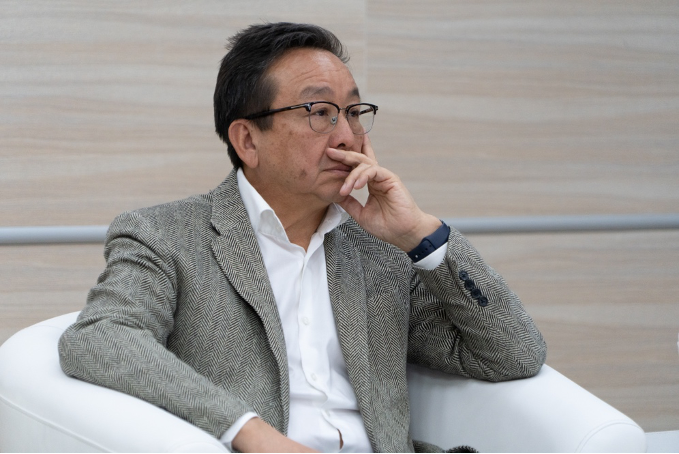
Almaz Sharman, Professor of Medicine
President of the Academy of Preventive Medicine and a member of the American Public Health Association, Dr.Sharman has 40 years of experience in biomedical science and public health. He has taught at Johns HopkinsUniversity in the United States and, in Kazakhstan, led the National Medical Holding and established an academic healthcare system. In recent years, his work has focused on developing preventive medicine and a digital health ecosystem. He has developed online resources and mobile applications on health, disease prevention, and treatmentfor adults and children, as well as the NutriSteppe and Balaman technologies for promoting healthy eating.
Dr. Sharman is the author of numerous scientific papers, including publications in leading medical journals such asThe Lancet and Nature. He has written a number of popular science books: "How to Effectively Manage Weight,Improve Your Health, and Prevent Diseases," "Healthy Eating," "Eight Secrets of Health: Confessions of a Modern Nomad," "Priorities," and "Quality of Life, Health, and Longevity."
Almaz Sharman hosts the health TV show "Almaz's Advice." He regularly publishes blogs and articles onTengrinews, Forbes, and other online publications.
Key Scientific Works
- Worldwide trends in diabetes prevalence and treatment from 1990 to 2022: a pooled analysis of 1108 population-representative studies with 141 million participants. Lancet. 2024 Nov 23;404(10467):2077-2093.
- General and abdominal adiposity and hypertension in eight world regions: a pooled analysis of 837 population-based studies with 7·5 million participants. Lancet. 2024 Aug 31;404(10455).
- Worldwide trends in underweight and obesity from 1990 to 2022: a pooled analysis of 3663 population-representative studies with 222 million children, adolescents, and adults. NCD Risk Factor Collaboration (NCD-RisC). Lancet. 2024.
- Global variation in diabetes diagnosis and prevalence based on fasting glucose and hemoglobin A1c. NCD Risk FactorCollaboration (NCD-RisC) Nature Medicine. 2023; 29(11): 2885–2901.
- Building a tuberculosis-free world: The Lancet Commission on tuberculosis. Lancet, Vol. 393, No. 10178, March 20,2019
- Levels and distribution of self-rated health in the Kazakh population: results from the Kazakhstan household health survey 2012. Supiyev A, Nurgozhin T, Zhumadilov Z, Sharman A, Marmot M, Bobak M. BMC Public Health. 2014 Jul30;14:768.
- A New Paradigm of Primary Health Care in Kazakhstan: Personalized, Community-based, Standardized, and Technology-driven. Sharman, A. Central Asian Journal of Global Health, 2014, Vol. 3, No. 1.
- Tuberculosis in Kazakhstan: analysis of risk determinants in national surveillance data. Terlikbayeva A, Hermosilla S, Galea S, Schluger N, Yegeubayeva S, Abildayev T, Muminov T, Akiyanova F, Bartkowiak L, Zhumadilov Z, Sharman A, El-Bassel N. BMC Infect Dis. 2012 Oct 18;12:262. doi: 10.1186/1471-2334-12-262.
- Modernization and growth in Kazakhstan (editorial) Sharman, A. Central Asian Journal of Global Health, 2012, Vol 1, No 1.
- The scientific basis for healthy aging and anti-aging processes (monograph). Mary Ann Liebert inc. Publishers, New York,2011.
- Reproductive, Maternal and Child Health in Eastern Europe and Eurasia: A Comparative Report. Atlanta, GA (USA) and Calverton, MD (USA). pp 155-163Dhs+: building the „h« in the demographic and health surveys. Almaz sharman. MeasureDHS+, ORC Macro, 2001.
- Anemia testing in population-based surveys. Measure DHS+. 2000.
- Anemia in Central Asia: demographic and health survey experience. Almaz Sharman. Food and Nutrition Bulletin, vol. 19, no.4, 1998
- Health care in Kazakstan. Sharmanov T, McAlister A, Sharmanov A. World Health Forum. 1996;17(2):197-9. PMID: 8936281.
- Hapten-induced model of murine inflammatory bowel disease: mucosa immune responses and protection by tolerance. ElsonCO, Beagley KW, Sharmanov AT, Fujihashi K, Kiyono H, Tennyson GS, Cong Y, Black CA, Ridwan BW, McGhee JR. J Immunol. 1996 Sep 1;157(5):2174- 85
- Differences in intraepithelial lymphocyte T cell subsets isolated from murine small versus large intestine. Beagley KW, Fujihashi K, Lagoo AS, Lagoo-Deenadaylan S, Black CA, Murray AM, Sharmanov AT, Yamamoto M, McGhee JR, Elson CO,et al. J Immunol. 1995 Jun 1;154(11)
- Hormone receptor assays and their value in breast cancer therapy. Gaffney EV, Sharmanov AT, Moody WE, Halpin DP, Blakemore WS, Elliott CB. Cancer Biother. 1993 Spring;8(1):17-28
